By the time of the Great War, Llanelli was a hugely industrious town, by far the largest in West Wales. Many men from all over Great Britain came here to work and live, and the population swelled. The Town therefore played a hugely important role in supplying recruits to all three services, army, navy and air force, as well as creating the backbone of several local units, the 15th Welsh (Carmarthen Pals), the 4th Welsh (Territorial), the Welsh Field Company, Royal Engineers (Territorial), and the Pembroke Yeomanry. As far as I know, there are no names on the main Llanelli War Memorial, so I have used the original Carmarthen County War Memorial roll as the basis for this page. Due to the large number of men commemorated here I have split the Llanelli WW1 page of the website into three, with surnames starting in alphabetical order: A to H; I to O; and P to Z.
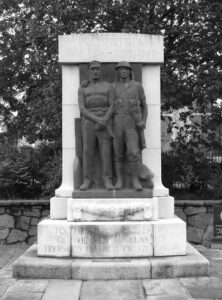
Llanelli War Memorial, The Great War, 1914-1918 (Surnames I to O)
David Luther Isaac, Private, 878, Welsh Regiment. David was the son of John and Mary Isaac, of 29, Glenalla Road, Llanelli. He enlisted at Llanelli into the 1/4th Battalion, Welsh Regiment, which was the local Territorial Battalion, attached to 159 Brigade, 53rd (Welsh) Division. The Division landed at Cape Helles, Gallipoli, on 9 August 1915, and was immediately thrown into action, spending the next few days in isolated pockets, fighting against a Turkish counter-attack during the Battle of Sari Bair. David was wounded in the right leg, and was evacuated to Hospital at Malta, where his leg was amputated. Sadly he died in hospital on 22 September 1915, aged 23, and is buried at Pieta Military Cemetery, Malta.
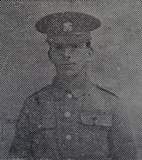
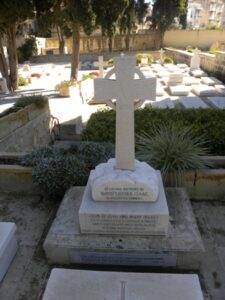
Charles Jacobs, Private, 38254, King’s Liverpool Regiment. Charles was the son of Arthur and Frances Jacobs, of 273, Great Homer Street, Liverpool. He worked at Llanelli prior to the war, and married Elizabeth Jane Thomas at Llanelli in September 1912. They set up home at 15, Mount Pleasant Buildings, Llanelli. Charles returned to Liverpool to enlist into the army at the outbreak of war, and was posted to the 1st Battalion, King’s Liverpool Regiment, which was in France attached to 6 Brigade, 2nd Division. In the summer of 1916 the Division were on the Somme, and took part in the Battle of Delville Wood and the Battle of the Ancre, and the ensuing Operations on the Ancre. In March 1917 the Division followed the German Retreat to the Hindenburg Line. Charles was killed here on 13 March 1917, aged 28. He is commemorated on the Thiepval Memorial, France.
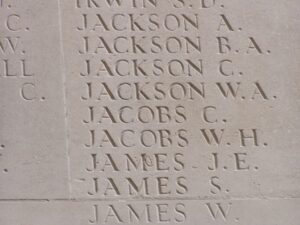
Albert James, Lieutenant, Machine Gun Corps. Albert was the son of James and Harriet James, of 57, Ropewalk Road, Llanelli. He was studying for the Ministry at Lampeter College at the outbreak of war and enlisted into the Public Schools Battalion of the Royal Fusiliers. He was commissioned from there into the 14th Welsh on 12 July 1915. Albert landed in France on 6 September 1917, and was promptly posted to the 10th Battalion, Machine Gun Corps. Albert was wounded by a gunshot in the abdomen during the German Spring Offensive, and died on 28 March 1918. He was 26 years old, and is buried at Gezaincourt Communal Cemetery Extension, France. His widow was then living at the Mostyn Hotel, at Rhyl.
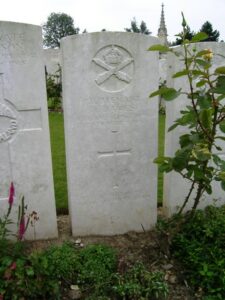
Bertie James, Private, 201027, Welsh Regiment. Bertie was born at Llanelli in 1895, the son of Robert and Elizabeth James of 14 Upper Water Street, Preswylfa row, New Dock, Llanelli. He enlisted there into the 4th Welsh and served with the battalion at Gallipoli before being wounded in the arm. After recovering at Grayingham Hospital, Chichester he rejoined the 4th Welsh in Egypt and was wounded at Gaza in March 1917.He returned to the UK again and after recovering was posted to the 18th Battalion, Welsh Regiment, which was in France attached to 119 Brigade, 40th (Bantam) Division. Later in the year the division took part in the Battle of Cambrai, playing an important role in the attack on Bourlon Wood. Bertie was killed here on 23 November 1917, aged 22. He is commemorated on the Cambrai Memorial, Louverval, France. His four brothers also served.

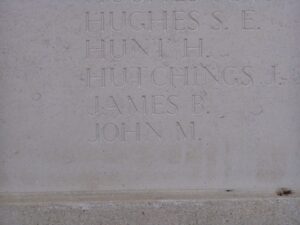
Brynmor James, Driver, 943, Royal Engineers. Brynmor was the son of David and Mary Ann James, of 19, Greenway Street, Llanelli. He was a tinplater prior to enlisting in September 1914 into the 9th Battalion, Royal Welsh Fusiliers, with the service number 13135, but was discharged at Wrexham as unfit after six weeks. He then enlisted as a Driver in the 3rd/1st Welsh Field Company, Royal Engineers in early 1915. Brynmor spent months training in various parts of England and Wales, Bedford, Salisbury and Caernarfon before he was posted to the Middle East. The climate in Egypt was harsh, and Brynmor became ill, boarding the hospital ship HMHS Egypt in June 1916 and returned home. Brynmor was discharged from the army for the second time on 12 August 1916, and died at home at 19, Greenway Street, Llanelli on 16 March 1917 from tuberculosis, aged 22. He was buried with full military honours at Llanelli (Old Road) Church Cemetery. Within months his brother Idwal was killed.
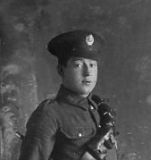
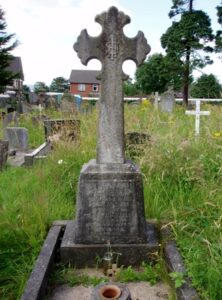
David Idwal James, Private, 29194, South Wales Borderers. Idwal was the son of David and Mary Ann James, of 19, Greenway Street, Llanelli. He enlisted at Llanelli into the South Wales Borderers in January 1916, and was posted to France on 19 May 1917, where he joined the 2nd Battalion, South Wales Borderers, which was attached to 87 Brigade, 29th Division. The Division was at Arras, and was just about to move to Ypres to relieve the 38th (Welsh) Division at Boesinghe. David was killed at Ypres on 4 July 1917 when a German shell hit a machine-gun pit that he was sharing with Privates Pitt and Morgan. He was 20 years old, and is buried at Bard Cottage Cemetery, Belgium. His brother Brynmor had died just four months earlier.
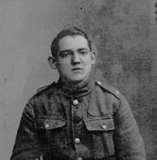
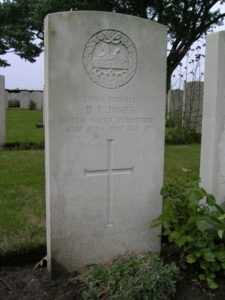
Edgar James, Private, 34342, Welsh Regiment. Edgar was the son of David and Elizabeth James of Llanelli, and the nephew of Elizabeth James, of 2, Caradog Street, Llanelli. He enlisted at Llanelli into the army, and was posted to France, where he joined the 2nd Battalion, Welsh Regiment, which was attached to 3 Brigade, 1st Division. Edgar probably joined the battalion at Loos, after the main battle there had stalled. The Division moved to the Somme in 1916, where they took part in the Battle of Pozières. Edgar was killed here on 26 July 1916, aged 20. He is commemorated on the Thiepval Memorial, France.
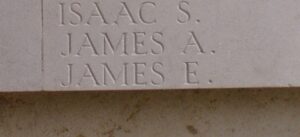
G. James, Private, Welsh Regiment. This man cannot presently be identified.
James James, Lance Corporal, 3876, Royal Warwickshire Regiment. James was the Grandson of Robert and Sarah James, of 20, High Street, Llanelli, and in 1910 took up work there as a Porter with the Great Western Railway. He had served with the 4th Welsh, before being transferred into the 2/7th Battalion, Royal Warwickshire Regiment, which was attached to 182 Brigade, 61st (2nd South Midland) Division. The Division landed in France on 21 May 1916, and moved to the Flanders sector, near Fromelles, where they took over the line held by the 38th Division. Here the Division was to take place in a combined attack with the 4th Australian Division, as a diversion to the main attack on the Somme, but it was a slaughter, with thousands of lives lost needlessly. James was killed just prior to this disastrous attack, on 30 June 1916. He was 20 years old, and is buried at Pont-Du-Hem Military Cemetery, La Gorgue, France.
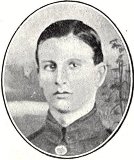
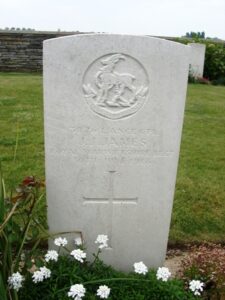
Thomas Henry James, Rifleman, A/186, Kings Royal Rifle Corps. Thomas was the son of John James, of Houghton Post Office, Neyland. He had worked for the Great Western Railway at Llanelli before the war, and enlisted at Llanelli into the Army, joining the 8th Battalion, Kings Royal Rifle Corps, attached to 41 Brigade, 14th (Light) Division. The Division was to see its first action during the Action of Hooge, where the Division were the first to be attacked by the German use of flamethrowers. It was probably during this action that Thomas was wounded. He died of wounds on 5 August 1915, but sadly his grave was lost during later fighting, and so he is commemorated on the Ypres (Menin Gate) Memorial, Belgium. He was just 20 years old.
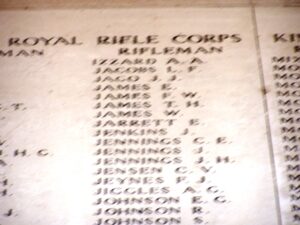
Wilfred Sydney James, Second Lieutenant, Royal Welsh Fusiliers. Wilfred was the son of Thomas Rees James and Margaret James, of Trebeddod House, Stradey Road, Furnace. He had been educated at Aberystwyth University before being commissioned into the 19th Battalion, Royal Welsh Fusiliers, which was attached to 119 Brigade, 40th (Bantam) Division. The Division moved to France between the 1 and 9 June, and moved to the front near Loos. Late in 1916 they moved south to the Somme, and fought at the Battle of the Ancre, and remained in the area over the winter. In March 1917 the Germans withdrew to their shortened line, called the Hindenburg Line, and the 40th Division were one of the Divisions that followed the withdrawal. Later in the year they took part in the Battle of Cambrai, playing an important role in the attack on Bourlon Wood. Wilfred was killed here on 24 November 1917. He was 21 years old, and is commemorated on the Cambrai Memorial, Louverval, France.
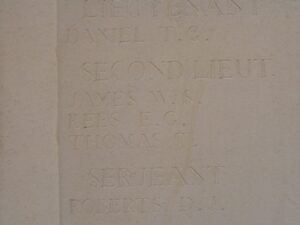
William Alfred James, Private, 969, Welsh Regiment. William was the son of John and Ann James, of Seaside, Llanelli. He married Margaret Ann Jones in December 1912, and they lived at 11, Railway Place, Seaside, Llanelli. William enlisted at Llanelli into the 1/4th Battalion, Welsh Regiment, which was the local Territorial Battalion, attached to 159 Brigade, 53rd (Welsh) Division. The Division landed at Cape Helles, Gallipoli, on 9 August 1915, and was immediately thrown into action, spending the next few days in isolated pockets, fighting against a Turkish counter-attack during the Battle of Sari Bair. William was killed towards the end of the Gallipoli campaign, on 10 December 1915. He was 31 years old, and is commemorated on the Helles Memorial, Gallipoli.
William John James, Lance Corporal, 20466, Welsh Regiment. William was the son of John and Mary Jane James, of Upper Mill Llanelli. He was employed as a behinder at the Old Castle Works in Llanelli, and enlisted there in February 1915 into the 15th Battalion, Welsh Regiment, which was known as the Carmarthen Pals battalion. Sometime after this he transferred to the 16th Battalion, which was the Cardiff City battalion, attached to 115 Brigade, 38th (Welsh) Division. The Division moved to France on 2 December 1915, and took up positions around Fleurbaix. In June 1916 they marched south to the Somme, and on 7 July 1916 the 16th Welsh and 11th South Wales Borderers made the Divisions first assault against Mametz Wood. William was one of many men killed that day, while attempting to cross open fields towards the heavily defended wood. He is buried at Flatiron Copse Cemetery, Mametz, France.
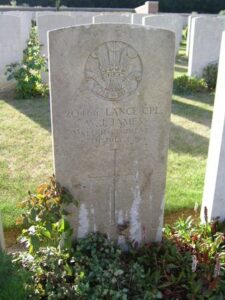
William John James, Private, 72837, Royal Welsh Fusiliers. William was born at Llanelli in December 1899, the son of David and Margaret Ann James. The family later moved to 90, John Street, Nantymoel, Bridgend. William originally enlisted into the Army Service Corps, but was transferred to the 13th Battalion, Royal Welsh Fusiliers, which was in France attached to 113 Brigade, 38th (Welsh) Division. William joined the battalion in the summer of 1917 at Boesinghe, and was killed during their assault on Pilckem Ridge on 31 July 1917, aged just 17. He is commemorated on the Ypres (Menin Gate) Memorial, Belgium.
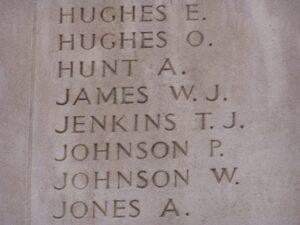
Zephania (Seth) James, Private, 29894, South Wales Borderers. Seth was born at Swansea in 1892, the son of Henry and Sarah James. He had worked as a Copper Roller at Swansea prior to moving to Llanelli, and enlisted there into the 3rd Battalion, South Wales Borderers. Seth was based at Sniggery Camp, Liverpool, when he took ill, and died at Liverpool Military Hospital on 2 July 1917. Seth was 24 years old, and is buried at Swansea (Cwmgelly) Cemetery.
Frederick George Jayne, Sergeant, 4438, Welsh Regiment. Frederick was the son of Frederick William and Sarah Ann Jayne, of Crumlin, Coleshill Terrace, Llanelli. He married Sarah Giles in 1912, and the couple lived at 7, Birdin Terrace, Felinfoel. Frederick enlisted at Llanelli into the 1/4th Battalion, Welsh Regiment, which had formed locally during August 1914 and were then attached to 159 Brigade, 53rd (Welsh) Division. The Division moved to the Mediterranean, sailing from Devonport in July 1915, and landed at Cape Helles, Gallipoli via Mudros on 9 August 1915. Here they immediately faced the chaotic leadership that was to lead to the ultimate failure of the campaign, and spent the next few days in isolated pockets, fighting against a Turkish counter-attack. Frederick was wounded here during the Battle of Sari Bair, and died of wounds aboard a Hospital Ship on 11 August 1915, aged 33. He was buried at sea, and so he is remembered on the Helles Memorial, Gallipoli. Sarah died in 1934. His brother, Walter Havard Joseph Jayne also fell.
Walter Havard Joseph Jayne, Lance Corporal, 46589, Leicestershire Regiment. Walter was the son of Frederick William and Sarah Ann Jayne, of Crumlin, Coleshill Terrace, Llanelli. He had originally served with the Royal Engineers, but later transferred into the 11th Battalion, Leicestershire Regiment, which was the Pioneer battalion to the 6th Division. The Division had been in France since September 1914, and had fought at Hooge, before taking part in the Somme offensive. The following year saw them at Arras, where they fought at the Battle of Hill 70, and then during the Battle of Cambrai later in the year. In the spring of 1918 the Division was one of those hit by the German Offensive on the Somme, which had been launched on 21 March, and the Division took part in the Battle of St Quentin. Walter was killed here on 21 March 1918. He was 24 years old, and is commemorated on the Arras Memorial, France. His brother, Frederick George Jayne, also fell.
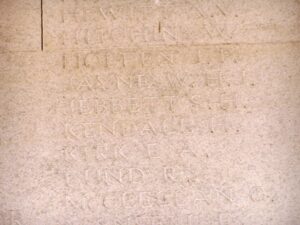
Daniel Jefferson, Private, 14770, Dorsetshire Regiment. Daniel was born at Bootle, but resided at Llanelli prior to the war, enlisting there into the 1st Battalion, Devonshire Regiment. The battalion was stationed in Belfast at the outbreak of war, and moved to France with 15 Brigade, 5th Division, landing at Le Havre on 16 August 1914. After taking part in the retreat from Mons to the Marne, the battalion was transferred to 95 Brigade, 32nd Division after the Battle of Loos. The Division moved to the Somme soon after, and it was here that Daniel was wounded, during the build up to the Battle of the Somme. He died on 21 June 1916, and is buried at Authile Military Cemetery, France.
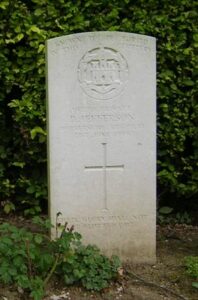
Arthur Gower Jenkins, Private, 20770, Welsh Regiment. Arthur was the husband of Letitia Jenkins (nee Matthews), of Hillside House, Bigyn Hill, Llanelli. He enlisted at Llanelli in February 1915 into the 15th Battalion, Welsh Regiment, which was known as the Carmarthen Pals battalion, attached to 114 Brigade, 38th (Welsh) Division. On 2 December 1915 the battalion moved to France, and the entire Division moved to the Fleurbaix sector, where it was initiated into trench warfare. During June 1916 the Division marched south to the Somme, and on 7 July 1916 attacked Mametz Wood. The initial attack failed, and it was three days later, on 10 July, that a fresh attack was mounted. After two days of heavy hand to hand fighting within the wood, the Germans withdrew, and the battered Welshmen moved via Hebuterne to Boesinghe, on the Yser Canal, where it remained until launching its attack on Pilckem Ridge on 31 July 1917. The 15th Welsh remained in the line, and also took part in the Battle of Langemarck, before the entire Division was moved to positions near Armentieres over the winter. Arthur was reported as missing on 3 November 1917, and his body was found in the River Aa at Wizernes on 23 November 1917. He was 30 years old, and was buried at Wizernes Communal Cemetery, France. His widow Letitia was refused a pension, as it was deemed that Arthur’s death was his own fault, as he had drowned whilst awaiting a Court Martial.
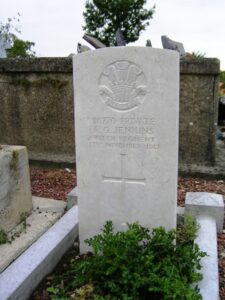
Benjamin Jenkins, Corporal, 13730, South Wales Borderers. Benjamin was the son of Griffith and Mary Jenkins, of Druce House, St. Peter’s Terrace, Llanelli. He enlisted at Newport into the 1st Battalion, South Wales Borderers, which was attached to 3 Brigade, 1st Division. The Division had been one of the first to arrive in France, fighting at the Battle of Mons, and the retreat to the Marne, where the Germans were stopped. They then fought at the Aisne, and at Chivy, before being moved north to Ypres. Here they fought at the First Battle of Ypres. The following year saw them in action again at the Battle of Aubers, before moving South to Loos, where they fought during the Battle of Loos, and the action at the Hohenzollern redoubt. Again they were required for a major offensive, moving south to the Somme, where they fought during the opening of the Somme Offensive at the Battle of Albert, then at Bazentin, Pozieres, Flers-Courcelette and Morval. They followed the German retreat to the Hindenburg Line in early 1917, and were then briefed for an operation on the Flanders Coast, and moved there during the summer of 1917. While training on the coast, the Battle of Third Ypres had stalled in the mire, and the Division were recalled to Ypres, where they fought at the Second Battle of Passchendaele. Benjamin was wounded after the battle had drawn to a close, and died on 19 November 1917, aged 28. He is buried at Lijssenthoek Military Cemetery, Belgium.
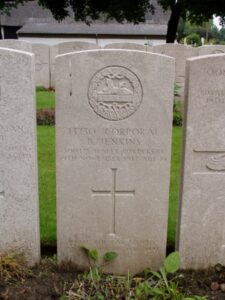
Daniel Morley Jenkins, Private, 851, Welsh Regiment. Daniel was born at New Quay, Cardiganshire, the son of David and Rachel Jenkins. He resided at Tumble prior to the war, and enlisted at Carmarthen into the 1/4th Battalion (Carmarthen), Welsh Regiment, which was attached to 159 Brigade, 53rd (Welsh) Division. Daniel was wounded soon after the battalion landed on Gallipoli on 8 August 1915, and he died of his wounds aboard a Hospital Ship on 16 August 1915. He was buried at sea, and is commemorated on Panel 140-144 of the Helles Memorial, Gallipoli.
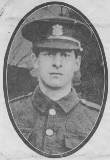
Ernest Edward Jenkins, Private, 235830, Lancashire Fusiliers. Ernest was the John and Emily Jenkins. He had been raised by his step-parents, Mr. and Mrs. Doward, of Hammersmith, London. Ernest was a policeman, and had worked at Llandeilo and at Llanelli prior to the war, and married Elizabeth Caroline Davey before transferring to Kenfig Hill with the Police. Ernest was posted to France at some time after 1916, joining the 2nd Battalion, Lancashire Fusiliers, which was attached to 12 Brigade, 4th Division. The division had seen heavy fighting throughout 1917, at Arras and at Ypres, before moving to the Arras sector to rest. It was among the division hit by the German spring offensive of 21 March 1918, and saw heavy fighting over the coming weeks. Ernest was killed on 19 April 1918, aged 36, and is buried in Lapugnoy Military Cemetery, France. His widow, Elizabeth, later remarried, and moved to 3, Laundry Cottages, Northfields, Ealing, London.
Evan Ivor Isaac Jenkins, Private, 5174, Welsh Regiment. Evan was the son of Isaac John Jenkins and Mary Jane Jenkins (nee Treharne), of 48, Alban Road, Llanelli. He enlisted at Llanelli into the 4th (Reserve) Battalion, Welsh Regiment on 29 October 1914 and served at Hearson Camp, Pembrokeshire with the battalion until being posted to the 3rd/4th Welsh on 9 November 1915. Evan remained on home service as his health was failing and he was discharged from the army on 22 August 1916 after having been diagnosed as suffering from diabetes at Pembroke Dock Military Hospital. Evan returned home to Llanelli but his health continued to fail and he died on 4 March 1919, aged 20. He is buried in Llanelli District Cemetery. He is not currently commemorated by the CWGC but I have recently forwarded evidence to the CWGC in order to attempt to gain official commemoration for him.
Evan Rees Jenkins, Private, 143005, Machine Gun Corps. Evan was the son of Joseph and Jane Jenkins, of 8, Upper Mill, Llanelli. He originally served with the 4th Battalion, South Staffordshire Regiment, before being posted to the Machine Gun Corps. Evan was killed in France during the Battle of the Lys, on 14 April 1918. He was 20 years old, and is commemorated on the Ploegsteert Memorial, Belgium.
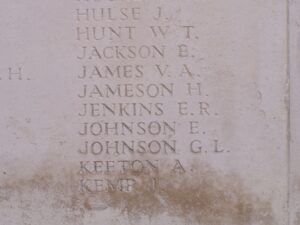
Frank Mason Jenkins, MM, Lance Sergeant, 12903, Royal Welsh Fusiliers. Frank was the son of Thomas and Mary Ann Jenkins, of 4, Nevill’s Terrace, Dafen. He enlisted at Llanelli into the 9th Battalion, Royal Welsh Fusiliers, which were part of 58 Brigade, 19th (Western) Division. The Division crossed to France during July 1915, and moved to positions near Loos. The Division fought during the opening attack of the Battle of Loos, and then moved to the Somme, where they took part in the second wave of the attack on Ovillers-La Boiselle on 1 July, capturing the village at heavy cost, and fought through the Somme Battles of Pozieres and the Ancre in 1916. They then moved North to Ypres, taking part in the Battle of Messines, and fought on the Menin Road and at Polygon Wood, before moving up to Broodseinde, Poelcapelle and Passchendaele Village itself. In 1918 they were caught up in the German Spring Offensive near St. Quentin, where they suffered terrible casualties, and fought at the Battle of Bapaume. They moved to Ypres, but were caught up in the German attack at Messines, and at Bailleul, and Kemmel. Frank was wounded in Flanders, and died on 8 May 1918, aged 27. He is buried at Poperinghe New Military Cemetery, Belgium.
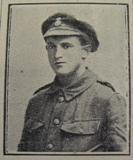
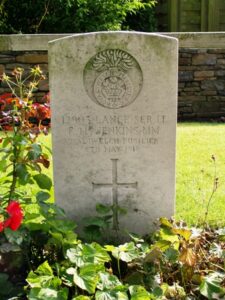
George Jenkins, Private, 317069, Royal Welsh Fusiliers. George was the son of John and Sarah Jenkins of Llanelli. He married Harriet Nelson at Llanelli in December 1913. George enlisted at Llanelli in February 1913 into the 4th Battalion, Welsh Regiment, which was the local Territorial Battalion, attached to 159 Brigade, 53rd (Welsh) Division. George remained in Britain when the 53rd Division embarked for overseas, and on 19 May 1917 was posted to France, joining the 15th Battalion, Welsh Regiment (Carmarthen Pals). He was wounded at Pilckem Ridge on 31 July 1917 and invalided home. He was then posted to the 23rd Battalion, Royal Welsh Fusiliers, which was a Home Service unit, attached to 224 Brigade. He died of sickness at the Lord Derby Hospital, Warrington on 1 March 1919, aged 31, and is buried at Box Cemetery, Llanelli.
Isaac Lewis Jenkins, Drummer, 16425, Welsh Regiment. Isaac was born at Towyn, Merioneth, the son of Evan and Sarah Jenkins. The family later moved to 12, St. David Street, Llanelli, and Isaac met and married Kate E. Griffiths at Llanelli in June 1911. The couple then moved back to North Wales, and lived at 6, Union Square, Dolgelley, Merioneth. Isaac enlisted into the 10th Battalion, Welsh Regiment, which moved to France on 2 December 1915 attached to 114 Brigade, 38th (Welsh) Division. The division took up positions around Fleurbaix, and in June 1916 marched south to the Somme, where they were tasked with the capture of Mametz Wood. Isaac was killed during the latter stages of the capture of the wood, on 12 July 1916. He was 27 years old, and is commemorated on the Thiepval Memorial, France.
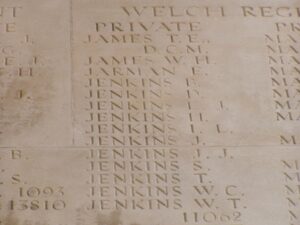
Ivor George Jenkins, Private, 4311, Welsh Regiment. Ivor was the son of Edward and Mary Ann Jenkins, of 1, Caroline Street West, Llanelli. He enlisted at Llanelli into the 1/4th Battalion, Welsh Regiment, which was the local Territorial Battalion, attached to 159 Brigade, 53rd (Welsh) Division. The Division landed at Cape Helles, Gallipoli, on 9 August 1915, and was immediately thrown into action, spending the next few days in isolated pockets, fighting against a Turkish counter-attack during the Battle of Sari Bair. Ivor was wounded later on in the campaign, and died on 26 November 1915. He was 18 years old, and is buried at Lala Baba Cemetery, Gallipoli.
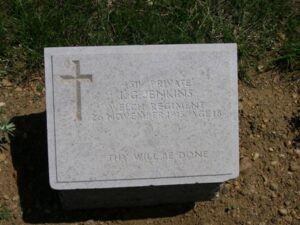
J. Jenkins, Sergeant, South Wales Borderers. This man cannot presently be identified.
James Jenkins, Stoker, 6317S, Royal Navy. James was born on 23 October 1878, the son of Robert and Ellen Jenkins, of Llanelli. He served as a Stoker with the Royal navy aboard the battlecruiser HMS Tiger. She was assigned to the 1st Battlecruiser Squadron for the duration of the war and participated in the Battle of Dogger Bank in early 1915, and the Battle of Jutland in 1916. She spent the rest of the war on patrols in the North Sea, and provided fire during the Second Battle of Heligoland Bight in 1917. James took ill, and died ashore on 8 July 1918, aged 39. He is buried at Box Cemetery, Llanelli.
Jeremiah Christmas Jenkins, Private, 32899, Welsh Regiment. Jeremiah was the son of Hector and Margaret Jenkins, of 6, Talbot Street, Llanelli. He enlisted at Pembroke into the 8th Battalion, Welsh Regiment, which was the Pioneer Battalion to the 13th (Western) Division. On 13 June 1915 the Division sailed for Alexandria, and moved to Mudros before being landed at Cape Helles, Gallipoli from 6 July 1915, relieving the 29th Division. Jeremiah was killed here during the Battle of Sari Bair, on 8 August 1915. He was 30 years old, and is commemorated on the Helles Memorial, Gallipoli.
Joseph John Jenkins, Private, 201648, South Wales Borderers. Joseph was the son of William and Mary Ann Jenkins, of 22, New Dock Road, Llanelli. He enlisted at Brecon into the 7th Battalion, South Wales Borderers, which was attached to 67 Brigade, 22nd Division. The Division crossed to France in early September 1915, and on 27 October 1915 began to embark for Salonika. It remained in the theatre for the rest of the war. Joseph was killed in action during the Second Battle of Doiran, on 18 September 1918. He was 25 years old, and is buried at Doiran Military Cemetery, Greece.
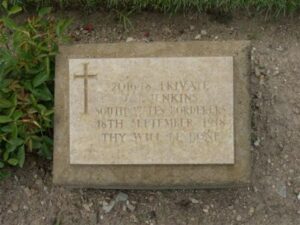
Richard Jenkins, Private, 201048, Welsh Regiment. Richard was the son of the late William and Elizabeth Jenkins, of Llawhaden, Narberth. He enlisted at Llanelli into the 1/4th Battalion, Welsh Regiment, which was part of 159 Brigade, 53rd (Welsh) Division. Richard survived the battalion’s time at Gallipoli, and moved to Egypt with them during the withdrawal from Gallipoli. After a year fighting Arab tribesmen in Egypt, the division moved into Palestine, and Richard was killed here, during the Second Battle of Gaza, on 20 April 1917. He was just 21 years old, and is buried at Deir El Belah War Cemetery, Egypt.
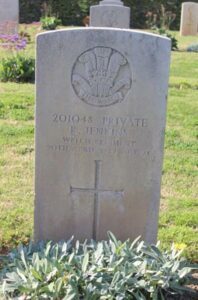
Richard Miles Jenkins, Private, 94253, Royal Welsh Fusiliers. Miles was the son of James and Jane Jenkins, of Llannon. He resided at Pontyberem prior to the war, and enlisted at Llanelli into the Monmouth Regiment, with the Regimental Number 60737. Miles later transferred into the 17th Battalion, Royal Welsh Fusiliers, which was attached to 115 Brigade, 38th (Welsh) Division. The Division had been in France during December 1915, and had taken part in the famous actions of Mametz Wood and Pilckem Ridge. Miles probably joined the Division after it had moved from Armentieres to the Somme in April 1918. On 21 August 1918, the 38th Division launched its assault across the River Ancre, and pushed east, where they fought at the Battle of Bapaume. Then the move began towards the mighty Hindenburg Line, and the Division carried on with their march east, taking part in the capture of the Canal du Nord, which opened a passage through the Hindenburg Line. The Division then fought at the Battle of Beaurevoir, and moved up towards Cambrai, capturing Villers-Outreaux, before advancing to the Selle and onto the Sambre. Miles was killed in action at the Battle of the Sambre on 4 November 1918, and is buried at Englefontaine British Cemetery, France.
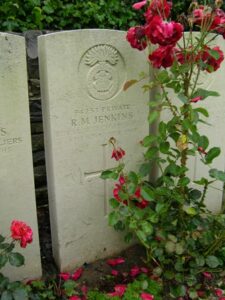
Samuel Jenkins, Private, 13391, Royal Welsh Fusiliers. Samuel was the son of David and Rosie Jenkins, of 25 Andrew Street, Llanelli. He worked as a tinwork behinder and lived at Greenway Street prior to the war. Samuel enlisted at Llanelli into the 8th Battalion, Royal Welsh Fusiliers. The battalion was attached to 40 Brigade, 13th (Western) Division, and sailed on 13 June 1915 for Alexandria, before landing at Cape Helles, Gallipoli from 6 July 1915, relieving the 29th Division. They left and returned to Mudros at the end of the month, and the entire Division landed at ANZAC Cove between 3 and 5 August, 1915, taking part in the Battles of Sari Bair, Russell’s Top, and Hill 60, ANZAC. Samuel was among a group of men killed by a shrapnel shell at Sari Bair on 12 August 1915. He was 23 years old and is commemorated on the Helles Memorial, Gallipoli.
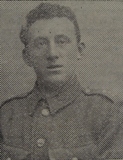
Samuel Jenkins, Private, 48710, Northumberland Fusiliers. Samuel was the son of Daniel and Margaret Jenkins, of 15, Lakefield Road, Llanelli. He married Elizabeth Sarah Williams in 1904, and the couple resided at 32, Swansea Road, where their two children were born. Samuel enlisted in Llanelli in October 1915 into the 3rd Battalion, South Wales Borderers. He was transferred into the 2nd Garrison Battalion, Northumberland Fusiliers, which was formed in Newcastle in October 1915 and went to India in February 1916. Samuel must have been attached to another unit then, as he was killed in Action in Mesopotamia, during the Battle of The Boot, at Band-i-Adhaim on 30 April 1917, aged 42. He is commemorated on the Basra Memorial, Iraq.
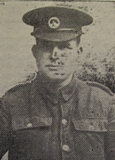
Thomas Rees Jenkins, Private, 22897, Welsh Regiment. Thomas was the son of Griffith and Charlotte Jenkins, of 59, Rope Walk Road, Llanelli. He enlisted at Llanelli into the Welsh Regiment, and was posted to the 9th Battalion, Welsh Regiment, which was attached to 58 Brigade, 19th (Western) Division. The Division crossed to France during July 1915, and moved to positions near Loos, where it took part in the opening attack of the Battle of Loos on 25 September 1915. The following year the Division moved to the Somme, where it took part in the second wave of the attack on Ovillers-La Boiselle on 1 July, capturing the village at heavy cost. In 1917 the Division moved North to Ypres, taking part in the Battle of Messines. Thomas was killed here on 1 August 1917. He was 20 years old, and is commemorated on the Ypres (Menin Gate) Memorial, Belgium.
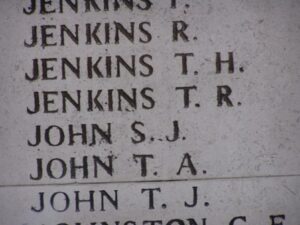
Walter Jennings, Lance Bombardier, 156056, Royal Garrison Artillery. Walter was the son of John and Annie Jennings, of Llanelli. He married Lottie L. Davies at Chester in June 1913, and they lived at 57, Parkgate Road, Chester. Walter then enlisted at Pontypool into the Royal Garrison Artillery, and served in France with the 510th Siege Battery, RGA. Walter took ill while in France, and returned home, but sadly died on 27 February 1918, aged 39. He is buried with his parents at Box Cemetery, Llanelli.
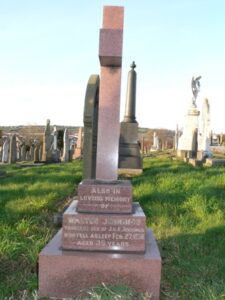
Albert John, Bombardier, 150673, Royal Garrison Artillery. Albert was the son of William Henry and Jane John, of Llanelli. He enlisted at Llanelli into the Royal Garrison Artillery, and was posted to France, where he joined the 498th Siege Battery, RGA, which was attached to the Fourth Army. Albert was wounded during the Advance on the Hindenburg Line, and died in hospital on 14 September 1918. He was 21 years old, and is buried at Terlincthun British Cemetery, Wimille, France.
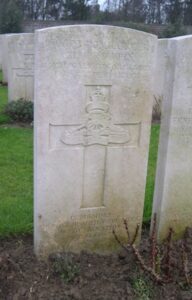
Arthur John, Private, 5401, Royal Welsh Fusiliers. Arthur was born at Llanelli, and was the husband of Maggie John, of 5, Wryant Place, Mardy, Glam. He enlisted at Cardiff into the army, and was posted to the 9th Battalion, Royal Welsh Fusiliers, which was attached to 58 Brigade, 19th (Western) Division. The Division crossed to France during July 1915, and moved to positions near Loos, where it took part in the opening attack of the Battle of Loos on 25 September 1915. The following year the Division moved to the Somme, where it took part in the second wave of the attack on Ovillers-La Boiselle on 1 July, capturing the village at heavy cost. In 1917 the Division moved north to Ypres, taking part in the Battle of Messines. Arthur was killed here on 7 June 1917. He is buried at Croonaert Chapel Cemetery, Belgium.
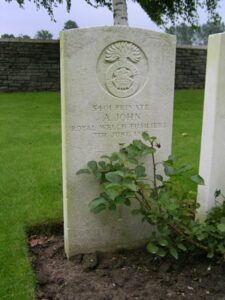
Daniel John, Sapper, 43591, Royal Engineers. Daniel was the son of David and Ann John, of 6, Trostre Road, Llanelli. He enlisted at Llanelli into the Royal Engineers, and was sent to France with the 201st Field Company, Royal Engineers, which was attached to the 30th Division. The Division moved to France in November 1915, and took part in its first major action during the Somme Offensive, at the Battle of Albert, where they captured Montauban. They then fought during the latter stages of the offensive, during the Battle of Le Transloy, before wintering on the Somme. In March 1917 the Division followed the German Retreat to the Hindenburg Line, and in April took part in the First Battle of the Scarpe, and then at the later Second Battle of the Scarpe. Later that year they were moved north to Ypres, and fought at the Battle of Pilckem. Daniel was wounded at Ypres, and died at the 18th General Hospital, Camiers on 12 September 1917, aged 29. He is buried at Etaples Military Cemetery, France.
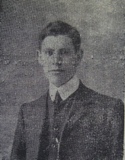
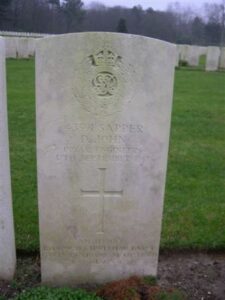
David Thomas John, Lance Corporal, 244, Australian Infantry. David was born at Dillwyn Street, Llanelli on 2 July 1891, the eldest son of William and Eliza John. The family later moved to Halfpenny Furze, Laugharne. In 1913, David married Lillian Evans of Laugharne, and they had a son, John William John. In 1913 David ran away from his family, and ended up in Bulli, New South Wales, where he found work as a Coalminer. On 18 August 1914, he enlisted at Randwick, NSW into the 4th Battalion, Australian Infantry, which was part of the 1st Australian Division. In October 1914 the battalion left Australia aboard the Troopship Euripides, and on 4 December disembarked at Cairo. After intensive training, the 1st Australian Division landed at Gallipoli on 25 April 1915, and took part in heavy fighting securing their beach-head at Anzac Cove. On 29 March 1916, the Battalion boarded the troopship Transylvania and embarked from Alexandria to join the BEF in France, landing at Marseilles on 6 April 1916, and moving to positions in Northern France, at Fromelles. The Battle of the Somme began on 1 July 1916, and the 1st Australian Division had been moved to the Somme, where it captured the strongly defended Pozières Ridge. On 11 August 1916 David was promoted to Lance Corporal, and his Battalion was sent back to the front line, directly opposite Mouquet Farm. At around 14.00 on 18 August 1916, David was sent out in charge of a patrol, which had been detailed to locate the German front line at Mouquet Farm, when the patrol was surprised by a German patrol. David and Oliver Williams were killed in the ensuing firefight. David was buried between Pozieres and Mouquet Farm, but his grave was lost during further fighting, and today he is remembered on the Villers-Brettoneux Memorial, France. He was 25 years old and had left a 3-year-old son behind [My Grandfather].
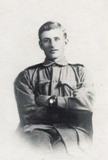
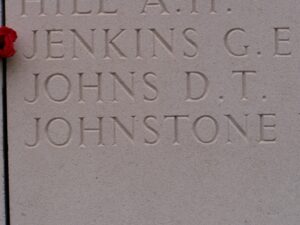
Frederick John, Private, 43608, Welsh Regiment. Frederick was born at Bancyfelin, the son of William and Adalide John. William had been the Station Master there before moving the family to Sarnau, 3, Whitley Road, Loughor. Frederick enlisted at Llanelli into the Welsh Regiment, and at some time i 1916 was posted to France, joining the 16th Battalion, Welsh Regiment, which was attached to 115 Brigade, 38th (Welsh) Division. The Division had been in France since December 1915 and had spent their first winter in the trenches near Armentieres. In June they marched south to the Somme, where they were tasked with the capture of Mametz Wood. The attack began on 7 July, but met with fierce resistance, and it took until 12 July to clear the wood. The Division suffered terrible casualties at Mametz, and were taken out of the line, and moved to Ypres to rebuild. Here they fought at Pilckem and Langemarck, which is where Frederick was killed on 27 August 1917, aged 24. He is remembered on the Tyne Cot Memorial, Belgium. He is also remembered on the headstone of his parent’s grave at Box Cemetery, Llanelli.
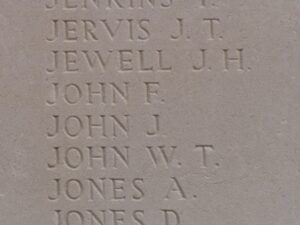
John Archibald John, Bombardier, Royal Garrison Artillery. John is listed as a Llanelli casualty in the 1922 published County War Memorial roll, but he appears to have survived the war and died in Oswestry in 1974.
John Llewellyn John, Gunner, W/512, Royal Field Artillery. John was born at Swansea. He resided at Llanelli prior to the war, and enlisted there into the Welsh Royal Field Artillery. He went to France in December 1915 attached to C Battery, 121st Brigade, RFA, which was attached to the 38th (Welsh) Division. John was killed during the Divisions famous attack on Mametz Wood, on 11 July 1916. He is commemorated on the Thiepval Memorial, France.
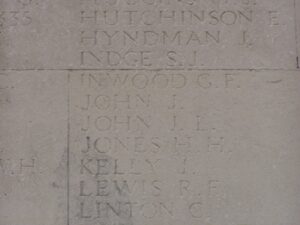
Sydney John, Leading Stoker, K/5787, Royal Navy. Sydney was born on 17 July 1890, the son of Hannah John, of 8, Mansel Street, Llanelli. He served with the Royal Navy aboard the Minotaur Class cruiser, HMS Defence. She was in the Mediterranean when the First World War began and participated in the pursuit of the German battlecruiser SMS Goeben and light cruiser SMS Breslau, before being transferred to the Grand Fleet in January 1915. Sydney was killed when Defence was sunk during the Battle of Jutland on 31 May 1916, aged 25. He is commemorated on the Plymouth Naval Memorial, Devon.
Valley John, Private, 91138, Machine Gun Corps. Valley was the son of Elizabeth John, of 18, Quay Street, Haverfordwest. He worked as a railway platelayer prior to the war, based at the GWR depot at Llanelli, and married Maria Williams at Haverfordwest in 1912. Valley enlisted at Llanelli into the Machine Gun Corps. He joined the 30th Battalion, which was attached to the 30th Division. The Division moved to France in November 1915, and took part in its first major action during the Somme Offensive, at the Battle of Albert, where they captured Montauban. They then fought during the latter stages of the offensive, during the Battle of Le Transloy, before wintering on the Somme. In March 1917 the Division followed the German Retreat to the Hindenburg Line, and in April took part in the First Battle of the Scarpe, and then at the later Second Battle of the Scarpe. Later that year they were moved north to Ypres, and fought at the Battle of Pilckem. At the beginning of 1918 the Division were stationed near St. Quentin, and when the Germans launched their Offensive here on 21 March, the Division took part in the Battle of St Quentin, which is where Valley was wounded. He died on 31 March 1918, aged 27, and is buried at Chambieres French National Cemetery, France.
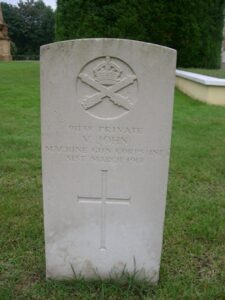
William Owen John, Private, 11816, Welsh Regiment. William was the son of Joshua and Mary John, of 8, Park View Terrace, Llanelli. He enlisted at Llanelli into the 1/4th Battalion, Welsh Regiment, which was the local Territorial Battalion, attached to 159 Brigade, 53rd (Welsh) Division. The Division landed at Cape Helles, Gallipoli, on 9 August 1915, and was immediately thrown into action, spending the next few days in isolated pockets, fighting against a Turkish counter-attack during the Battle of Sari Bair, and then at the Attack on Scimitar Hill. William was wounded at Gallipoli, and returned home for treatment, where he was attached to the 3rd Welsh. He died of chronic bronchitis on 11 June 1918, aged 29, and is buried at Box Cemetery, Llanelli.
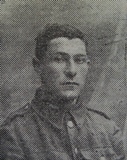
William Thomas John, DCM, Sergeant, 20155, Welsh Regiment. William was the son of William and Margaret John, of 4, Cawdor Row, Llanelli. He enlisted at Llanelli in February 1915 into the 15th Battalion, Welsh Regiment, which was known as the Carmarthen Pals battalion. The battalion trained at Rhyl and Winchester, before landing in France on 2 December 1915 attached to 114 Brigade, 38th (Welsh) Division. The entire Division moved to the Fleurbaix sector, where it was initiated into trench warfare. During June 1916 the Division marched south to the Somme, and on 7 July 1916 attacked Mametz Wood. The initial attack failed, and it was three days later, on 10 July, that a fresh attack was mounted. After two days of heavy hand to hand fighting within the wood, the Germans withdrew, and the battered Welshmen moved via Hebuterne to Boesinghe, on the Yser Canal, where it remained until launching its attack on Pilckem Ridge on 31 July 1917. The 15th Welsh remained in the line, and also took part in the Battle of Langemarck, before the entire Division was moved to positions near Armentieres over the winter. After the Germans launched their offensive on the Somme on 21 March 1918, the Division was moved back to the Somme, and took up positions north of Albert, around Aveluy Wood. On 21 August 1918 elements of the 15th Welsh crossed the River Ancre, and set up a bridgehead, which enabled the rest of the battalion to cross, and in the coming days advanced and captured Thiepval and Pozières Ridges. The Division then drove on past Longueval to the Canal du Nord and the Hindenburg Line, before turning towards Le Cateau and the Forest of Mormal. William gained the award of the Distinguished Conduct Medal, on 20 October 1918, when his platoon commander was killed whilst swimming the Selle, and he took command of the Platoon. The citation to the award stated that; ‘He at once took command, and on emerging from the river re-organised his platoon under heavy machine-gun fire, and led them forward, capturing a machine gun and crew, and turning the gun on the enemy. He then pushed forward again and captured two small enemy trench howitzers. He showed gallant leadership and did excellent work.’ Sadly William was wounded that day, and died on 2 November 1918, aged 21. He is buried at Forest Communal Cemetery, France.
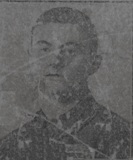
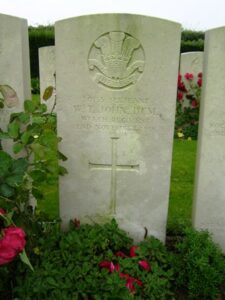
Richard Walter Johnson, Private, 3728, Welsh Regiment. Richard was the son of John and Elizabeth Johnson, of 1, Catherine Street, Llanelli. He married Emily Evans in 1913, and the couple set up home at of 2, Arthur Street, Llanelli, where they had two children. Richard worked at the Pemberton Tinplate Works prior to the war, and enlisted at Llanelli into the 1/4th Battalion, Welsh Regiment, which was the local Territorial Battalion, attached to 159 Brigade, 53rd (Welsh) Division. The Division landed at Cape Helles, Gallipoli, on 9 August 1915, and was immediately thrown into action, spending the next few days in isolated pockets, fighting against a Turkish counter-attack during the Battle of Sari Bair. Richard was wounded within weeks of the landing, and died aboard a hospital ship on 9 September 1915. Richard was buried at sea two days later, so is commemorated on the Helles Memorial, Gallipoli.
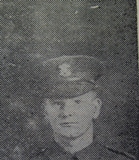
Brinley Jones, Private, 13722, South Wales Borderers. Brinley was the son of William Charles Jones and Mary Ann Jones, of 15, Mansel Street, Llanelli. He enlisted at Llanelli into the 1st Battalion, South Wales Borderers, which moved to France at the outbreak of war attached to 3 Brigade, 1st Division. The Division fought at the Battle of Mons, taking part in the retreat to the Marne, where the Germans were stopped. They then fought at the Aisne, and at Chivy, before being moved north to Ypres. Here they fought at the First Battle of Ypres, where they again stopped the German Offensive, before wintering in Flanders. Brinley was killed here on 25 January 1915, aged 20. He is commemorated on the Le Touret Memorial, Richebourg L’Avoue, France.
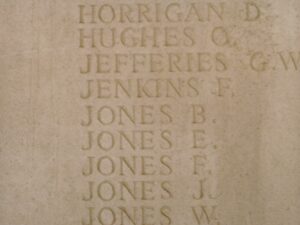
Charles Samuel Jones, Corporal, 20001, South Wales Borderers. Charles was the son of Alfred and Sarah Jones, of 3, Mount Pleasant Building, Llanelli. He enlisted there into the 11th Battalion, South Wales Borderers. They were attached to 115 Brigade, 38th (Welsh) Division, and moved to France on 2 December 1915. They had spent their first winter in the trenches near Armentieres. In June they marched south to the Somme, where they were tasked with the capture of Mametz Wood. The attack on the wood began on 7 July, but met with fierce resistance, and it took until 14 July to totally clear the wood. The Division suffered terrible casualties at Mametz, and were taken out of the line, and moved to Ypres to rebuild. On 31 July 1917 the Division launched its assault on the Pilckem Ridge, and Charles was killed that day. He was 23 years old, and is commemorated on the Ypres (Menin Gate) Memorial, Belgium.
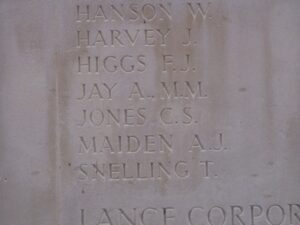
Cledwyn Lloyd Jones, Second Lieutenant, Notts & Derby (Sherwood Foresters). Cledwyn was the son of Richard and Annie Jones, of Hilltop, Tyrfran, Llanelli, and was commissioned from the Royal Fusiliers into the Sherwood Foresters on 30 October 1917. Cledwyn was posted to the 2/7th Battalion, which was attached to 178 Brigade, 59th (2nd North Midland) Division. In April 1916 the Division moved to Ireland, and was the first TF Division to serve there, involved in actions against the Republican Uprising of Easter 1916. During January 1917 they returned to England, and the following month landed in France. They followed the German Retreat to the Hindenburg Line, and then moved north, taking part in the Battle of the Menin Road (part of the Third Battle of Ypres), and the Battle of Polygon Wood. Later that year they moved south, and took part in the Battle of Cambrai. They remained in this sector over the final winter of the war, and on 21 March 1918 were one of the Divisions hit here by the German Spring Offensive, at the Battle of St Quentin. Cledwyn was killed in action here on 21 March 1918, aged 21. He has no known grave, and so is remembered on the Arras Memorial, France.
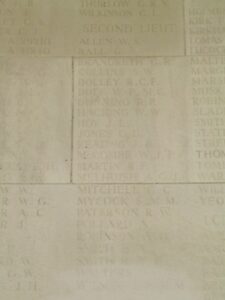
Cyril Jones, Private, 34675, Manchester Regiment. Cyril was born in London in 1881, the son of William Edward and Amelia Ann Jones. His father William was from Carmarthen, and by 1891 the family had moved back to West Wales. Cyril lived at Greenfield Villas, Llanelli prior to the war and enlisted at Manchester into the army. He was posted to the 7th Battalion, Manchester Regiment, which was attached to 127 Brigade, 42nd (East Lancashire) Division. The division had seen service in Gallipoli and Egypt before moving to France in 1917, and carried out trench familiarisation around Épehy. Cyril was killed here on 2 April 1917, aged 36, and is buried in Honnechy British Cemetery, France.
Daniel Jones, Gunner, 97887, Royal Field Artillery. Daniel was the son of David and Mary Jones, of 23, Pemberton Street, Llanelli. He enlisted at Llanelli into the Royal Field Artillery. He was posted to France with A Battery, 45th Brigade, RFA, which was attached to the 8th Division. Daniel was killed during the German Spring offensive, on 4 April 1918, aged 32. He is commemorated on the Pozières Memorial, France.
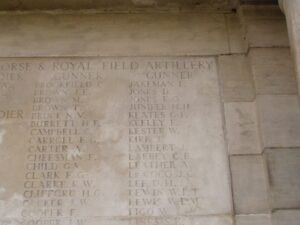
Daniel Jones, Private, 9158, Welsh Regiment. Daniel was born at Llanelli. He had served with the Welsh Regiment before the war, and was a reservist, being called up in August 1914. Daniel was posted to the 2nd Battalion, Welsh Regiment, which was attached to 3 Brigade, 1st Division. The Division had been one of the first to arrive in France, fighting at the Battle of Mons, and taking part in the retreat to the Marne, where the Germans were stopped. They then fought at the Aisne, and at Chivy, before being moved north to Ypres. Here they fought at the First Battle of Ypres., where the BEF stopped the German drive towards the Channel ports. Daniel was killed here during the Battle of Langemark, on 25 October 1914. He is commemorated on the Ypres (Menin Gate) Memorial, Belgium.
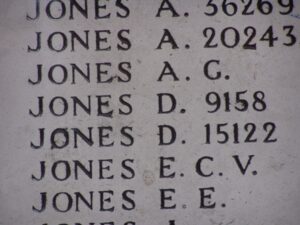
Daniel Jones, Private, 44531, Somerset Light Infantry. Daniel was the son of Evan and Sarah Jane Jones, of 2, River Row, Pontrhydyrun, Newport, Mon. He worked at one of the Tinplate Works at Llanelli prior to the war, and enlisted there into the King’s Shropshire Light Infantry. Daniel was later transferred into the 8th Battalion, Somerset Light Infantry, which was attached to 63 Brigade, 37th Division. The Division had been in France since July 1915, and had fought on the Somme the following year. During 1917 it fought at the Battle of Arras and at Third Ypres. During March 1918 the Division was at the Somme, and fought during the German Offensive, at the Battle of Albert. Daniel was killed during a period of stalemate, on 8 May 1918. He was 25 years old, and is buried at Couin New British Cemetery, France.
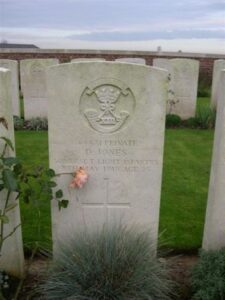
David Jones, Sergeant, 852, Canadian Infantry. David was born on 3 May 1880, the son of David and Elizabeth Jones, of Glenalla, College Hill, Llanelli. He had served with the 2nd Battalion, Welsh Regiment for six years, prior to emigrating to Canada. David enlisted in Canada on 1 September 1914, for some reason under the name of Donald Watkins, and joined the Princess Patricia’s Canadian Light Infantry. The Regiment moved to France via England soon after, and took up positions at Dickebusch, Ypres, by 6 January 1915. By May 1915 the battalion was at Polygon Wood, and suffered heavy shelling by the Germans, who were incessantly attempting to drive the Canadians from their positions. David was wounded by gas, and had his feet shattered by a German shell, so was evacuated to the Base Hospital at Boulogne for treatment. He died there on 13 May 1915, aged 35, and is buried at Boulogne Eastern Cemetery, France.
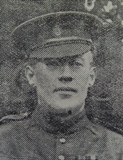
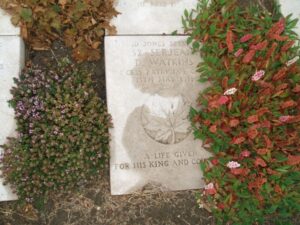
David Jones, Private, 15199, Royal Welsh Fusiliers. David was born at Llanelli, the son of John and Letitia Jones. The family later moved to 82, Primrose St., Ton-Y-Pandy (Rhondda), where David met and married his wife, Dinah Jones, and they lived at 53, Marian St., Clydach Vale. David enlisted at Tonypandy into the 10th Battalion, Royal Welsh Fusiliers, which was attached to 76 Brigade, 3rd Division. David was killed during German Diversionary Attacks on Ypres on 17 February 1916. He was 38 years old, and is commemorated on the Ypres (Menin Gate) Memorial, Belgium.
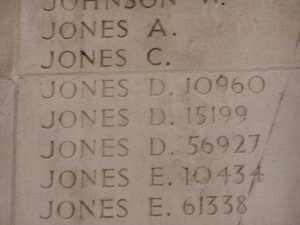
David Jones, Private, 31234, South Wales Borderers. David was the son of John and Mary Jones of Llanelli, and the husband of Myfanwy Jones, of 4, Arthur Street, Llanelli. He enlisted at Llanelli into the army, and was posted to the 10th Battalion, South Wales Borderers, which was in France attached to 115 Brigade, 38th (Welsh) Division. The Division had landed in France during December 1915 and had spent their first winter in the trenches near Armentieres. In June they marched south to the Somme, where they were tasked with the capture of Mametz Wood. The attack on the wood began on 7 July, but met with fierce resistance, and it took until 14 July to totally clear the wood. The Division suffered terrible casualties at Mametz, and were taken out of the line, and moved to Ypres to rebuild. Here they fought at the Battle of Pilckem Ridge, and the Battle of Langemarck. They then moved to Armentieres, where they remained from September 1917 until March 1918 when the German Spring Offensive was launched. The British had been over-run on the Somme, and so in April the Division was moved south, taking up positions North of Albert, from where they weathered the storm of the coming months. David was killed here on 9 May 1918. He was 36 years old, and is buried at Bouzincourt Communal Cemetery Extension, France.
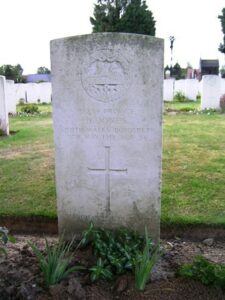
David Jones, Private, 14764, Welsh Regiment. David was born at Llanelli, and enlisted there into the 14th Battalion, Welsh Regiment, which was the Swansea battalion. The battalion moved to France on 2 December 1914 attached to 114 Brigade, 38th (Welsh) Division, and took part in several famous actions; at Mametz Wood in 1916, Pilckem Ridge in 1917, and the great advance from 21 August 1918. David was wounded during the final stages of the war, and returned to England, where he was hospitalised. He died of his wounds on 14 October 1918, and is buried at Capel Newydd Calvinist Methodist Chapelyard, Llanelli.
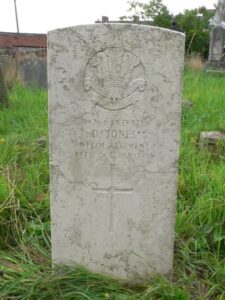
David Jones, Private, 14379, South Wales Borderers. David was born at Llanelli, and enlisted there into the 6th Battalion, South Wales Borderers. The battalion was the Pioneer battalion to the 25th Division, and had moved to France on 23 September 1915. The Division had fought on the Somme in 1916, and the following year saw much action at Passchendaele. During 1918 they suffered heavy casualties during the German Spring Offensive, before taking part in the great advance later that year. David was taken ill during the time of the Battle of the Selle, and died in hospital on 4 November 1918. He is buried at Terlincthun British Cemetery, Wimille, France.
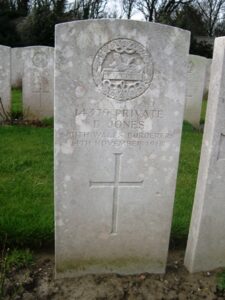
David Bowen Jones, Private, 51307, Royal Scots Fusiliers. David was born on 16 February 1889, the son of John Conwil Jones and Maria Jones, of Croesyceiliog. He was educated at Idole School, before training as a Tailor. David married Margaret Evans, of 52, Glenalla Road, Llanelli on 10 May 1915, and fathered a son, Raymond, before enlisting into the army at Llanelli on 17 April 1916. He was posted to the 3rd Battalion, Royal Scots Fusiliers, and embarked aboard the Troopship Aragon in December 1917, which was bound for Egypt. David was drowned when Aragon was torpedoed in the Mediterranean on 30 December 1917. He was 28 years old, and is commemorated on the Alexandria Chatby Memorial, Egypt.

David Edwin Jones, Sergeant, 27118, Royal Welsh Fusiliers. David was the son of David Abraham Jones and Hannah Jones, of 31, Princess Street, Llanelli. He enlisted at Holborn, London into the army, and was posted to France, where he joined the 17th Battalion, Royal Welsh Fusiliers. The battalion had been in France since December 1915, attached to 115 Brigade, 38th (Welsh) Division, and had fought at Mametz Wood in July 1916, and Pilckem Ridge the following year. They then moved to Armentieres, where they remained from September 1917 until March, 1918 when the German Spring Offensive was launched. The British had been over-run on the Somme, and so in April the Division was moved South, taking up positions North of Albert, from where they weathered the storm of the coming months, until the war turned during the Battle of Amiens, on 8 August 1918. The Germans had now lost the upper hand, and the British regained the lost ground on the Somme after an attack which began on 21 August, with the 38th Welsh in the midst of the attack during the Battle of Albert, and then moving east, where they fought at the Battle of Bapaume. Then the move began towards the mighty Hindenburg Line, and the Division carried on with their march east, fighting at the Battle of Havrincourt, and the Battle of Epehy. A short rest period ensued, during which time the Canal du Nord was breached, so opening a passage through the Hindenburg Line. The Division then fought at the Battle of Beaurevoir, and moved up towards Cambrai, capturing Villers-Outreaux. David was killed here on 8 October 1918. He was 30 years old, and is buried at Prospect Hill Cemetery, Gouy, France.
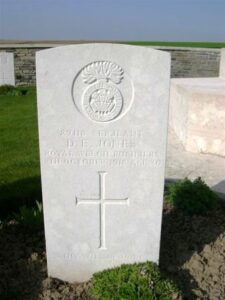
David Lewis Jones, Sergeant, 20124, Welsh Regiment. David was born at Ynyshir, Glamorgan. He worked at Llanelli prior to the war, and enlisted into the 15th Battalion, Welsh Regiment, which was known as the Carmarthen Pals battalion, attached to 114 Brigade, 38th (Welsh) Division. On 2 December 1915 the battalion moved to France, and the entire Division moved to the Fleurbaix sector, where it was initiated into trench warfare. During June 1916 the Division marched south to the Somme, and on 7 July 1916 attacked Mametz Wood. The initial attack failed, and it was three days later, on 10 July, that a fresh attack was mounted. After two days of heavy hand to hand fighting within the wood, the Germans withdrew, and the battered Welshmen moved via Hebuterne to Boesinghe, on the Yser Canal. David was wounded on 12 March 1917 when the 15th Welsh were shelled by the Germans at ‘Hill Top’, on the Yser Canal. He died of his wounds on 14 March 1917, and is buried at Mendinghem Military Cemetery, Belgium.
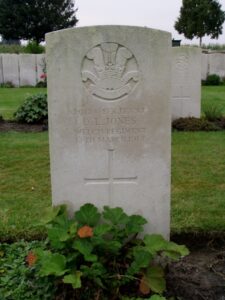
David Richard Jones, Gunner, 123893, Royal Garrison Artillery. David was the son of David and Elizabeth Jones, of 34, Lakefield Road, Llanelli. He enlisted at Port Talbot on 23 August 1916 into the Royal Garrison Artillery, and was posted to France on 23 March 1917 where he joined the 284th Siege Battery, RGA. David was wounded by gas shells during the Second Battle of Bapaume. He died of wounds at the 5th General Hospital on 3 September 1918, aged 31, and is buried at St. Sever Cemetery Extension, Rouen, France. He had been home on leave just two months prior to his death.
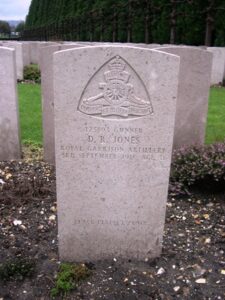
David Samuel Jones, Sergeant, 200436, Welsh Regiment. David was the son of David and Rosetta Jones, of 56, High Street, Llanelli. He enlisted at Carmarthen into the 1/4th Battalion, Welsh Regiment, which was the local Territorial Battalion, attached to 159 Brigade, 53rd (Welsh) Division. The Division landed at Cape Helles, Gallipoli, on 9 August 1915, and was immediately thrown into action, spending the next few days in isolated pockets, fighting against a Turkish counter-attack during the Battle of Sari Bair. The Division remained here throughout the coming months, and suffered severe losses in manpower strength during the great November 1915 blizzard on Gallipoli, when its total strength was reduced to less than that of a full-strength Brigade. On 11 December 1915 the Division was evacuated to Mudros, and by 23 December 1915 were moved to Egypt. They remained on the Suez Canal Defences for the next twelve months, where it took part in operations against the Sultan of Darfur, and in March 1917 took part in the advance into Palestine. David was wounded in Palestine, and died on 9 November 1917, aged 26. He is buried at Beersheba War Cemetery, Israel. His brother, Walter Thomas Jones, also fell.
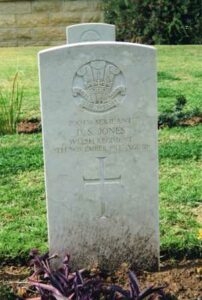
David Wynne Jones, Private, 5161, Welsh Regiment. David was the son of David Walter Jones and Jane Jones, of Castle Inn, Hall Street, Llanelli. He enlisted at Llanelli into the 1/4th Battalion, Welsh Regiment, which was the local Territorial Battalion, attached to 159 Brigade, 53rd (Welsh) Division. The Division landed at Cape Helles, Gallipoli, on 9 August 1915, and was immediately thrown into action, spending the next few days in isolated pockets, fighting against a Turkish counter-attack during the Battle of Sari Bair. David was killed here on 10 August 1915. He was 22 years old, and is buried at Green Hill Cemetery, Gallipoli.
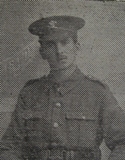
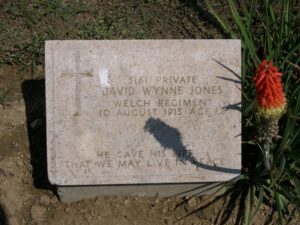
Ernest Jones, Stoker, 3794S, Royal Navy. Ernest was born at Pontardulais on 25 June 1896, the son of William and Mary Ann Jones. The family later resided at Maes-Yr-Haf, Bradford Street, Llanelli. Ernest served with the Royal Navy aboard HMS Defence. Defence was a Minotaur Class armoured cruiser, and had been built at Pembroke Dockyards. She saw extensive service around the world, and became the flagship of Rear Admiral Sir Robert Arbuthnot, leading the First Cruiser Squadron at the Battle of Jutland on 31 May 1916. Defence was blown apart by German gunfire at Jutland on 31 May 1916, and sank with the loss of all hands. Ernest was 19 years old when he died that day, and is commemorated on the Plymouth Naval Memorial, Devon.
Evan Jones, Sapper, 448158, Royal Engineers. Evan was born at Llangendeirne in 1887, the son of John Jones and Margaret Jones. He trained as a tailor before moving to Llanelli to set up his own business, and after marrying Mary Charles Harries in 1910, the couple initially settled at Llanegwad, Brynallt Terrace, Llanelli, before moving to 31, Ralph Terrace, Llanelli. Evan had played rugby at forward for the Llanelli Tuesdays Rugby team prior to the war. He had enlisted at Llanelli into the Welsh Field Company, Royal Engineers soon after the outbreak of war. The company was attached to the 53rd (Welsh) Division and embarked for the Mediterranean in July 1915, before landing at Gallipoli on 8 August, taking part in heavy fighting over the coming days. Evan had returned home at some time after, either through wounds or sickness, and upon recovering was drafted to France, joining the 9th Division Signal Company, Royal Engineers. In March 1918 the 9th Division was in the Cambrai area, and was one of the Divisions hit there by the German Spring Offensive, seeing heavy fighting at the Battle of St Quentin. Evan was wounded during the terrible fighting which ensued, suffering multiple gunshot wounds to his legs, and died in a Casualty Clearing Station on 11 April 1918. The 31-year-old is buried in Arneke British Cemetery, France. His brother, Ivor Sidney Jones, had been killed at Mametz Wood in 1916.

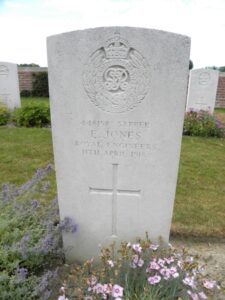
George Jones, Lance Corporal, 13306, South Wales Borderers. George was born at Llanelli, and enlisted there into the 4th Battalion, South Wales Borderers. The battalion was attached to 40 Brigade, 13th (Western) Division, and landed at Cape Helles, Gallipoli, during July 1915, relieving the 29th Division. They left and returned to Mudros at the end of the month, and the entire Division landed at ANZAC Cove from 3 August 1915. George was wounded here during the Battle of Russell’s Top, and died on 10 August 1915, aged 28. He is commemorated on the Helles Memorial, Gallipoli.
George Albert Jones, Private, 40819, New Zealand Rifle Brigade. George was born at Llanelli, but had emigrated to New Zealand prior to the war. He was the son-in-law of Mrs Kate Reid, of 226 Moorhouse Avenue, Christchurch, New Zealand. He enlisted there into the 1st Battalion, New Zealand Rifle Brigade, which fought at Gallipoli with the ANZAC’s, before moving to France, where it became part of the 3rd Brigade, New Zealand Division. George was killed during the time of the Battle of Langemarck, on 19 August 1917. He is buried at Prowse Point Military Cemetery, Belgium.
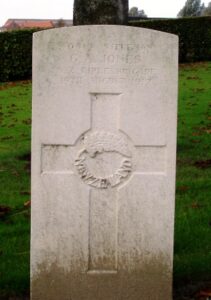
Gwilym Cyrus Jones, Private, 316107, Cheshire Regiment. Gwilym was the son of William Isaac and Muriel Jones, of 19, James Street, Llanelli. He enlisted there into the army, and was posted to the 9th Battalion, Cheshire Regiment, which was attached to 56 Brigade, 19th (Western) Division. The Division had moved to France during July 1915, and moved to positions near Loos. The Division fought during the opening attack of the Battle of Loos, and then moved to the Somme, where they took part in the second wave of the attack on Ovillers-La Boiselle on 1 July 1916, capturing the village at heavy cost, and fought through the Somme Battles of Pozieres and the Ancre in 1916. They then moved North to Ypres, taking part in the Battle of Messines, and fought on the Menin Road and at Polygon Wood, before moving up to Broodseinde, Poelcappelle and Passchendaele Village itself. In 1918 they were caught up in the German Spring Offensive near St. Quentin, where they suffered terrible casualties, and fought at the Battle of Bapaume. Gwilym was killed in action here on 27 March 1918, aged 19. He has no known grave, and so is remembered on the Arras Memorial, France.
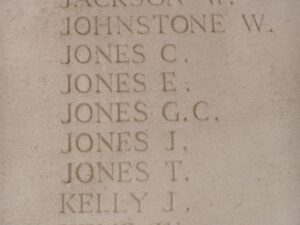
Gwilym Trevor Jones, MM & Bar, Private, 13367, Royal Welsh Fusiliers. Trevor was the son of William John Jones and Elizabeth Jones, of 8, Cilwrfa Row, Llanelli. He enlisted at Llanelli into the 9th Battalion, Royal Welsh Fusiliers, which was attached to 58 Brigade, 19th (Western) Division. The Division moved to France during July 1915, and moved to positions near Loos, where it took part in the opening attack of the Battle of Loos on 25 September 1915. The following year the Division moved to the Somme, where it took part in the second wave of the attack on Ovillers-La Boiselle on 1 July, capturing the village at heavy cost. It then fought through the Somme Battles of Poziéres and the Ancre in 1916. In 1917 the Division moved north to Ypres, taking part in the Battle of Messines. Trevor was killed here during an attack south of Hollebeke on 31 July 1917. He was 22 years old, and is commemorated on the Ypres (Menin Gate) Memorial, Belgium. Trevor must have been a brave man, as he was awarded the Military Medal twice during his time at war, for the Somme and for Messines Ridge.
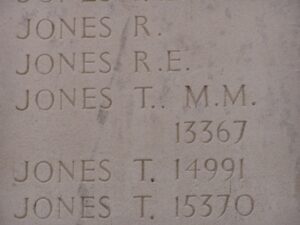
H. Jones, Seaman, Royal Navy. This man cannot presently be identified.
Harold Vivian Jones, Private, 54300, Welsh Regiment. Harold was the son of John Lewis Jones and Mary Harriet Jones, of Bridgend Inn, New Dock, Llanelli. He enlisted at Llanelli into the army, and was posted to France, probably during August 1916, where he joined the 15th Battalion, Welsh Regiment, which was known as the Carmarthen Pals battalion, attached to 114 Brigade, 38th (Welsh) Division. The battalion had recently moved via Hebuterne to Boesinghe, on the Yser Canal, where it remained until launching its attack on Pilckem Ridge on 31 July 1917. The 15th Welsh remained in the line, and also took part in the Battle of Langemarck, before the entire Division was moved to positions near Armentieres over the winter. After the Germans launched their offensive on the Somme on 21 March 1918, the Division was moved back to the Somme, and took up positions north of Albert, around Aveluy Wood. From 21 August 1918 the 15th Welsh drove bridgeheads across the River Ancre, and in the following days the Division captured Thiepval Ridge and Pozieres, before driving towards Longueval. Harold was wounded during the drive over the old Somme battlefields. He died on wounds on 1 September 1918, aged 20, and is buried at Varennes Military Cemetery, France.
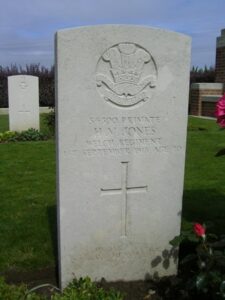
Harry Jones, Private, 15171, Devonshire Regiment. Harry was the son of Mrs. Mary Jones, of 42, Woodfield Terrace, Penrhiwceiber, Mountain Ash, Glam. He had been born at Llanelli, and served with the 10th Battalion, Devonshire Regiment, which was attached to 79 Brigade, 26th Division. The Division had moved to France in September 1915, but then sailed from Marseilles for Salonika, where it remained for the rest of the war. Harry took ill in Salonika, and was sent home, where he died on 1 October 1918, aged 27. He is buried at Box Cemetery, Llanelli.
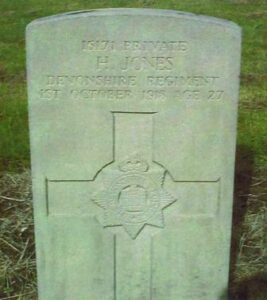
Harry Jones, Private, 13518, South Wales Borderers. Harry was the son of William Herbert and Delilah Jones, of 2, Sunning Hill Terrace, Llanelli. He had lived overseas for eight years before the war, returning home to enlist into the 2nd Battalion, South Wales Borderers. The Division had been in China at the outbreak of war, and after capturing the German held port of Tientsin, returned to Britain where they joined 87 Brigade, 29th Division. The Division moved to Gallipoli via Egypt, landing on 25 April 1915, and saw much action during their time there. Harry was wounded here during the Battle of Gully Ravine, and died on 29 June 1915. He was 24 years old, and is commemorated on the Helles Memorial, Gallipoli.
Henry Paul Mainwaring Jones, Lieutenant, Machine Gun Corps. Henry was born on 18 May 1896, the son of Harry Jones and Emily Margaret Jones (nee Mainwaring), of 29, Half Moon Lane, Herne Hill, London. His parents were both from Llanelli. Henry was educated at Dulwich, and had gained a scholarship to study languages at Balliol College, Oxford, but instead enlisted into the army, gaining a commission as Second Lieutenant into the Army Service Corps on 15 April 1915. He served with the 9th Cavalry Brigade in France from June 1915, before transferring to the Tank Corps in February 1917. He saw his first action with the Tank Corps during the Battle of Arras, and moved with his unit to Ypres in June 1917, in readiness for supporting the planned infantry assault on the opening day of the Third Battle of Ypres. Henry was killed in action during the opening day of the battle, on 31 July 1917, aged 21. He has no known grave and is commemorated on the Ypres (Menin Gate) Memorial, Belgium. A series of his letters home were published in a book after his death, entitled “War Letters of a Public School Boy’. Although Henry never lived in Llanelli, nor played rugby for any of the towns teams, he was a renowned rugby player, playing for the Dulwich College XV for three seasons and was made captain in his final year there.
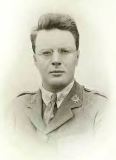
Ieuan James Jones, Private, 17875, Welsh Regiment. Ieuan was the son of Evan and Anne Jones, of 59, Pottery Street, Llanelli. He had been born at Aberavon, and enlisted there into the 14th Battalion, Welsh Regiment, which was raised as the Swansea battalion, and moved to France on 2 December 1914 attached to 114 Brigade, 38th (Welsh) Division. The entire Division moved to the Fleurbaix sector, where it was initiated into trench warfare. During June 1916 the Division marched south to the Somme, and on 7 July 1916 attacked Mametz Wood. The initial attack failed, and it was three days later, on 10 July, that a fresh attack was mounted. After two days of heavy hand to hand fighting within the wood, the Germans withdrew, and the battered Welshmen moved via Hebuterne to Boesinghe, on the Yser Canal. Ieuan must have been attached to the 6th or 2nd Welsh afterwards, as he was killed on the Somme on 5 November 1916, aged just 18. He is buried at Connaught Cemetery, Thiepval, France.
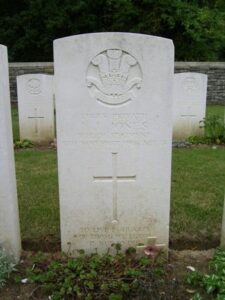
James Jones, Private, 27851, Welsh Regiment. James was the son of David Jones, of 42, Prospect Place, Llanelli. He had enlisted at Treharris into the Welsh Regiment, and was posted to France during the summer of 1915, where he joined the 2nd Battalion, Welsh Regiment, which was attached to 3 Brigade, 1st Division. The Division fought at the Battle of Loos in September 1915, and the following year fought on the Somme. They followed the German retreat to the Hindenburg Line in early 1917, and were then briefed for an operation on the Flanders Coast, and moved there during the summer of 1917. While training on the coast, the Battle of Third Ypres had stalled in the mire, and the Division were recalled to Ypres, where they fought at the Second Battle of Passchendaele. After spending another winter in Flanders, they were near Ypres when James was wounded. He died of his wounds on 13 March 1918, aged 40, and is buried at Mendinghem Military Cemetery, Belgium.
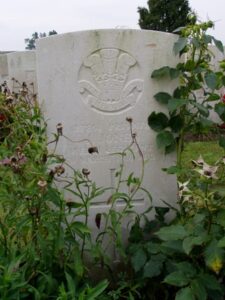
James Dawson Jones, Private, 4406, Welsh Regiment. James was born at Mold, and lived at Preswylfa Row, New Dock, Llanelli prior to the war. He enlisted at Llanelli into the 1/4th Battalion, Welsh Regiment, which was the local Territorial Battalion, attached to 159 Brigade, 53rd (Welsh) Division. The Division landed at Cape Helles, Gallipoli, on 9 August 1915, and was immediately thrown into action, spending the next few days in isolated pockets, fighting against a Turkish counter-attack during the Battle of Sari Bair. James was killed here on 16 August 1915, and is commemorated on the Helles Memorial, Gallipoli.
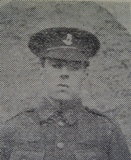
James Melville Jones, Lieutenant, Royal Field Artillery. James was the son of Doctor James Arthur Jones and Margaret Phillips Jones, of John Street, Llanelli. After the death of his father in 1897, his mother moved to Glynn, St. Albans Avenue, Bournemouth. James was studying medicine at Newcastle at the outbreak of war, and enlisted there into the Royal Field Artillery as a Gunner. He was commissioned as a Second Lieutenant on 17 November 1916, and posted to a Territorial battery in France. James was killed in action during the Third Battle of Ypres, on 27 August 1917, aged 29. He has no known grave and is commemorated on the Tyne Cot Memorial, Belgium.
John Jones, Private, 1067, Welsh Guards. John was the son of William John Jones and Elizabeth Jones, of 24, Caroline Street, Sea Side, Llanelli. He enlisted at London into the Welsh Guards after their formation on 26 February 1915, and was posted to the 1st Battalion, Welsh Guards, which moved to France in July 1915, joining the 3rd Guards Brigade, Guards Division. It remained on the Western Front throughout the war and saw its first major action during the Battle of Loos on 25 September 1915, remaining in the area during the coming months, where they also fought in the subsequent Action of Hohenzollern Redoubt. In July 1916 the Division moved to the Somme, where they fought at the Battle of Flers-Courcelette, and then at the Battle of Morval, capturing Lesboeufs Village. John was killed on the Somme on 19 November 1916. He was 20 years old, and is commemorated on the Thiepval Memorial, France. His brother William Jones also fell.
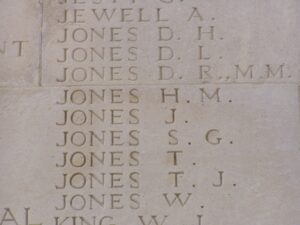
John Evan Jones, Private, 40670, Welsh Regiment. John was born at Llanbrynmair, Montgomery, the son of Griffith and Martha Jones. The family had moved to 10, Penrhiewtyn Street, Neath by 1911, and John came to find work at Llanelli prior to the war. He enlisted at Neath into the army, and was posted to France early in 1917, where he joined the 15th Battalion, Welsh Regiment, which was known as the Carmarthen Pals battalion, attached to 114 Brigade, 38th (Welsh) Division. The Division had famously captured Mametz Wood in July 1916, and the Pilckem Ridge at Ypres on 31 July 1917. The 15th Welsh remained in the line, and also took part in the Battle of Langemarck, before the entire Division was moved to positions near Armentieres over the winter. After the Germans launched their offensive on the Somme on 21 March 1918, the Division was moved back to the Somme, and took up positions north of Albert, around Aveluy Wood. From 21 August 1918 the 15th Welsh forged bridgeheads across the River Ancre, and the 38th Division then advanced, and captured Thiepval Ridge and Pozieres during the coming days. John was wounded around this time, and died on 29 August 1918, aged 20. He is buried at Bagneux British Cemetery, Gezaincourt, France.
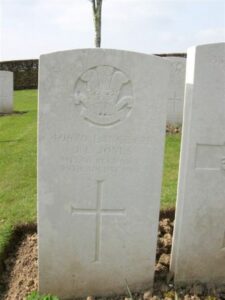
John Henry Jones, Sergeant, 20092, Welsh Regiment. John was born at Wellington, and resided at Llanelli prior to the war. He enlisted there during February 1915 into the 15th Battalion, Welsh Regiment, which was known as the Carmarthen Pals battalion, attached to 114 Brigade, 38th (Welsh) Division. On 2 December 1915 the battalion moved to France, and the entire Division moved to the Fleurbaix sector, where it was initiated into trench warfare. During June 1916 the Division marched south to the Somme, and on 7 July 1916 attacked Mametz Wood. The initial attack failed, and it was three days later, on 10 July, that a fresh attack was mounted. After two days of heavy hand to hand fighting within the wood, the Germans withdrew, and the battered Welshmen moved via Hebuterne to Boesinghe, on the Yser Canal, where it remained until launching its attack on Pilckem Ridge on 31 July 1917. The 15th Welsh remained in the line, and also took part in the Battle of Langemarck. John was killed here on 4 September 1917. He is commemorated on the Tyne Cot Memorial, Belgium.
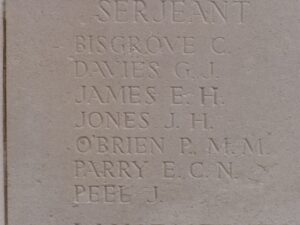
John Jonathon Jones, Sergeant, 1445, Australian Imperial Force. John was the son of Evan and Esther Jones, of Conwil Elvet, and was the brother of Thomas Jones, of Coldstream Street, Llanelli. He emigrated to Australia in 1896, and had served during the Boer War with the Australian Light Horse. At the outbreak of the Great War, John enlisted again, at Broadmeadows into the 13th Battalion, Australian Infantry. In December 1914 the battalion sailed from Albany to Egypt, where it became part of the 4th Brigade, 1st ANZAC Division, and landed at Anzac Cove, Gallipoli on 25 April 1915. John was wounded twice at Gallipoli, and was promoted Corporal. The battalion remained on Gallipoli until evacuation in December, and returned to Egypt. Here, the 4th Brigade was combined with the 12th and 13th Brigades to form the 4th Australian Division. In June 1916, the 13th sailed for France and the Western Front. Its first major action in France was at Pozieres in August, then during the attacks on Mouquet Farm. John suffered gunshot wounds to the thigh on the Somme on 30 August 1916, during the attack on Mouquet Farm, and was evacuated to the University War Hospital, Southampton. He died of his wounds there on 19 September 1916, aged 41, and was brought home for burial at Blaenycoed Congregational Chapelyard, Conwil Elfed. His brother Thomas also fell.
Joseph Henry Jones, Private, 125759, Machine Gun Corps. Joseph was the son of Joseph Henry Jones and Sarah Jane Jones, of 53, Old Castle Road, Llanelli. He enlisted at Llanelli into the Monmouthshire Regiment, but was later transferred into the 4th Battalion, Machine Gun Corps, which was attached to the 4th Division. In spring 1918 the Division fought at the First Battle of Arras, and were then moved back to Flanders, where they took part in the Battle of Hazebrouck. Joseph was killed in action on 22 April 1918, during the German Offensive there. He was 22 years old, and is commemorated on the Loos Memorial, France. His brother, Thomas John Jones, also fell.
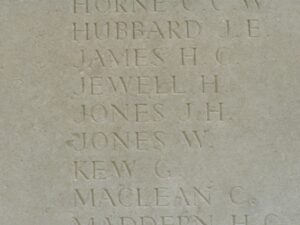
Mansel Lloyd Jones, Private, 18535, Royal Welsh Fusiliers. Mansel was the son of John Israel and Francis Elizabeth Jones, of 13, Coldstream Street, Llanelli. He enlisted at Merthyr Tydfil into the army, and was posted to France, where he joined the 2nd Battalion, Royal Welsh Fusiliers. The battalion had been attached to 19 Brigade since arriving in France, which had operated independently during the retreat from Mons to the Marne, and had then fought at First Ypres and at the Battle of Loos. By the summer of 1916, 19 Brigade was attached to 33rd Division, and moved to positions on the Somme. Mansel was killed here during the Battle of Bazentin Ridge, on 5 November 1916, fighting near Le Transloy Cemetery. He was 21 years old, and is commemorated on the Thiepval Memorial, France.
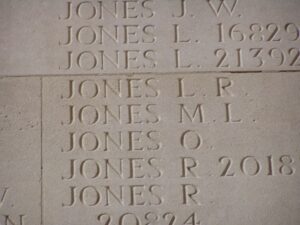
Oswald Glyn Jones, Sapper, 146924, Royal Engineers. Oswald was son of Thomas Daniel Jones, and Lizzie Jones, of 2, College Hill, Llanelli, and the husband of Gwladys Jones (nee Williams), of Pretoria, Glenalla Road, Llanelli. He enlisted at Llanelli into the Royal Engineers, and was posted to the 73rd Field Company, RE, which was in France attached to the 15th (Scottish) Division. During July 1915 the Division moved to France, and gained a reputation as one of the most formidable Divisions in the British Army. Here they fought at the Battle of Loos, and in Spring 1916, the Division was involved in German gas attacks near Hulluch. In July they moved to the Somme, where they took part in the Battle of Pozieres, and then fought at Battle of Flers-Courcelette, where they captured Martinpuich. In October they fought at the Battle of Le Transloy, and also in the Attacks on the Butte de Warlencourt. The Division followed the German retreat to Hindenburg Line early in 1917, and it was here that Oswald was wounded. He died of wounds on 29 March 1917, aged 24, and is buried at Duisans British Cemetery, Etrun, France.
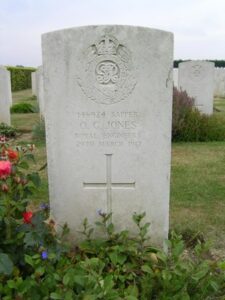
Richard Jones, Gunner, 124058, Royal Garrison Artillery. Richard was the son of George and Elizabeth Jones, of 22, Bigyn Road, Llanelli, and the husband of Mary Jones, of 3, Llanerch, Llanelli. He enlisted at Llanelli into the Royal Garrison Artillery, and was posted to France with 287th Siege Battery, RGA. Richard fought at Ypres, during the Battle of Passchendaele, and was wounded there during the latter stages of the offensive. He died of his wounds on 25 November 1917, aged 24, and is buried at Menin Road South Military Cemetery, Belgium.
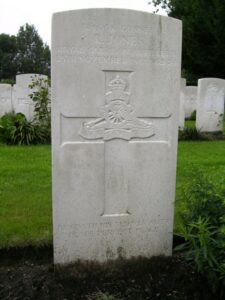
Robert Jones, Private, T/R/4/79292, Welsh Regiment. Robert was son of Robert and Emily Jones, of Abertillery, and the nephew of T. R. James of Llanelli. He married Annie Mary Lewis, of 3, Lake View, Furnace, Llanelli prior to enlisting at Carmarthen into the 53rd Battalion, Welsh Regiment, which was part of 14th Reserve Brigade. Robert died on home service while at Kinmel Park on 16 October 1918, aged just 18. He is buried at Box Cemetery, Llanelli.
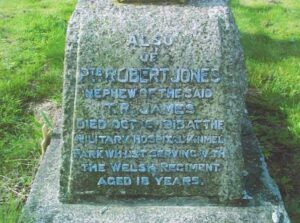
Samuel Jones, Private, 79052, King’s Liverpool Regiment. Samuel was born at Llanelli, and enlisted there into the army. He was posted to the 26th Battalion, King’s Liverpool Regiment, which was attached to 218 Brigade, 73rd Division. Samuel must have been attached to a Labour Battalion in France, as he took ill and died during the time of the German retreat to the Hindenburg Line, on 5 April 1917. He is buried at Ste. Marie Cemetery, Le Havre, France.
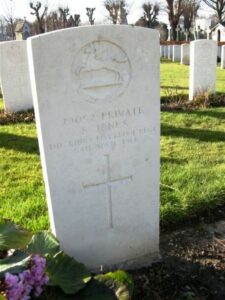
Sydney Jones, Private, 227535, Monmouthshire Regiment. Sydney was the son of Thomas and Francis Jones, of 25, Upper William Street, Llanelli. He enlisted at Llanelli on 15 February 1916 into the Monmouthshire Regiment, and landed in France on 16 June 1917. Sydney was then posted to the 6th Battalion, South Wales Borderers, which was attached to the 25th Division, as divisional pioneers. The division was at Messines, and took part in the famous Battle of Messines during June and July 1917. Sydney was killed there on 19 July 1917, aged 25. He is buried at Dickebusch New Military Cemetery Extension, Belgium.
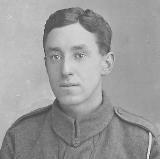
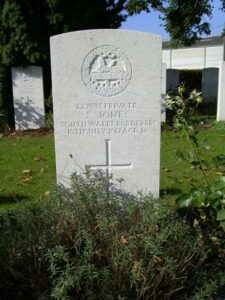
Thomas Jones, Private, 14141, South Wales Borderers. Thomas was the son of Evan and Esther Jones, of Conwil Elfed, and the husband of Margaret Jane Jones, of Bryn Awel, Clifton Terrace, Llanelli. He enlisted at Llanelli into the 5th Battalion, South Wales Borderers, which was attached to 58 Brigade, 19th (Western) Division. The Division crossed to France during July 1915, and moved to positions near Loos, where it took part in the opening attack of the Battle of Loos on 25 September 1915. It remained in the area over the winter. Thomas was killed in a mineshaft that was countermined by the Germans on 14 March 1916. He was 41 years old, and is commemorated on the Loos Memorial, France. His brother, John Jonathan Jones also fell.
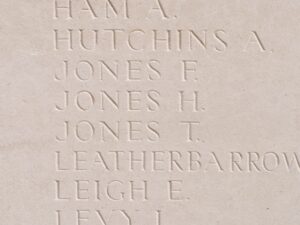
Thomas Jones, Private, 203961, Yorkshire Light Infantry. Thomas was the son of Mary Ann Lewis, of 31, Caroline Street East, Sea Side, Llanelli. He enlisted at Lincoln into the 2/4th Battalion, Yorkshire Light Infantry, which was attached to 187 Brigade, 62nd (2nd West Riding) Division. The Division concentrated on the Western Front by 18 January 1917, and took part in Operations on the Ancre. In March 1917 the Division followed the German Retreat to the Hindenburg Line, and then fought at the Battle of Arras, during the Flanking Operations Round Bullecourt. Thomas took ill around this time, and died on 8 June 1917. He is buried at Adanac Military Cemetery, Miraumont, France.
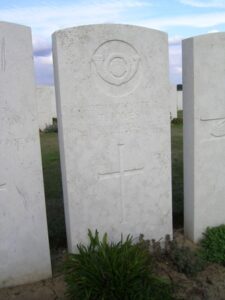
Thomas Jones, Lance Sergeant, 212, Welsh Guards. Thomas was born at Llangattock, and resided at Llanelli prior to the war. He enlisted at Newport into the Grenadier Guards, and on 26 February 1915 became one of several hundred Grenadiers to transfer into the newly formed Welsh Guards. The 1st Battalion, Welsh Guards moved to France during July 1915, where it joined 3rd Guards Brigade, Guards Division. The Division saw its first major action during the Battle of Loos on 25 September 1915, remaining in the area during the coming months, where they also fought in the subsequent Action of Hohenzollern Redoubt. In July 1916 the Division moved to the Somme, where they fought at the Battle of Flers-Courcelette. Thomas was killed here on 10 September 1916. He was 27 years old, and is commemorated on the Thiepval Memorial, France.
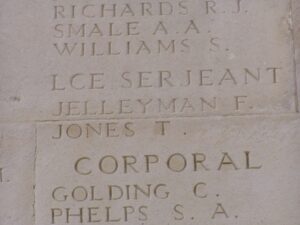
Thomas David Rees Jones, Private, 4039, Welsh Regiment. Thomas was born at Rhymney in 1895, and lived with his uncle and aunt, William and Mary Thomas, at King’s Square, Llanelli by 1911. He enlisted at Llanelli into the 1/4th Battalion (Carmarthen), Welsh Regiment, and embarked with the Battalion for Gallipoli, attached to 159 Brigade, 53rd (Welsh) Division in July 1915. The Division landed at Gallipoli on 9 August 1915 and was immediately lunged into heavy fighting against strongly entrenched Turkish positions. Thomas was killed here on 10 August 1915 during the attack on Scimitar Hill. He was 19 years old, and is commemorated on Panel 140-144 of the Helles Memorial, Gallipoli.
Thomas Esmor Jones, Lieutenant, Royal Welsh Fusiliers. Thomas was the son of the Rev. Evan Talfryn Jones and Annie Jones, of 10, Goring Road, Llanelli. Thomas was commissioned into the Royal Welsh Fusiliers, and was posted to the 4th Battalion (Denbighshire), Royal Welsh Fusiliers, which was the Pioneer Battalion to the 47th (2nd London) Division. The Division moved to France during March 1915, and saw its first major action at the Battle of Aubers, and the Battle of Festubert during May 1915. They fought at the Battle of Loos in September. They were north of Arras in the spring of 1916 when the Germans attacked Vimy Ridge, and then fought at the Battle of the Somme that year. Early in 1917 the Division moved north to Belgium, and took part in the Battle of Messines, and then in November 1917 fought at the Battle of Cambrai. In March 1918 the Division were situated near St. Quentin, and faced the German Spring Offensive here on 21 March, fighting at the Battle of St Quentin, and then in the rearguard action at the First Battle of Bapaume. Thomas was killed here on 6 April 1918. He was 21 years old, and is commemorated on the Pozieres Memorial, France.
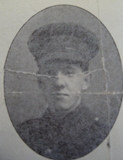
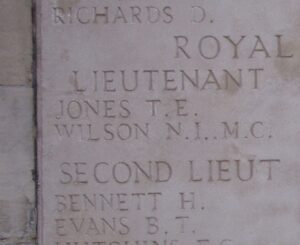
Thomas H. Jones, Sergeant, 25214, Royal Flying Corps. Thomas was from Llanelli, and served with 18 Squadron, Royal Flying Corps. On 22 September 1916 he was flying as an observer in FE2b, Serial 6937, which was piloted by Lieutenant F. Hewson, when their aeroplane was attacked by German fighters, and shot down over Ervillers. Thomas was seriously wounded and taken prisoner by the Germans, but died in Hospital at Cambrai on 29 September 1916, as a POW. He is buried at St. Souplet British Cemetery, France.
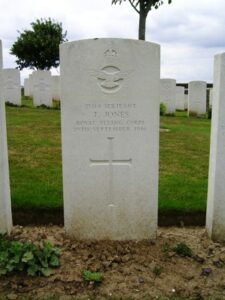
Thomas John Jones, Private, 25228, South Wales Borderers. Thomas was the son of Thomas John and Sarah Jones, of 53, Old Castle Road, Llanelli. He worked at the Old Castle Works prior to enlisting into the Welsh Regiment. He was then posted to the 12th Battalion, South Wales Borderers, which was attached to 119 Brigade, 40th (Bantam) Division. The Division moved to France between the 1st and 9th June, and moved to the front near Loos. Late in 1916 they moved south to the Somme, and fought at the Battle of the Ancre, and remained in the area over the winter. In March, 1917 the Germans withdrew to their shortened line, called the Hindenburg Line, and the 40th Division were one of the Divisions that followed the withdrawal. Later in the year they took part in the Battle of Cambrai, playing an important role in the attack on Bourlon Wood. Thomas was killed here on 25 November 1917, aged 25. He has no known grave, and is commemorated on the Cambrai Memorial, Louverval, France. His brother, Joseph Henry Jones, also fell.
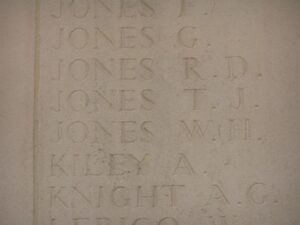
Thomas John Jones, Lance Corporal, 4232, Welsh Regiment. Thomas was born at Llanelli, and enlisted there into the 1/4th Battalion, Welsh Regiment, which was the local Territorial Battalion, attached to 159 Brigade, 53rd (Welsh) Division. The Division landed at Cape Helles, Gallipoli, on 9 August 1915, and was immediately thrown into action, spending the next few days in isolated pockets, fighting against a Turkish counter-attack during the Battle of Sari Bair. After being evacuated from Gallipoli, the Division spent twelve months in Egypt taking part in operations against the Sultan of Darfur. Thomas died of dysentery in Egypt on 26 April 1916. He is buried at Cairo War Memorial Cemetery, Egypt.
Vincent James Jones, Private, 56173, Royal Army Medical Corps. Vincent was born at Worcester, the son of Llewelyn and Jessie Jones. The family later resided at 4, Charles Street, Marble Hall, Llanelli. Vincent enlisted at Worcester on 22 February 1915 into the Royal Army Medical Corps, and was posted to France with the 65th Field Ambulance, RAMC, which was attached to the 21st Division. The Division crossed to France during September 1915, and saw its first major action within days, at the Battle of Loos. They moved south to the Somme in 1916, and fought there throughout the offensive. In March 1917 they followed the German Retreat to the Hindenburg Line, and in April fought at Arras, before moving to Ypres, and taking part in the Battle of Passchendaele, before moving again, and taking part in the Battle of Cambrai. The division was one of the units hit by the German Spring Offensive on the Somme in March 1918, suffering heavy casualties before being evacuated to Flanders to rest. Unluckily though, the Germans launched a fresh offensive on the Lys in April 1918, and the division was caught up in the thick of the fighting again. The battered division moved south to rebuild, but again was unlucky, as the Germans launched a fresh offensive on the Chemin-des-Dames, and the division was caught up in the action again, before moving north to the Somme sector, where they took part in the great offensive which ended the war. Vincent was killed during the Battle of Epehy, on 18 September 1918. He was 22 years old, and is buried at Gouzeaucourt New British Cemetery, France.
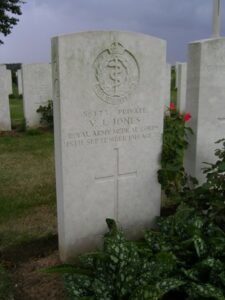
Walter Jones, Private, 45339, Welsh Regiment. Walter was born at Llanelli. He enlisted at Ogmore Vale into the army, and was posted to France, where he joined the 9th Battalion, Welsh Regiment, which was attached to 58 Brigade, 19th (Western) Division. The Division moved to France during July 1915, and moved to positions near Loos, where it took part in the opening attack of the Battle of Loos on 25 September 1915. The following year the Division moved to the Somme, where it took part in the second wave of the attack on Ovillers-La Boiselle on 1 July, capturing the village at heavy cost. It then fought at the Battle of Poziéres. Walter was wounded here, and died on 22 August 1916. He is buried at Dernancourt Communal Cemetery Extension, France.
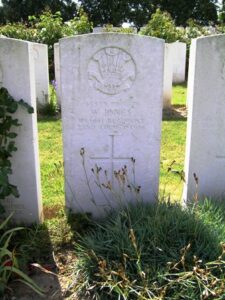
Walter Thomas Jones, Private, 201556, Welsh Regiment. Walter was the son of David and Rosetta Jones, of 56, High Street, Llanelli. He enlisted at Llanelli into the 4th Battalion, Welsh Regiment, and was posted to Salonika, to join the 11th Battalion, Welsh Regiment, which was attached to 67 Brigade, 22nd Division. Walter was killed in Salonika on 3 August 1917, aged just 19. He is buried at Karasouli Military Cemetery, Greece. His brother, David Samuel Jones, also fell.
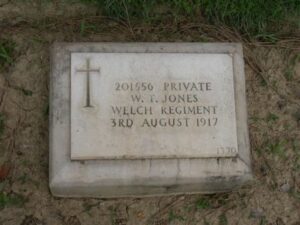
William Jones, Private, 63092, Welsh Regiment. William was born at Llanrhug, Carnavonshire, and must have worked at Llanelli prior to the war, enlisting there into the army. He was posted to France, where he joined the 15th Battalion, Welsh Regiment, which was known as the Carmarthen Pals battalion, and was attached to 114 Brigade, 38th (Welsh) Division. William probably joined the battalion after its move from Armentieres to the Somme in April 1918. The 38th Division held the line north of Albert, around Aveluy Wood, from April 1918 until launching its assault across the River Ancre on 21 August 1918. The 15th Welsh waded the River Ancre at night, creating two bridgeheads for the remainder of 114 Brigade to cross, before assaulting the German positions on Thiepval and Poziéres Ridge. Over the coming days the Division drove towards Longueval and beyond. William was killed during the Second Battle of Bapaume, on 1 September 1918. He is buried at Guards Cemetery, Lesbouefs, France.
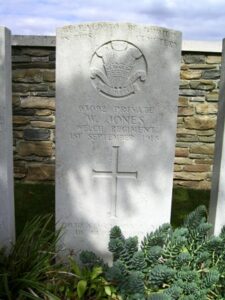
William Jones, Private, 50260, South Lancashire Regiment. William was the son of William John and Elizabeth Jones, of 24, Caroline Street, Llanelli. He enlisted at Llanelli into the army, and was posted to the 2nd Battalion, South Lancashire Regiment, which was in France attached to 64 Brigade, 21st Division. They moved to the Somme in 1916, and fought at the Battle of the Somme. In March 1917 they followed the German Retreat to the Hindenburg Line, and in April fought at Arras, during the First Battle of the Scarpe, the Third Battle of the Scarpe, and the Flanking Operations Round Bullecourt. Later in 1917 they were moved to Ypres, and took part in the Battle of Passchendaele. William was killed at Ypres on 17 September 1917. He was 19 years old, and is buried at Ypres Reservoir Cemetery, Belgium. His brother John Jones also fell.
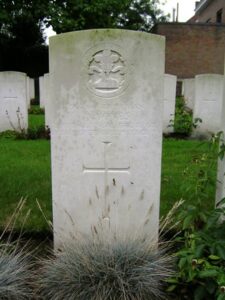
William Jones, Private, 21569, Royal Welsh Fusiliers. William was born at Llanelli, the son of Owen and Margaret Jones. The family later moved to Bryn Mair, Talsarnau, Merioneth. William enlisted at Finsbury Barracks, London into the 15th Battalion, Royal Welsh Fusiliers, which was raised as the London Welsh battalion, and moved to France on 2 December 1915 attached to 113 Brigade, 38th (Welsh) Division. The Division spent the next few months holding various sectors of the front from Fleurbaix to Givenchy, before marching south to the Somme in June 1916. On 7 July 1916 the Division launched its first assault on Mametz Wood. William was one of hundreds of men killed that day. He was 21 years old, and is commemorated on the Thiepval Memorial, France.
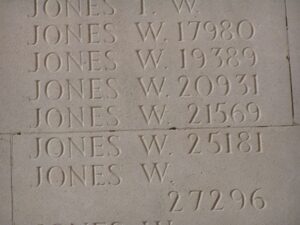
William Jones, Private, 235049, Royal Welsh Fusiliers. William was the son of Isaac and Elizabeth Jones, of 2, Richmond Terrace, Llanelli. He enlisted at Llanelli into the South Wales Borderers on 6 September 1916, before being posted to France on 2 April 1917, where he joined the 10th Battalion, Royal Welsh Fusiliers. The battalion had landed at Boulogne on 27 September 1915 with 76 Brigade, and joined the 3rd Division the following month. In May 1917 the Division fought at the Battle of Arras, and William was wounded here, suffering a bullet in his thigh. He returned to action in time to take part in the Battle of Polygon Wood. William was killed at Polygon Wood on 26 September 1917. He was 24 years old, and is commemorated on the Tyne Cot Memorial, Belgium.
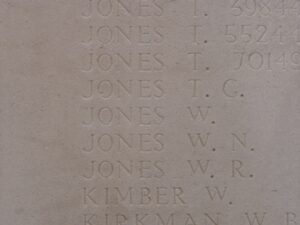
William Benjamin Jones, Private, 14135, South Wales Borderers. William was the son of Albert and Jemima Jones, of 14, Cornish Place, New Dock, Llanelli. He enlisted at Llanelli into the 7th Battalion, South Wales Borderers, which was attached to 67 Brigade, 22nd Division. The Division crossed to France in early September 1915, but on 27 October 1915 the Division embarked at Marseilles for Salonika, where it remained for the rest of the war. William was wounded here during the Second Battle of Doiran, on 20 September 1918. He died of his wounds on 20 September 1918, aged 22, and is buried at Karasouli Military Cemetery, Greece.
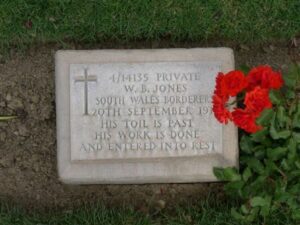
William John Jones, Corporal, 371436, London Regiment. William was the son of William and Hannah Jones, of 13, Andrew Street, Llanelli. He enlisted at Llanelli into the army, and was posted to France with the 8th Battalion, London Regiment, which was known as the Post Office Rifles. On 18 March 1915 the battalion landed at Le Havre, and two months later its formation was renamed 140 Brigade, 47th (2nd London) Division. The Division fought at the Battle of Aubers, and the Battle of Festubert during May 1915 and in September fought at the Battle of Loos, and subsequent Action of Hohenzollern Redoubt. They were north of Arras when the Germans attacked Vimy Ridge on 21 May 1916, and William was killed that day. He was 25 years old, and is commemorated on the Arras Memorial, France.
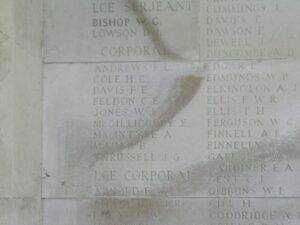
John Rhys Joseph, Lieutenant, Royal Flying Corps. John was the son of William and Christianna Joseph, of 60, Ann Street, Llanelli. John was commissioned into the Royal Flying Corps on 20 April 1917. He was posted to Scotland with 26 Reserve Squadron, RFC, and was killed there during a flying accident on 23 April 1917. John was just 18 years old, and is buried at Edinburgh (Comely Bank) Cemetery, Scotland.
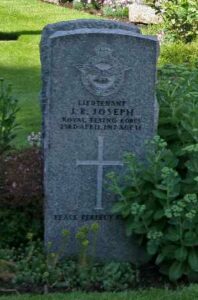
Albert Augustus Kelly, Able Seaman, R/4177, Royal Naval Reserve. Albert was born at Shepherd’s Bush on 1 December 1887. He enlisted on 18 November 1915 into the army, and married Lily May Bowen, of 31 Swansea Road, Llanelli, at Llanelli in June 1917, before being posted to France on 18 October 1917, joining Hawke Battalion. The battalion was attached to 189 Brigade, 63rd (Royal Naval) Division. Albert fought with the Division at the Battle of Cambrai, but took ill from pneumonia, and was admitted to the 150th RN Field Ambulance on 11 January 1918. He died at 48th Casualty Clearing Station from Pneumonia on 16 January 1918, aged 30, and is buried at Rocquigny-Equancourt Road British Cemetery, Manancourt, France.
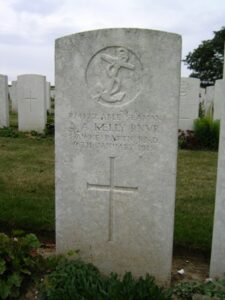
Simon Kelly, Private, 10703, Irish Guards. Simon was the son of Cornelius and Bridget Kelly, and the brother of Cornelius D. Kelly, of Spunkane East, Waterville, Co. Kerry. He lived at Llanelli prior to the war, and enlisted at Carmarthen in August 1914 into the Irish Guards. Simon was not posted to France until 1916, joining the 2nd Battalion, Irish Guards, which was attached to the 2nd Guards Brigade, Guards Division. Simon was killed in action during the Battle of Morval, on 26 September 1916, aged 26. He is commemorated on the Thiepval Memorial, France.
Robert James Kemp, Private, 423306, London Regiment. Robert was the husband of Catherine Jane Kemp (nee Lewis), of 3, Brickyard Cottages, New Dock, Llanelli. He enlisted at Llanelli into the 4th Welsh, but was later posted to the 2/10th Battalion, London Regiment, which was known as the Hackney battalion, and was attached to 175 Brigade, 58th (2/1st London) Division. On 4 February 1917 the battalion landed at Le Havre, and followed the German Retreat to the Hindenburg Line in March. They then took part in the Flanking Operations Round Bullecourt. Later that year they moved north to Ypres, and took part in the Battle of the Menin Road, the Battle of Polygon Wood and the Second Battle of Passchendaele. In March 1918 the Division was positioned around St. Quentin, and was caught up in heavy fighting during the German Spring Offensive of 21 March. In August 1918 the Allies pressed an attack towards Villers Brettoneux, as part of the Battle of Amiens, and later in the month the Division also took part in the Battle of Albert which helped turn the war. Robert was wounded here, and died on 13 August 1918. He was 33 years old, and is buried at Pernois British Cemetery, Halloy-Les-Pernois, France.
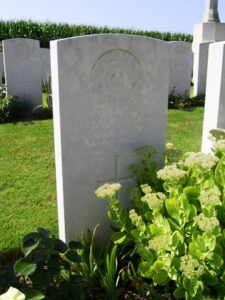
David James Kendrick, Officer’s Cook 2nd Class, L/9688, Royal Navy. David was born on 31 March 1884, the son of James and Margaret Kendrick, of Llanelli. He married Eliza Beynon at Narberth in June 1911, and the couple lived at 33, Rope Walk Road, Llanelli. David served aboard HMS Vala, which was a Q Ship, based at Milford Haven. The Q-Ships were trawlers, which had hidden guns, and were used to lure German submarines to their doom. Vala had an eventful was, but was sunk by the German submarine U-54 off Ireland on 21 August 1918, with the loss of all hands. David was 33 years old when he died that day, and is commemorated alongside his shipmates on the Plymouth Naval Memorial, Devon.
George Daniel King, Lance Corporal, 13523, Royal Welsh Fusiliers. George was the son of Charles and Eleanor King, of 123, Botley Road, New Botley, Oxford. He must have worked at Llanelli prior to the war, as he enlisted there into the 9th Battalion, Royal Welsh Fusiliers, which was attached to 58 Brigade, 19th (Western) Division. The Division moved to France during July 1915, and moved to positions near Loos, where it took part in the opening attack of the Battle of Loos on 25 September 1915. George was wounded that day, and died on 27 September 1915, aged 27. He is buried at Chocques Military Cemetery, France.
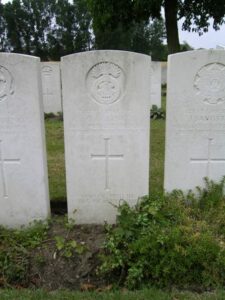
William King, Gunner, 62647, Royal Field Artillery. William was born at Panteg in 1881. He married Ellen Etta Lucas, of Biddulph Street, New Dock, Llanelli in 1899, and the couple moved to 44, Commercial Street, Griffithstown, Newport, Monmouth, where their three daughters were born. William had served Gallipoli before moving to France with the 92nd Battery, Royal Field Artillery. The battery was on the Somme in the summer of 1916, when William suffered a heart attack and died on Sunday 15 July 1916. He was 35 years old, and is buried at Englebelmer Communal Cemetery, France.
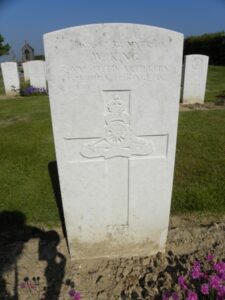
Samuel Kirkpatrick, Private, 9017, Welsh Regiment. Samuel was the son of Samuel and Margaret Fitzpatrick of Risca. He was a regular soldier, and had lived at Llanelli prior to the war. At the outbreak of war he went to France with the 2nd Battalion, Welsh Regiment, which was attached to 3 Brigade, 1st Division. The Division fought at Mons, and the subsequent retreat to the Marne. Here the German advance on Paris was stopped, and the BEF drove the Germans back north to the Aisne. Here, the 2nd Welsh made a famous charge at Chivy Ridge on 14 September 1914, and it was during this attack that Samuel was killed on 26 September 1914, aged 27. He is commemorated on the La Ferte-Sous-Joarre Memorial, France.
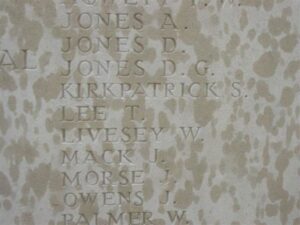
Frederick Knibbs, Lance Corporal, 13086, Royal Welsh Fusiliers. Frederick was born on 15 April 1889, the son of Frederick Knibbs and Sarah Knibbs (nee Pearson), of 30, Rock Hill, Chipping Norton, Oxon. He first came to Wales in 1907 whilst working for the Great Western Railway at Llanhilleth, but then left to work at the Batchelor’s De-Tinning Works at Llanelli. Frederick was a skilled footballer, who had played for Llanelli Town. He enlisted there soon after the outbreak of war into the 9th Battalion, Royal Welsh Fusiliers. The battalion had formed at Wrexham in September 1914, before moving to Tidworth to join 58 Brigade, 19th (Western) Division. On 19 July 1915 Evan landed in France with the battalion, and the entire 19th Division then moved to the Nursery Sector at Calonne for trench initiation alongside the Dehra Dun Brigade. The infantry battalions of the division then began carrying out the usual routines of rotating in the trenches: four days in the front line; four in support; and four in reserve, interspersed with training regimes and carrying out working parties and trench raids. Just south, the British launched a great offensive around the town of Loos on 25 September 1915, and the 19th Division was ordered to attack from its positions at the same time, to attempt to draw enemy attention away from the main battle area. The attacking battalions of the 19th Division were in place by 04.00, and then at 05.50 the men climbed out of their trenches to launch their assault, behind a gas and smoke screen. The assault was a disaster, and heavy casualties were suffered by the 19th Division for no gain. Frederick was wounded during the assault, and was evacuated to the 2nd Canadian General Hospital at Le Treport, where he died of his wounds on 28 September 1915. The 26-year-old is buried in Le Treport Military Cemetery, France.
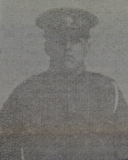
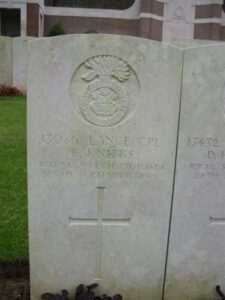
John Knill, Private, 118303, Machine Gun Corps. John was the son of Thomas John and Bessie Knill, of 9, Sandy gate Terrace, Llanelli. He married May Ryan in 1911, and the couple set up home at Erw Fach, Pwll, where they raised three children. John enlisted at Pembrey into the Welsh Regiment, but was posted to the North Lancashire Regiment. John was then transferred to the 59th Battalion, Machine Gun Corps, which was attached to the 59th (2nd North Midland) Division. John was killed during the German Spring Offensive, at the Battle of St. Quentin, on 21 March 1918, aged 28. He is buried at Ontario Cemetery, Sains-Le-Marquion, France.
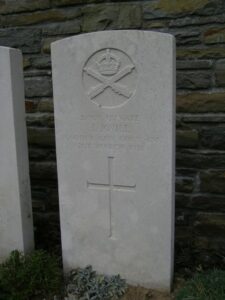
John William Albert Kydd, Second Lieutenant, Lancashire Fusiliers. John was born on 17 September 1898, the son of David and Mary Helen Fraser Kydd, of Tyrfran, Llanelli. He was commissioned into the Lancashire Fusiliers on 31 July 1917, and posted to France where he joined the 19th Battalion, Lancashire Fusiliers. The battalion was the Pioneer battalion to the 49th (West Riding) Division. John joined the Division at Ypres, and took part in the Battle of Poelcapelle that year. The Division remained in Flanders over the final winter of the war, working on trench construction in the Zonnebeke sector during March 1918. On 26 March 1918 John was with B Company of the battalion at work on the construction of Patoka Trench when they came under artillery fire, killing John and wounding two other ranks, and forcing the survivors to withdraw. John was 19 years old, and is buried at Menin Road South Military Cemetery, Belgium. He is commemorated on the Pentip School War Memorial.
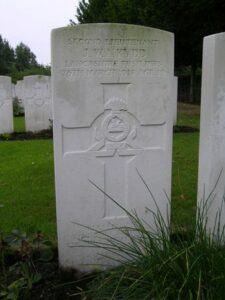
Reginald Charles Lambert, Private, 20409, Oxfordshire and Buckinghamshire Light Infantry. Reginald was the son of Hezekiah and Susan Lambert, of Sherborne, Dorset. He probably worked at Llanelli prior to the war, as he enlisted there into the army. Reginald was posted to France, where he joined the 2/1st Battalion, Ox and Bucks Light Infantry, which was attached to 184 Brigade, 61st (2nd South Midland) Division. The Division moved to France during 21 May 1916, moving to positions at Fromelles. The first major action in which the Division was engaged turned out to be a disaster. An attack was made on 19 July 1916 at Fromelles, a subsidiary action to the much larger battle taking place further south on the Somme. The Division suffered very heavy casualties for no significant gain and no enemy reserves were diverted from the Somme. Such was the damage to the Division and its reputation that it was not used again other than for holding trench lines until 1917. Reginald became ill, and died on 18 January 1917, aged 27. He is buried at Puchevillers British Cemetery, France.
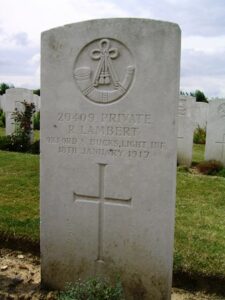
James Law, Private, Welsh Regiment. James was the son of David and Mary Law, of Bynea. Not much is presently known about him, but he is buried with his parents and sister at Box Cemetery, Llanelli. The headstone is worn, but shows that he died on 20 August 1918, aged 20, and had served with the 4th Welsh.
William Laviers Lee, Private, 29867, Royal Welsh Fusiliers. William was born at Llanelli in 1892, the son of James and Margaret Lee. The family later moved to 53, Station Street, Maesteg, and William enlisted at Abergavenny on 29 November 1915 into the Welsh Regiment. On 12 July 1916 he landed in France, and was posted to the 9th Battalion, Royal Welsh Fusiliers, which was attached to 58 Brigade, 19th (Western) Division. The Division had just suffered terrible casualties during the opening stage of the Somme offensive, where it had atken part in the second wave of the attack on Ovillers-La Boiselle on 1 July. it then fought through the Somme Battles of Poziéres and the Ancre in 1916. William was killed at the Battle of Le Transloy, on 26 October 1916, aged 24. He is buried at Regina Trench Cemetery, Grandcourt, France.
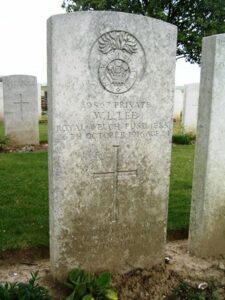
Hugh Charles Lennon, Master Gunner, 24325, Royal Garrison Artillery. Hugh was the son of William and Frances Lennon, of 37, Croydon Road, Elmer’s End, Beckenham, Kent. He married Justina Sophia Griffiths, of Laugharne, at Battle in March 1910, and the couple lived at 2, Station Road, South Cerney, Glos. Hugh was a regular soldier, and must have lived at Llanelli at some time. During the Great War he was attached to the Royal Artillery Staff in India, and died there on 6 June 1918 after becoming ill. Hugh was 35 years old, and is buried at Peshawar. He is also commemorated on the Delhi Memorial (India Gate), India. He was the holder of the Long Service and Good Conduct Medal.
Arthur Frederick Lewis, Pioneer, 349630, Royal Engineers. Arthur was the son of Arthur John Lewis and Margaret Lewis, of 10 Wood End Road, Llanelli. He enlisted at Llanelli on 25 February 1916 into the Royal Engineers, and was posted to their 4th Reserve Battalion, stationed at Kinmel Park. Arthur married Annie Mary Thomas, on 27 June 1918, before returning to Kinmel Park. Arthur became ill with pneumonia whilst training, and died in Hospital at Kinmel Park on 5 November 1918. He was 22 years old, and is buried at Box Cemetery, Llanelli.
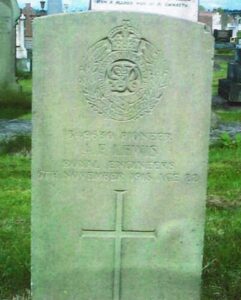
Cyril William Victor Lewis, Lieutenant, Middlesex Regiment. Cyril was born on 20 June 1893, the son of William Henry and Rachel Lewis, of York House, Llanelli. Cyril started his schooling at Llanelli, before receiving his education at Llandovery from 1906 until 1912. While at Llandovery he won a Scholarship to St. John’s College, Oxford, and it was there, while a student, that he volunteered for the Army in 1914. He was commissioned into the Middlesex Regiment, and served in France with the 1st Battalion, which was attached to 98 Brigade, 33rd Division. After 18 in France Cyril was wounded, and returned home for treatment. In September 1917 he took a draft of men to Ireland, and on his return visited Llanelli before setting off for Chatham. On 3 October 1917 Cyril was killed during a firing practice when a faulty cartridge back-fired, breaking the bolt of his rifle and piercing his neck. He was 24 years old, and was buried with full military honours at Llanelli Church Cemetery on 8 October 1917. Cyril had two brothers, namely Cecil and Lewis Lewis, both of whom served with the Welsh Regiment in France.
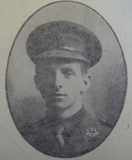
D. J. Lewis, Bugler. This man cannot presently be identified.
D. S. Lewis, Sapper, Royal Engineers. This man cannot presently be identified.
David James Lewis, Sergeant, 5732, Royal Welsh Fusiliers. David was the son of James and Mary Lewis, of 39, Prospect Place, Llanelli. He enlisted at Llanelli on 27 August 1914 into the 10th Battalion, Royal Welsh Fusiliers. The battalion had landed at Boulogne on 27 September 1915 with 76 Brigade, and joined the 3rd Division the following month. The Division moved south to the Somme, where they took part in the Battle of the Somme, where they captured Longueval. David was killed here on 20 July 1916, during the attempt to capture Delville Wood, in the same action that two men of his battalion won the Victoria Cross. He was 19 years old, and is commemorated on the Thiepval Memorial, France.
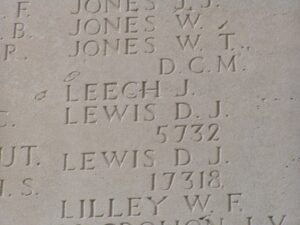
David Morgan Lewis, Greaser, 912866, Royal Navy. David was the son of David and Mary Lewis, of Isypentre, Llanrhystyd, Cardiganshire. He lived with his wife, Catherine Lewis, at 32, New Road, Llanelli prior to the war, and enlisted into the Royal Navy. David was serving aboard HMMS Blackmorevale, which was a minesweeper, when she struck a German Mine off Montrose on 1 May 1918 and sank. David was killed during the sinking. He was 30 years old, and is commemorated on the Plymouth Naval Memorial, England.
Edgar Lewis, Private, 202542, Royal Welsh Fusiliers. Edgar was the son of Eleazor and Elizabeth Lewis, of 26, Columbia Row, Llanelli. He enlisted at Wrexham into the Royal Welsh Fusiliers, and was posted to France, where he joined the 2nd Battalion, Royal Welsh Fusiliers. The battalion had been in France since the outbreak of war, and had fought in every major action thereafter. In February 1918 it became attached to 115 Brigade, 38th (Welsh) Division, and moved with the Division to the Somme in April 1918, where it took positions in the line north of Albert. Edgar was wounded here in May 1918, and died on 18 May 1918, aged 20. He is buried at Varennes Military Cemetery, France.
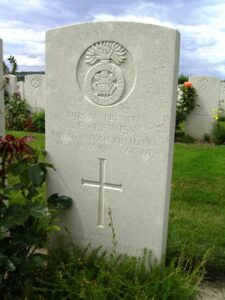
Frederick James Lewis, Private, 201636, South Wales Borderers. Frederick was born in 1894, the son of John Perkin Lewis and Mary Jane Lewis (nee Barney), of 4, Andrew Street, Llanelli. His parents were both from Pembrokeshire, but his father had come to the town to work in the tinplate works. Frederick was a regular member of the Llanelli Albions Rugby Team prior to the war. He enlisted at Brecon into the Brecknockshire Battalion, South Wales Borderers, and was posted to India to join the 1/1st Brecknocks, which were on garrison duties at Mhow, attached to the 5th (Mhow) Division. Frederick became ill and died in hospital at Mhow of influenza on 22 October 1918. The 25-year-old was buried in Mhow British Cemetery, but is also commemorated on the Kirkee 1914-1918 Memorial, India.
George Albert Lewis, Private, 1895, Welsh Guards. George was the son of John and Sarah Lewis, of 40, Station Road, Burry Port. His details with the CWGC interestingly state that he was originally rejected as “unfit”, and underwent an operation in Llanelli Hospital to render himself “fit”. George then enlisted into the 1st Battalion, Welsh Guards, attached to the 3rd Brigade, Guards Division. This Division has the distinction of being formed in France in August 1915. The various Guards units that had been with other Divisions were withdrawn to be brought together to create this fine formation. It remained on the Western Front throughout the war and saw its first major action during the Battle of Loos on 25 September 1915, remaining in the area during the coming months, where they also fought in the subsequent Action of Hohenzollern Redoubt. They then spent a brief period at Ypres, and George was soon wounded. He died of wounds on 22 March 1916, and is buried at Brandhoek Military Cemetery, Belgium.

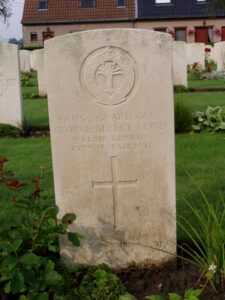
Glyn Charles Lewis, Stoker 2nd Class, SS118993, Royal Navy. Glyn was born at Llanelli on 15 July 1899, the son of William and Martha Lewis. The family later resided at Panteg House, West Street, Gorseinon. Glyn had enlisted into the Royal Navy, and was based at H.M.S. Vivid, their shore base, when he took ill. He died at East Stonehouse, Devon on 1 August 1918, aged 19, and was brought home for burial at Gorseinon (Brynteg) Congregational Chapelyard.
Ivor Lewis, Private, 2963, Royal Army Medical Corps. Ivor was born at Llanelli in 1893. He had moved to Bedwellty prior to the war and married Rose Weeks in 1910. Ivor enlisted at Pontypool into the Royal Army Medical Corps. He was posted to France with the 17th Field Ambulance, Royal Army Medical Corps, which was attached to the 6th Division. On 10 September 1914 the Division landed at St Nazaire and proceeded to the Western Front, and arrived in time to reinforce the hard-pressed BEF on the Aisne, before the whole army was moved north into Flanders. Here they took part in the Action of Hooge during June 1915. Ivor was wounded later that year, during the Actions of The Bluff, and died on 1 January 1916, aged 30. He is buried at Lijssenthoek Military Cemetery, Belgium.
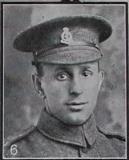
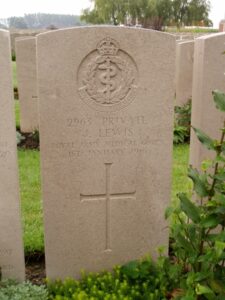
John Lewis, Rifleman, Y/1874, King’s Royal Rifle Corps. John was born at Ferndale. He probably worked at Llanelli prior to the war, as he enlisted there into the army. John was posted to France with the 7th Battalion, King’s Royal Rifle Corps, which was attached to 41 Brigade, 14th (Light) Division. The Division was to see its first action during the Action of Hooge, where the Division were the first to be attacked by the German use of flamethrowers. They then fought at the Second attack on Bellewaarde. In July 1916 they moved to the Somme, and fought at the Battle of Delville Wood, and then the Battle of Flers-Courcelette. John was killed at Flers on 15 September 1916, and is commemorated on the Thiepval Memorial, France.
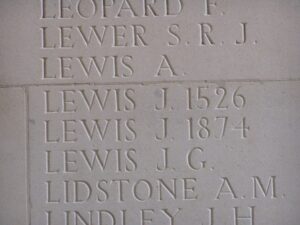
John Lewis, Private, 6892, Welsh Regiment. John was the son of Thomas and Margaret Lewis, of 9, Ralph Street, Llanelli. He was an army reservist, and had returned to Llanelli after eight years overseas with the Welsh Regiment, to live with his wife Susan at Burry Street, Seaside, Llanelli. He went to France at the outbreak of war with the 2nd Battalion, Welsh Regiment, which was attached to 3 Brigade, 1st Division. The Division had been one of the first to arrive in France, fighting at the Battle of Mons, and taking part in the retreat to the Marne, where the Germans were stopped. They then fought at the Aisne, and at Chivy, before being moved north to Ypres. Here they fought at the First Battle of Ypres, where they again stopped the German Offensive, before wintering in Flanders. John was killed during the Defence of Givenchy, on 21 December 1914, aged 39. He is commemorated on the Le Touret Memorial, Richebourg L’Avoue, France.
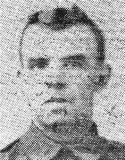
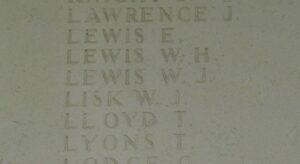
John Henry Lewis, Private, PLY/17563, Royal Marine Light Infantry. John was born on 25 April 1896, the son of Mary E. Lewis. The family later resided at 19, Rice Street, Llanelli. He enlisted into the Royal Marines on 9 November 1914, and joined the 2nd Royal Marine Battalion at Gallipoli on 5 October 1915, where it was attached to the Royal Naval Division. They were transferred from the authority of the Admiralty to the War Office on 29 April 1916, and was redesignated the 63rd (Royal Naval) Division on 19 July 1916. The Division moved to France, arriving at Marseilles between 12 and 23 May 1916 and moved to positions on the Somme, where it took part in the Battle of the Ancre, and the resulting Operations on the Ancre. John was killed in Action here on 20 February 1917, aged 20. He is commemorated on the Thiepval Memorial, France.
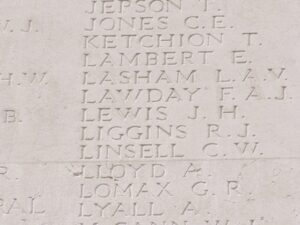
Richard Aaron Lewis, Bugler, 292, Royal Engineers. Richard was the son of John and Mary Maria Lewis, of Brynhir, 97, Sandy Road, Llanelli. He had been a Bugler with the Royal Engineers for three years prior to the war, and was called up, joining the 1/1st Welsh Field Company, which was attached to the 53rd (Welsh) Division. Richard was wounded during the Defence of Helles, at Gallipoli. He died of wounds on 30 August 1915, aged 23, and is buried at Hill 10 Cemetery, Gallipoli.
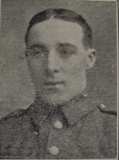
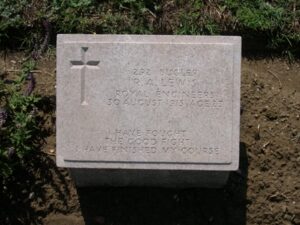
Robert John Lewis, Corporal, 30209, Gloucestershire Regiment. Robert was the son of Robert and Margaret Lewis, of 4, New Street, New Dock, Llanelli. He married Henrietta Powell in September 1914, before joining the Royal Artillery at Llanelli, with the service number 1853. Robert was later transferred to the Gloucestershire Regiment, and was posted to France on 9 November 1916, where he joined the 8th (Service) Battalion, Gloucester Regiment, which was attached to 57 Brigade, 19th (Western) Division. The Division was on the Somme, where it had seen severe fighting over the preceding months. In 1917 the Division moved North to Ypres, taking part in the Battle of Messines, and fought on the Menin Road and at Polygon Wood, before moving up to Broodseinde, Poelcappelle and Passchendaele Village itself. On 21 March 1918 they were caught up in the German Spring Offensive between Cambrai and St. Quentin, where they suffered terrible casualties during their retreat over the coming days. Robert was killed in action on 28 March 1918. He was 28 years old, and is commemorated on the Arras Memorial, France.
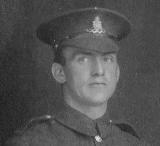
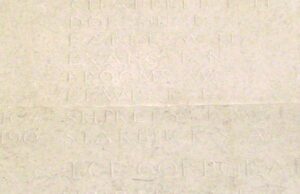
Thomas James Lewis, Private, 3045, Welsh Guards. Thomas was the son of Henry and Mary Ann Lewis, of 10, West End, Llanelli. He enlisted at Llanelli into the Welsh Guards, which had been formed on 26 February 1915. Thomas was posted to France, where he joined the 1st Battalion, Welsh Guards, which was attached to the 3rd Guards Brigade, Guards Division. The Division had its first major action at the Battle of Loos in September 1915, and in 1916 fought at the Battle of the Somme. They remained here for the winter, and in March 1917 took part in the advance caused by the German Retreat to the Hindenburg Line. Later that year they moved north to Ypres, where they fought at the Battle of the Pilkem, and then at the Battle of the Menin Road, Battle of Poelcapelle and the First Battle of Passchendaele. Thomas was killed at Passchendaele on 12 October 1917. He was 24 years old, and is commemorated on the Tyne Cot Memorial, Belgium.
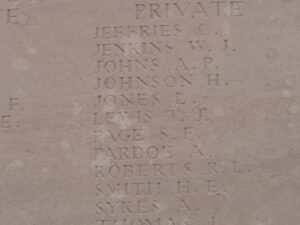
William David Lewis, Private, 117864, Labour Corps. William was born at Carmarthen, the son of William and Susannah Lewis, who later moved to 32, Devon Place, Newport, Mon. William married Mary Jane Hughes in 1913, and they lived at 87, Old Castle Road, Llanelli, where William probably worked in the Tinplate Works. He enlisted at Llanelli into the Welsh Regiment, but was probably wounded at some time, as he was transferred to the 137th Company, Labour Corps. William was wounded during the German offensives of 1918, and was brought to Hospital at Blargies, where he died on 19 May 1918. William was 39 years old, and is buried at Blargies Communal Cemetery Extension, France.
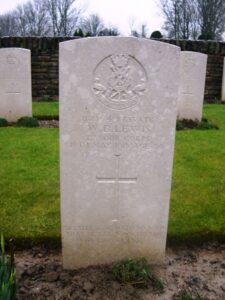
William George Lewis, Private, 14134, Royal Welsh Fusiliers. William was the son of David and Prudence Lewis, of 5, New Dock Street, Llanelli. He enlisted at Llanelli into the 11th Battalion, Royal Welsh Fusiliers, which was attached to 67 Brigade, 22nd Division. The Division crossed to France in early September 1915, but then embarked from Marseilles for Salonika, where it remained for the war. William was killed in Salonika when a piece of a trench mortar shell hit him on the head, on 15 August 1917. He was 27 years old, and is buried at Doiran Military Cemetery, Greece.
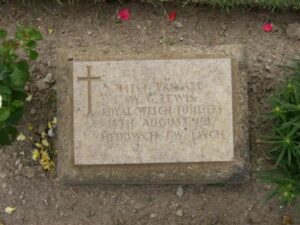
William Henry Lewis, Petty Officer 1st Class, 158928, Royal Navy. William was born at Pilton, Devon on 29 September 1875, the son of Edwin and Anne Lewis. By 1901 William had moved to Tenby, then he came to work at Llanelli before the war. He became a regular in the Royal Navy, serving aboard HMS Dublin. She was a Town Class Light Cruiser, which had been launched in April 1912. She had operated in the Mediterranean since, and at the end of September 1914 the Dublin was part of the squadron under Admiral Carden watching the Dardanelles. While the majority of British ships were soon replaced with French ships, the Dublin (along with the battle cruiser Indefatigable and three submarines) remained off the Dardanelles at the end of 1914. It is not known what happened to William, but he died of disease on 23 October 1914, aged 39. He was buried at sea, and is commemorated on the Plymouth Naval Memorial, Devon. His widow Martha was by then residing at 20a, Hamoaze Avenue, St Budesux, Devonport, Devon.
William Lance Royston Lewis, Private, 201747, Welsh Regiment. Lance was the son of Arthur and Margaret Jane Lewis, of 1, Mansel Street, Llanelli. He enlisted at Cardiff into the 1/4th Battalion, Welsh Regiment, which was the local Territorial Battalion, attached to 159 Brigade, 53rd (Welsh) Division. The Division landed at Cape Helles, Gallipoli, on 9 August 1915, and was immediately thrown into action, spending the next few days in isolated pockets, fighting against a Turkish counter-attack during the Battle of Sari Bair. The Division remained here throughout the coming months, and suffered severe losses in manpower strength during the great November 1915 blizzard on Gallipoli, when its total strength was reduced to less than that of a full-strength Brigade. On 11 December 1915 the Division was evacuated to Mudros, and by 23 December 1915 were moved to Egypt. They remained on the Suez Canal Defences for the next twelve months, where it took part in operations against the Sultan of Darfur, and in March 1917 took part in the advance into Palestine. Lance was killed during the First Battle of Gaza, on 26 March 1917, aged 20. He is commemorated on the Jerusalem Memorial, Israel.
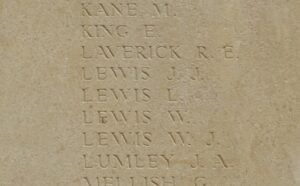
William Wddyn Lewis, Private, 45665, Welsh Regiment. William was the son of David and Anne Lewis, of 36, Hermon Rd., Caerau, Bridgend. He probably worked at Llanelli prior to the war, and enlisted there into the army. William was posted to the 23rd Battalion, Welsh Regiment, which was the Pioneer battalion to the 28th Division. During January 1915 it moved to France, landing at Le Havre and moved to the Western Front, where it saw its first major action during the Second Battle of Ypres. The Division took part in the Battle of Loos in September 1915, and in October 1915 embarked at Marseilles, and proceeded to Egypt, prior to moving to Salonika. William died in Salonika on 21 September 1916, aged 25. He is buried at Salonika (Lembet Road) Military Cemetery, Greece.
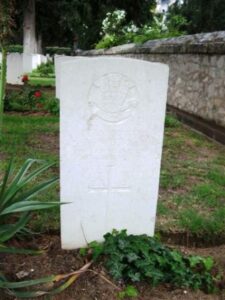
Simon Nicholas Ley, Private, 489685, Labour Corps. Simon was the son of Peter and Rosannah Ley, of 10, Upper Water Street, Llanelli. He enlisted at Llanelli into the army, and served with the South Lancashire Regiment, before being transferred to the Labour Corps. Simon never saw active service overseas, but died near Shrewsbury on 9 November 1918, aged 27. He is buried at Llanelli (Old Road) Church Cemetery.
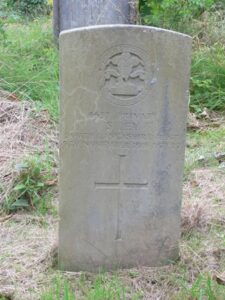
Frederick Leyshon, Private, 14066, Welsh Regiment. Frederick was one of the sons of David and Sarah Leyshon, of 4, Woodland Terrace, Bynea, Llanelli. He was educated alongside his brothers at Bynea, and joined the army at Llanelli, being posted to the 9th Battalion, Welsh Regiment. The Battalion was attached to 58 Brigade, 19th (Western) Division, and landed in France during July 1915. It saw its first action during the Battle of Loos in September, and the following year moved to the Somme, where it took part in the opening stage of the offensive, capturing the village of Ovillers-La Boiselle. It remained on the Somme, and fought at the Battle of the Ancre Heights later in the year, and it was here, on 27 October 1916, that Frederick was killed. He has no known grave, and is commemorated on Pier and Face 7A and 10A of the Thiepval Memorial, France.
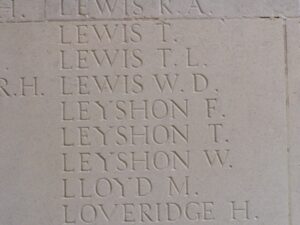
Gwilym John Leyshon, Private, 189, Welsh Guards. Gwilym was one of the sons of Thomas and Ann Leyshon, of Bynea, Llanelli. He enlisted at Llanelli into the Grenadier Guards, but when the Welsh Guards was formed after the Royal Warrant of 1915, transferred to its ranks. The 1st Battalion, Welsh Guards moved to France in the summer of 1915, joining 3rd Guards Brigade, Guards Division, and saw its first fighting at the Battle of Loos in September. In the summer of 1916 the Welsh Guards were on the Somme, and took part in the Battle of Flers-Courcelette. Their next action was during the Battle of Morval, and it was there, on 26 September 1916, that Gwilym was wounded. He was evacuated to the Base Hospital at Etaples for treatment, but died there of his wounds on 26 September 1916. Gwilym was 24 years old, and is buried at Etaples Military Cemetery, France, in Grave XI.B.4.
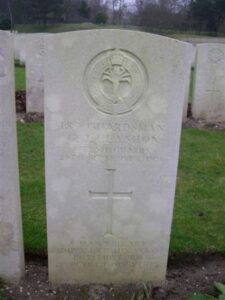
Thomas Leyshon, Private, 14349, Welsh Regiment. Thomas was the eldest of the three sons of Thomas and Ann Leyshon to die during the course of the war. He was employed at Glynea Colliery before the war, then enlisted at Llanelli into the 10th Battalion, Welsh Regiment, the 1st Rhonddas. The Battalion formed in August 1914, and trained at Rhyl before moving to Morn Hill Camp, Winchester, where it became part of 114 Brigade, 38th (Welsh) Division. The Division moved to France in December 1915, and took the line near Fleurbaix, where it was initiated into trench warfare. In June 1916 the Division moved south to the Somme, where it took part in the attack on Mametz Wood. The initial assault went in on July 1916, but it wasn’t until the early hours of 12 July that the wood fell to the Welshmen. Thomas was killed during the final hours of fighting within the wood, on 12 July 1916. He was 30 years old, and is commemorated on Pier and Face 7A and 10A of the Thiepval Memorial, France.
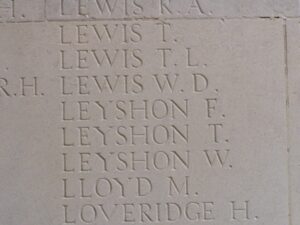
James Robert Liffen, Corporal, 73, Suffolk Regiment. James was born at Ipswich. He must have lived at Llanelli prior to the war, and enlisted back at Ipswich into the 4th Battalion, Suffolk Regiment. At the outbreak of war the battalion was attached to the Norfolk and Suffolk Brigade, East Anglian Division. On 9 November 1914 the battalion landed at Le Havre, and joined the Jullundur Brigade, 3rd (Lahore) Division. The Division took up positions around Neuve Chapelle, in Northern France, and it was there, during the Battle of Neuve Chapelle, that James was killed on 12 March 1915. He is buried at Guards Cemetery, Windy Corner, Cuinchy, France.
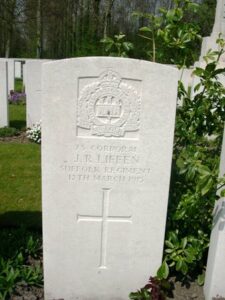
John Joseph Lissamore, Private, 4434, Welsh Regiment. John was the son of John Joseph and Jane Lissamore, of Llanelli. He married Charlotte Ann Jones in 1909, and the couple lived at 13, Amos Terrace, Llanelli, where Charlotte gave birth to their son John in 1912. John enlisted at Llanelli at the outbreak of war, and joined the 1/4th Battalion, Welsh Regiment. Sadly, John drowned while 180 men of the 4th Welsh were on swimming parade at Neyland on 30 August 1914. John was 23 years old. His body was never found, so John is commemorated on the Hollybrook Memorial, Southampton.
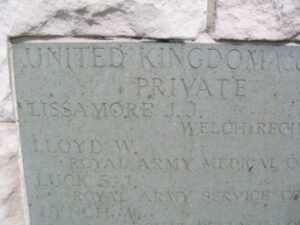
Stephen Lister, MM, Private, 13724, South Wales Borderers. Stephen was the son of Stephen and Mary Elizabeth (neé Mawhood) Lister, of Sheffield. By 1911 Stephen and his father had moved to 20, Raby Street, Llanelli, where they worked in the steel industry. Stephen enlisted in August 1914 into the South Wales Borderers. After training he was posted to the 1st Battalion South Wales Borderers and landed in France on 5 January 1915 as part of a reinforcement draft. Stephen was wounded at some point and returned to Britain to recover, before being posted to the 2nd Battalion, South Wales Borderers, which was attached to 87 Brigade, 29th Division. Stephen won the award of the Military Medal soon after, probably at Arras, during their assault on Monchy-le-Preux. He fought with the battalion during the later Battle of Passchendaele, but was wounded on 2 February 1918, and taken to 44 Casualty Clearing Station at Poperinghe, where he died on 3 February 1918. Stephen was 25 years old, and is buried at Nine Elms British Cemetery, Belgium.
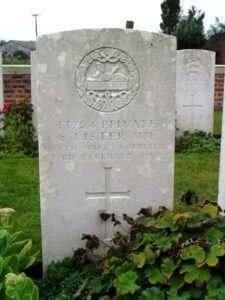
Albert Vincent Lloyd, Sapper, 20358, Royal Engineers. Albert was born on 15 September 1884, the son of Thomas Vincent Lloyd and Martha Jane Lloyd (nee Wells) of the Swansea Castle Inn, Llanelli. He had made several appearances for the Llanelli 2nds and was a renowned boxer. Albert resided at Cardiff prior to the war, and enlisted there into the Royal Engineers. He embarked for France on 20 November 1914 and upon his arrival was posted to the 5th Field Company, Royal Engineers, which was attached to the 2nd Division. The division had suffered terrible casualties during its vital actions during the defence of Ypres the previous weeks, and had just moved to new positions near Outtersteene to rebuild, then at the end of December the 1st Division took up new positions in the line at Festubert, a wet marshy area. On Christmas Day the men were in the trenches, cold and wet, when they were presented with their Princess Mary gift tins, which contained cards and gifts on behalf of the Royal Family. The line was relatively quiet over this period, but the trenches were flooded and in a terrible state. Nonetheless, the division remained in the line here over the coming months, concentrating on the never-ending work of repairing and consolidating trenches. The 1st Division took part in a desperate defensive action here on 25 January 1915 the Germans hit their lines with an intensive artillery bombardment, before launching an infantry assault, breaking through 100 yards of trench and reaching Givenchy village. Heavy fighting raged throughout the day as the Germans were driven back and the line regained. The division then took part in the abortive Battle of Aubers Ridge, before moving into the Loos Sector. On 1 September 1915 Albert was disposing of dozens of captured German hand grenades by throwing them into a canal, when one exploded in his hand, taking off his hand and badly injuring him. He was evacuated to the 1st Casualty Clearing Station but died soon afterwards that same day. The 32-year-old is buried in Chocques Military Cemetery, France.
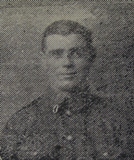
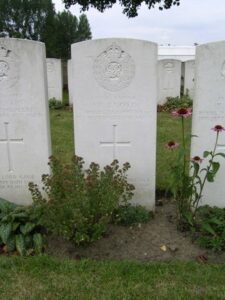
Cyril Harcourt Lloyd, Gunner, 201967, Royal Field Artillery. Cyril was born at Llanelli in 1889, the son of George and Ellen Lloyd. The family later moved to 39, Duffryn St., Mountain Ash, Glam. Cyril enlisted at Mountain Ash into the Royal Garrison Artillery, but was posted to France with 466th Battery, 66th Brigade, Royal Field Artillery. Cyril was wounded at Ypres during the time of the Battle of Messines, and died on 8 June 1917, aged 28. He is buried at Dickebusch New Military Cemetery Extension, Belgium.
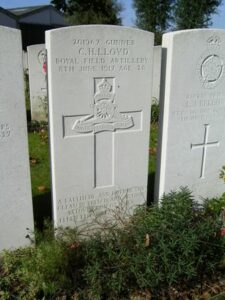
David Lloyd, Private, 7231, Welsh Regiment. David was born at Carmarthen, but had moved to Llanelli by 1901. He married Elizabeth Williams in 1906 and the couple lived at 6, Sandy Gate, Llanelli, where their four children were born. David appears to have been a member of the Salvation Army and worked as a labourer in a steelworks. He was an army reservist, and went to France with the 2nd Battalion, Welsh Regiment at the outbreak of war, which was attached to 3 Brigade, 1st Division. The Division moved to Mons, and took part in the retreat from Mons to the Marne, before pushing the Germans back to the Aisne. The BEF then moved to defend Ypres from a German drive towards the Channel. The 1st Division took up positions across the Menin Road, near Gheluvelt, to stop the German drive towards Ypres. David was killed here during on 27 October 1914, aged 31. He is commemorated on the Ypres (Menin Gate) Memorial, Belgium.
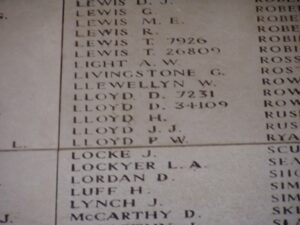
David Lloyd, Private, 34109, Welsh Regiment. David was born at Llanelli, and enlisted at Swansea into the army. He was posted to France where he joined the 9th Battalion, Welsh Regiment, which was attached to 58 Brigade, 19th (Western) Division. David would have fought with the Division during their successful assault on La Boiselle on the Somme in July 1916. It then fought through the Somme Battles of Pozières and the Ancre in 1916. In 1917 the Division moved north to Ypres, taking part in the Battle of Messines. David was killed here on 19 July 1917. He is commemorated on the Ypres (Menin Gate) Memorial, Belgium.
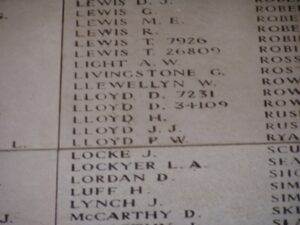
Gwilym Lloyd, Able Seaman, R/3425, Royal Naval Reserve. Gwilym was born on 11 April 1887, the son of James and Elizabeth Lloyd, of 13, Lakefield Road, Llanelli. He enlisted into the Pembroke Yeomanry on 17 August 1916, and transferred to the Royal Naval Volunteer Reserve, for service with the Royal Naval Division on 11 July 1917, joining Nelson Battalion in France. The battalion was at Ypres, attached to 189 Brigade, 63rd (Royal Naval) Division, preparing for their part in the assault on Passchendaele village. Gwilym was wounded here, and died on 27 October 1917, aged 30. He was buried in an isolated grave on the battlefield, but this was lost during the coming months, so today Gwilym is commemorated on the Tyne Cot Memorial, Belgium.
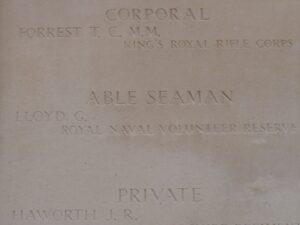
Gwilym Henry Lloyd, Private, 32887, Notts & Derby (Sherwood Foresters). Gwilym was born at Llanelli, but resided at Taffs Well prior to the war. He enlisted at Derby into the army, and was posted to the 11th Battalion, Sherwood Foresters, which was attached to 70 Brigade, 23rd Division. Between 21 and 26 August, 1915 the Division landed in Boulogne and proceeded to the Western Front, initially concentrating near Tilques. They saw their first major action at the Battle of Albert, where they captured Contalmaison. Gwilym was killed during the first day of the Battle of the Somme, on 1 July 1916. He is buried at Serre Road Cemetery No. 2, France.
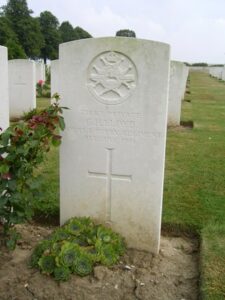
R. Lloyd, Private, Welsh Regiment. This man cannot presently be identified.
Thomas Lloyd, Private, 63126, Welsh Regiment. Thomas was born in 1898, the son of Thomas Lloyd and Rachel Lloyd, of 58, High Street, Abergwili. He worked as a farm labourer as a young man, then left Abergwili to work as a tinplater at Llanelli. Thomas enlisted at Llanelli into the 4th (Reserve) Battalion, Welsh Regiment on 23 October 1914, and was posted to the 1/4th Battalion, Welsh Regiment. The battalion was the local Territorial unit and mobilised for war at Carmarthen in August 1914, as part of South Wales Brigade, Welsh Division and moved to Tunbridge Wells until the end of the month, before moving to Scotland to man the Forth and Tay Defences. The remainder of the Welsh Division then moved to Bedford, where it became numbered as the 53rd (Welsh) Division, and on 17 April 1915 the 4th Welsh moved to Bedford, joining 158 Brigade, of the 53rd (Welsh) Division. On 19 July 1915 the entire Division sailed from Devonport for Imbros and on 9 August 1915 landed at C Beach, south of Lala Baba, in Suvla Bay. The infantry moved off the beaches across the Salt Lake, under shellfire, into the scrub covered Chocolate Hill, but due to a lack of maps and no knowledge of the terrain, many of the units became disorientated, and the situation became chaotic. Thomas survived this terrible period, but became ill and was admitted to the 87th Field Ambulance on 13 September and was evacuated to Mudros before returning back to England aboard the Hospital Ship Aquitania. It was over a year before he had recovered enough to go back to the front, and in February 1917 he left England for Salonika, to join the 11th Battalion, Welsh Regiment, which was attached to 67 Brigade, 22nd Division. Thomas then suffered several spells of ill health in Salonika over the coming months, but was fit for action again by the summer of 1918. He was then wounded in action during the Battle of Doiran and died of his wounds on 21 September 1918. The 21-year-old was buried in Sarigol Military Cemetery, Kriston.
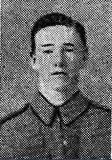
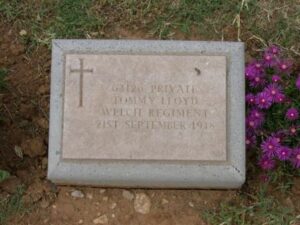
William Ivor Lloyd, Private, 7607, South African Infantry. William was born in 1880, the son of Richard Morgan Lloyd and Caroline Sophia Lloyd (nee Hall), of 20, Woodfield Street, Llanelli. He had played rugby at Full Back for the Scarlets prior to emigrating to South Africa in 1901, following the end of the Boer War. William enlisted in Transvaal into the 3rd Regiment, South African Infantry. After its formation, the 3rd Regiment embarked at Cape Town and sailed for Britain, then assembled at Bordon Camp in Hampshire. Here the South Africans began three months of training in preparation for embarking for France however, their orders were changed and on 30 December 1915 they boarded ships in Devonport and sailed for Egypt to join the campaign against the Senussi tribesmen. William came home to Llanelli on leave in January 1916, his first time there in fifteen years, and caught up with a good friend, another ex-Scarlet, Ben Davies. The 3rd Regiment was then transferred to France as part of the 1st South African Brigade to join the 9th (Scottish) Division, joining the division on the Somme. The division took part in the fighting to clear the village of Longueval, before launching an assault on the adjacent Delville Wood on 15 July 1916. William was wounded during the terrible fighting in Delville Wood, and was evacuated to the casualty clearing station at Corbie, where he died of his wounds on 18 July 1916. The 36-year-old is buried in La Neuville British Cemetery, Corbie, France.
Edward Sharland Lockstone, Private, 11134, Wiltshire Regiment. Edward was the son of Edward Henry and Elizabeth Lockstone, of The Firs, Milbourne, Malmesbury, Wilts. He worked as a Bank Clerk at Lloyds Bank, Llanelli prior to the war. He enlisted back at Malmesbury into the 2nd Battalion, Wiltshire Regiment, which was attached to 21 Brigade, 7th Division. The battalion landed at Zeebrugge on 7 October 1914, before the complete Division moved to Ypres, where they became the first British Division to hold the city. They fought during the First Battle of Ypres, and helped stop the German advance through Belgium, and in March, 1915 fought at the Battle of Neuve Chapelle. Edward was killed here on 12 March 1915. He was 25 years old, and is commemorated on the Le Touret Memorial, Richebourg L’Avoue, France.
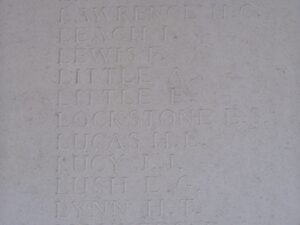
William Lodwick, Driver, T4/123188, Royal Army Service Corps. William was the son of Timothy and Margaret Lodwick, of Brynmeurig, Parcmaen Street, Carmarthen. Timothy later moved to 63, Princess Street, Llanelli. William had enlisted at New Tredegar in July 1915 into the Royal Army Service Corps, and moved to France shortly after. He became ill with fever, and was invalided home from France in September 1915, and was sent to King’s Heath Hospital at Birmingham. William died there on 31 December 1916, after a long illness. He was 28 years old, and was brought home to be buried at Carmarthen (Union Street) Congregational Chapelyard.
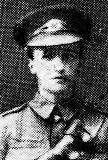
William Stephen Lovelock, Rifleman, 6445, King’s Royal Rifle Corps. William was the son of William and Elizabeth Lovelock, of Islington, London. He resided at Llanelli prior to the war, but enlisted at Holloway, London into the 13th Battalion, King’s Royal Rifle Corps, which was attached to 111 Brigade, 37th Division. Late in July 1915 the Division landed in France. They took part in the Attack on the Gommecourt Salient, during the first phase of the Battle of the Somme, on 1 July 1916, and then fought at the later Battle of the Ancre. They moved north in March 1917, and took part in the First Battle of the Scarpe, where they captured Monchy le Preux. William was killed at the Second Battle of the Scarpe, on 23 April 1917. He was 21 years old, and is commemorated on the Arras Memorial, France. His father also fell (Rifleman William Lovelock, R/7885, 1st King’s Royal Rifle Corps, killed on Saturday 15 May 1915).
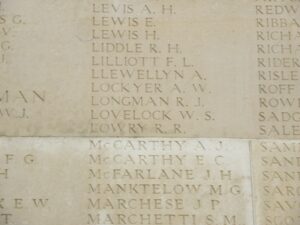
Joseph Lovett, Private, 11294, Welsh Regiment. Joseph was the son of Joseph and Mary Lovett, of 20, Island Place, Llanelli. He enlisted there into the 8th Battalion, Welsh Regiment. The battalion formed at Cardiff in August 1914, attached to 40 Brigade, 13th (Western) Division, then converted to a Pioneer battalion before embarking at Avonmouth on 15 June 1915, and landed at ANZAC cove on 5 August 1915. Joseph was killed during the Battle of Sari Bair, on 8 August 1915, aged 26. He is commemorated on the Helles Memorial, Gallipoli.
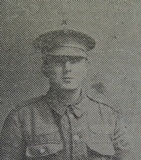
William John Lowe, Driver, M2/0/8835, Royal Army Service Corps. William was born at Lampeter in 1887, the son of William and Sarah Lowe, later of 16, Lady Street, Kidwelly. William served with the MT Section of the Army Service Corps as a Driver, While on active service in France, William developed an abscess on his left hip after a fall, and was hospitalised. He returned to service after recovering, but was admitted to hospital suffering from shell shock in August 1916, spending almost two months in hospital. Again William recovered, and was posted back out to France. On 4 May 1917 he was admitted to hospital again, after having suffered from gunshot wounds to his face and hands, which he had received during the Battle of Arras on 28 April. He spent a further 41 days in hospital recovering. William was then pensioned off, but died at home as a result of his wounds on 31 March 1919, aged 32. He is buried at Kidwelly (St. Mary) Churchyard.
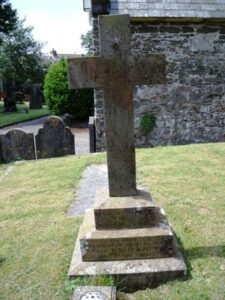
Thomas George Octavius Lucas, Sergeant, 471062, Labour Corps. Thomas was born at Briton Ferry in 1868, the son of Griffith and Elizabeth Lucas. He married Mary Rattenbury at Llanelli in June 1898 and the couple set up home at 11, Biddulph Street. Thomas originally enlisted into the 11th Battalion, Royal Welsh Fusiliers and served in France and Salonika before being transferred to the Labour Corps, probably due to ill-health. He then served with the Labour Corps before being demobilised following the Armistice. Thomas returned to Llanelli, but his health never recovered and he died in 1920, aged 49. Little else is currently known of him, as he is not commemorated by the CWGC.
Christopher John Luckett, Private, 33939, Welsh Regiment. Christopher was the son of James and Amelia Luckett, of The Row, Shirenewton, Chepstow. He probably worked at Llanelli prior to the war, and enlisted there into the army. Christopher was posted to France, where he joined the 2nd Battalion, Welsh Regiment, which was attached to 3 Brigade, 1st Division. Christopher probably joined the battalion just prior to the Somme Offensive in July 1916. He was wounded during the Battle of Morval, and died on 9 October 1916, aged 25. Christopher is buried at St. Sever Cemetery, Rouen, France.
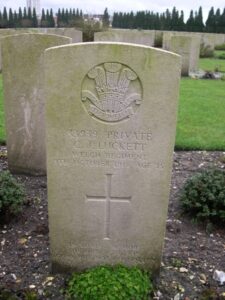
Thomas George Mack, Acting Sergeant, 3242, Welsh Regiment. Thomas was the son of Thomas and Mary Jane Mack, of 45, Stepney Place, Llanelli. He enlisted at Llanelli into the 1/4th Battalion, Welsh Regiment, which was the local Territorial Battalion, attached to 159 Brigade, 53rd (Welsh) Division. The Division landed at Cape Helles, Gallipoli, on 9 August 1915, and was immediately thrown into action, spending the next few days in isolated pockets, fighting against a Turkish counter-attack during the Battle of Sari Bair. Thomas was killed here on 11 August 1915. He was 35 years old, and is commemorated on the Helles Memorial, Gallipoli.
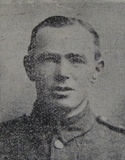
Michael John Mahoney, Private, 194303, Labour Corps. Michael was the husband of Ellen Ann Mahoney, of 6, Upper Park Row, Llanelli. He enlisted on 2 May 1917 into the 1st Labour Battalion, Labour Corps. Michael doesn’t look to have served overseas. He was discharged as medically unfit on 12 April 1919, with his papers showing a twenty percent disability due to his service, and that he was given a pension. Michael must have died in the summer of 1921 after being discharged from the army, but nothing more about him can be traced at present.
Edward Mangham, Private, 8660, Northamptonshire Regiment. Edward was born at New Found Pool, Leicestershire, in 1889, the son of Robert and Harriet Mangham. He was an army reservist, and lived with his wife Elizabeth at 25, Old Castle Road, Llanelli. Edward worked at the Burry Works prior to the war, and was recalled to the colours, joining the 2nd Battalion, Northamptonshire Regiment at the outbreak of war. On 5 November 1914 the battalion landed at Le Havre attached to 24 Brigade, 8th Division. They saw their first major action at the Battle of Neuve Chapelle, and then at the Battle of Aubers. Edward was wounded during the summer of 1915, and died on 28 August 1915. He is buried at Lillers Communal Cemetery, France.
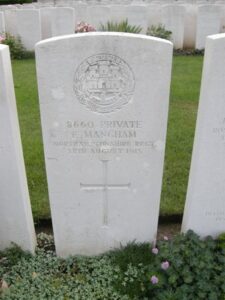
George Stanley Mann, Private, 2097, Australian Imperial Force. George was the son of Thomas William and Amy Louisa Mann, of Little Denison St., Carrington, New South Wales. He enlisted into the 30th Battalion, Australian Imperial Force on 18 April 1915, and was posted to Egypt on 16 February 1916 with the 3rd Reinforcements to the battalion, before they embarked for France, landing at Marseilles on 23 June 1916, attached to the 8th Australian Brigade, 5th Australian Division. George was wounded during his first major action, at Fromelles on 20 July 1916, and was evacuated to England for treatment. He rejoined his battalion in France on 19 December 1917. Unlike many AIF battalions, the 30th had a relatively quiet time during the German Spring Offensive of 1918 as the 5th Division was in reserve for much of the time. When the Allies took to the offensive again, the 30th fought in a minor attack at Morlancourt on 29 July, after having conducted several large raids in the area in June. The 30th was heavily engaged when it lead the 5th Division’s advance down the Morcourt Valley, during the battle of Amiens on 8 and 9 August. George received a gunshot wound to his head here on 8 August 1918, and was evacuated via the 61st Casualty Clearing Station by hospital ship to London. George died of his wounds at Mile End Hospital, London on 28 October 1918, aged 26, and was buried with full military honours at Box Cemetery, Llanelli on 5 November 1918, at the request of his Uncle and Aunt, Mr. and Mrs. John Mann, who attended the funeral. Over a thousand people attended the funeral. His cousin Richard Mann also fell.
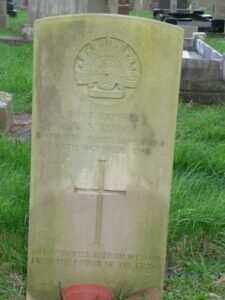
Richard Mann, Private, 29694, East Lancashire Regiment. Richard was the son of Richard and Mary Mann, of 31, Woodland Rd., Gorton, Manchester. He probably worked at Llanelli prior to the war, and enlisted there into the army. Richard served with the North Lancs before being transferred to the 2nd Battalion, East Lancashire Regiment, which was attached to 24 Brigade, 8th Division. The Division moved to the Western Front in November 1914, a badly-needed reinforcement to the BEF which had been all but wiped out at Ypres. They saw their first major action at the Battle of Neuve Chapelle, and then at the Battle of Aubers. They then saw further fighting at the Action of Bois Grenier, before moving to the Somme in 1916, where they fought at the Battle of Albert. In March 1917 they followed the German Retreat to the Hindenburg Line, and it was during this period that Richard was killed, on 12 April 1917. He was 32 years old, and is commemorated on the Thiepval Memorial, France. His cousin, George Stanley Mann, also fell.
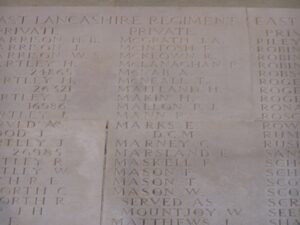
Reginald Maple, Private, R/18558, King’s Royal Rifle Corps. Reginald was born at Salisbury in 1894, the son of Elizabeth Maple. He worked at Llanelli prior to the war, and married Ada Mager at Llanelli in 1914, before enlisting at Banbury into the army. Reginald was posted to France, where he joined the 9th Battalion. King’s Royal Rifle Corps, which was attached to 42 Brigade, 14th (Light) Division. The Division was to see its first action during the Action of Hooge, where the Division were the first to be attacked by the German use of flamethrowers. They then fought at the Second attack on Bellewaarde. In July 1916 they moved to the Somme, and fought at the Battle of Delville Wood, and then the Battle of Flers-Courcelette, and in March, 1917 followed the German Retreat to the Hindenburg Line. May saw them at Arras, where they took part in the First Battle of the Scarpe, and later at the Third Battle of the Scarpe, and then they were sent to Ypres, where they fought at the Battle of Langemarck. Reginald was killed at Langemarck on 21 August 1917, aged 23. He is buried at Birr Cross Roads Cemetery, Belgium. His brother, Cecil Maple, also fell.
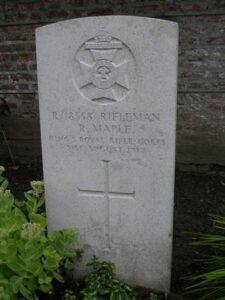
Charles Marner, Private, 13087, Royal Welsh Fusiliers. Charles was born at Greenwich, but resided at Pencoed Farm, Llangennech prior to the war. He enlisted there into the 9th Battalion, Royal Welsh Fusiliers, which was attached to 58 Brigade, 19th (Western) Division. The Division moved to France during July 1915, and moved to positions near Loos, where it took part in the opening attack of the Battle of Loos on 25 September 1915. Charles was killed during the opening assault near Givenchy that day. He was 21 years old, and is commemorated on the Loos Memorial, France.
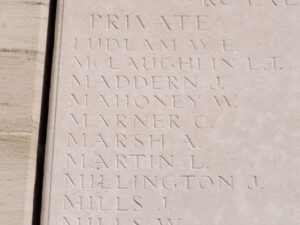
Gilbert Marshall, MM, Bombardier, 112644, Royal Field Artillery. Gilbert was born at Victoria, Australia. He resided at Llanelli prior to the war, and enlisted there into the Royal Artillery. Gilbert was posted to France with D Battery, 77th Army Brigade, Royal Field Artillery. Gilbert was taken ill, and died during the time of the advance on the Hindenburg Line, on 2 September 1918. He is buried at Vis-En-Artois British Cemetery, Haucourt, France. Gilbert had won the Military Medal during his time at war.
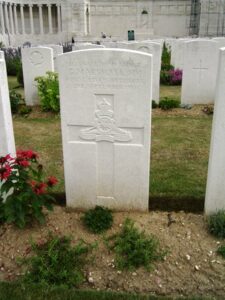
David Henry Martin, Private, 5088, Welsh Regiment. David was the son of William and Mary Ellen Martin, of 14, Ashburton, Cork. He worked at Llanelli prior to the war, and married Fanny Walters in 1910. The couple then lived at 3, New Dock Road, Llanelli, where their son David Victor Martin was born. David enlisted at Llanelli into the 1/4th Battalion, Welsh Regiment, which was the local Territorial Battalion, attached to 159 Brigade, 53rd (Welsh) Division. The Division landed at Cape Helles, Gallipoli, on 9 August 1915, and was immediately thrown into action, spending the next few days in isolated pockets, fighting against a Turkish counter-attack during the Battle of Sari Bair. David was wounded later in the campaign at Gallipoli, and died on 31 October 1915. He was 36 years old, and is buried at Lala Baba War Cemetery, Gallipoli.
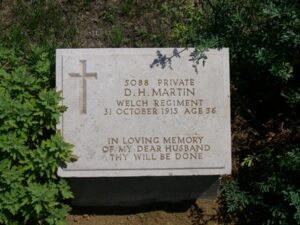
Albert Wilfred Mason, Private, 14131, South Wales Borderers. Albert was born on 30 September 1884, the son of James Edwin Mason, and Ann Mason, of 14, Cambrian Place, Llanelli. He married Elizabeth Ann Taylor at Llanelli on 1 September 1907 and the couple set up home at 34, Stepney Place, Llanelli. Albert worked as a galvaniser and was a well known sportsman prior to the war, having played at Full Back for Llanelli RFC before playing professionally for Salford. Albert enlisted at Llanelli into the South Wales Borderers in September 1914, and was posted to the 4th Battalion, South Wales Borderers, which was attached to 40 Brigade, 13th (Western) Division. Albert was discharged from the army as medically unfit on 28 May 1915, after being diagnosed with phthisis, and suffering from chest pains. His medical records show that the 4th SWB had been billeted in terrible conditions, and that this had brought about Albert’s illness. Albert returned to Llanelli where he died on 22 December 1916, aged 32. Albert’s case was put forward by myself to the CWGC on 4 August 2013, but was rejected on 22 July 2014 as it is thought that the medical cases do not tie up. An appeal was then put in by, but after further deliberation he was again rejected. His brother David James Mason also fell, killed in Egypt in 1917.
David James Mason, Private, 201348, Welsh Regiment. David was the son of James Edwin Mason and Ann Mason, of 16, Cambrian Place, Llanelli. He enlisted there into the 1/4th Battalion (Carmarthen), Welsh Regiment, part of 159 Brigade, 53rd (Welsh) Division. The Division landed at Gallipoli on 9 August 1915 and suffered terrible casualties over the coming months there. On 11 December 1915 the Division was evacuated to Mudros, and by 23 December 1915 were moved to Egypt. They remained on the Suez Canal Defences for the next twelve months, and in early 1917 moved into Palestine, where they remained for the duration of the war, fighting at the Battles of Gaza, and successfully capturing Jerusalem. David was killed during the capture of Jerusalem, on 3 November 1917, aged 24. He is buried at Beersheba War Cemetery, Israel. His brother Albert Mason also died.
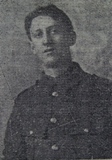
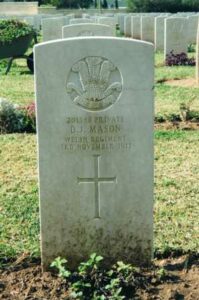
Henry George Mathias, Private, 12397, South Wales Borderers. Henry was the son of Thomas and Martha Jane Mathias, of 36, Catherine, Seaside, Llanelli. He was one of the first Llanelli men to enlist in August 1914, and joined the 4th Battalion, South Wales Borderers, which was attached to 40 Brigade, 13th (Western) Division. On 13 June 1915 the Division sailed for Alexandria, and landed at Cape Helles, Gallipoli from 6 July 1915, relieving the 29th Division. They left and returned to Mudros at the end of the month, and the entire Division landed at ANZAC Cove between 3 and 5 August, 1915, taking part in the Battle of Sari Bair. Henry was killed here on 11 August 1915. He was 21 years old, and is buried at Azmak Cemetery, Suvla, Gallipoli.
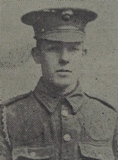
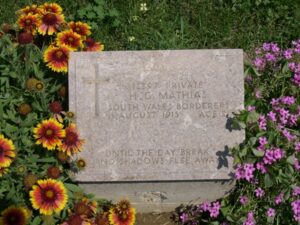
William Henry Mathias, Private, Welsh Regiment. This man cannot presently be identified, although a photograph of him was printed in a local newspaper, with no more details, other than his name.
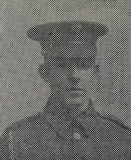
J. May, Seaman, Royal Navy. This man cannot presently be identified.
Richard May, Private, 1752, Welsh Guards. Richard was the son of William and Mary Eleanor May, of Llanelli, and resided at 23, Square, Newcastle Hill, Bridgend prior to the war. He enlisted into the 7th Welsh in 1910, which was a Territorial Battalion. At the outbreak of war he was mobilised and joined the 3rd Welsh. Early in 1915 he volunteered to join the Welsh Guards, which had been formed on 26 February 1915, and he was sent to France with the 1st Battalion, Welsh Guards in July 1915, joining the 3rd Guards Brigade, Guards Division. The Division saw its first major action during the Battle of Loos on 25 September 1915, remaining in the area during the coming months, where they also fought in the subsequent Action of Hohenzollern Redoubt. In July 1916 the Division moved to the Somme, where they fought at the Battle of Flers-Courcelette, and then at the Battle of Morval, capturing Lesboeufs Village. Richard was killed on the Ancre on 17 November 1916, aged 23. He is commemorated on the Thiepval Memorial, France.
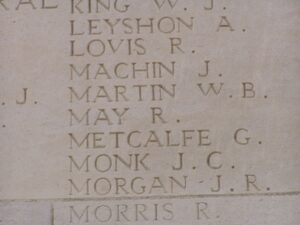
Sydney Boaz May, Private, 200996, Welsh Regiment. Sydney was born at Weymouth, the son of Joseph and Lillie May. The family had moved to the GWR Dock at Llanelli prior to 1911, where Joseph became the Harbour Master. Sydney enlisted there into the 1/4th Battalion, Welsh Regiment, which was the local Territorial Battalion, attached to 159 Brigade, 53rd (Welsh) Division. The Division landed at Cape Helles, Gallipoli, on 9 August 1915, and was immediately thrown into action, spending the next few days in isolated pockets, fighting against a Turkish counter-attack during the Battle of Sari Bair. The Division remained here throughout the coming months, and suffered severe losses in manpower strength during the great November 1915 blizzard on Gallipoli, when its total strength was reduced to less than that of a full-strength Brigade. On 11 December 1915 the Division was evacuated to Mudros, and by 23 December 1915 were moved to Egypt. They remained on the Suez Canal Defences for the next twelve months, where it took part in operations against the Sultan of Darfur, and in March 1917 took part in the advance into Palestine. Sydney was wounded during the First Battle of Gaza, and died on 27 March 1917, aged 21. He is buried at Deir El Belah War Cemetery, Egypt.
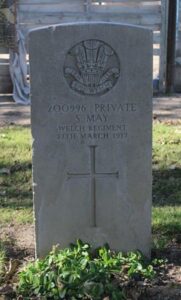
David McAlister, Private, 381398, King’s Liverpool Regiment. David was born at Cambourne, the son of John and Jane McAlister. The family had moved to Mill Bay House, Corporation Avenue, Llanerch, Llanelli prior to the war. David enlisted at Cardiff into the army, and was posted to France, where he joined the 13th Battalion, King’s Liverpool Regiment, which was attached to 8 Brigade, 3rd Division. David probably went to France late in 1917, and was killed during the Battle of the Lys, on 12 April 1918. He was 19 years old, and is commemorated on the Ploegsteert Memorial, Belgium.
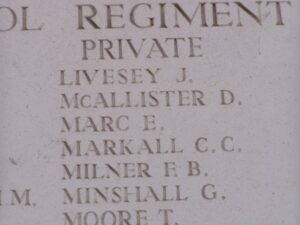
John McCarthy, Private, 33739, Welsh Regiment. John was the son of James McCarthy, of Cork. He worked at Llanelli prior to the war, and enlisted there into the Welsh Regiment. John was serving at Kinmel Park with the 12th Battalion, Welsh Regiment, when he took ill, and was hospitalised at Bangor. He died there on 28 December 1915, aged 34, and is buried at Bangor (Glanadda) Cemetery.
Joseph McCluskey, Private, 1959, Irish Guards. Joseph was born at Grenamore, Co. Armagh. He had worked at Llanelli prior to the war, and was an army reservist. Joseph rejoined the colours at Stirling, and was sent to France with the 1st Battalion, Irish Guards, which was attached to the 4th Guards Brigade, 2nd Division. One of the first Divisions to move to France, the 2nd Division remained on the Western Front throughout the war. They moved to Belgium, where they fought at the Battle of Mons, and retreating southwards, fought at the Affair of Landrecies, the Rearguard Actions of Villers-Cotterets, and at the Battle of the Marne where the German offensive was stopped. The Germans retreated north, and the BEF met them, fighting at the Battle of the Aisne. The 2nd Division were then moved to Flanders, where they fought at the First Battle of Ypres, when the German sweep through Flanders was stopped. Joseph was killed during the First Battle of Ypres, on 6 November 1914. He is commemorated on the Ypres (Menin Gate) Memorial, Belgium.
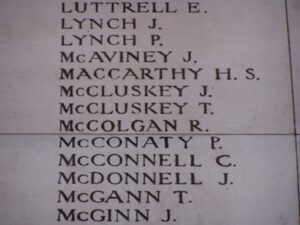
Peter McKelvie, Driver, W/5033, Royal Field Artillery. Peter was born at Tenby on 26 May 1881, the son of John and Catherine McKelvie. He worked as a Stableman and Llanelli prior to the war, and resided at Lyndhurst, Tunnel Road, Llanelli. Peter enlisted at Llanelli on 26 May 1915 into the Welsh Divisional Royal Field Artillery, and entrained for their camp at Pwllheli. He was discharged from the army on 17 September 1915, having contracted pulmonary tuberculosis while in camp at Pwllheli. Peter re-enlisted into the Royal Defence Corps, but was badly injured in an accident and discharged again on 1 March 1917, and returned to Llanelli to live with his brother John McKelvie. Peter died at Llanelli on 12 March 1918, aged 36. Nothing more is presently known of him, as he is not commemorated by the CWGC, and further research is presently underway.
John McVicar, Corporal, 1436, Royal Fusiliers. John was the son of John and Margaret McVicar, of Low Craighall Road, Port Dundas, Glasgow. He resided with his brother Gavin at 3, Mina Street, Llanelli prior to the war, and enlisted there into the army. John was posted to the 7th Battalion, Royal Fusiliers, which was attached to 190 Brigade, 63rd (Royal Naval) Division. The Division moved to France, arriving at Marseilles between 12 and 23 May 1916 and moved to positions on the Somme, where it took part in the Battle of the Ancre, and the resulting Operations on the Ancre. In April 1917 the Division were at Arras, and fought at the Second Battle of the Scarpe, where they captured Gavrelle. They then fought at the Battle of Arleux, before moving north to Ypres, where they took part in the Second Battle of Passchendaele. Their next major action was at Cambrai, during the Action of Welch Ridge, and they were still in the area when the Germans launched their Spring Offensive, and fought at the Battle of St Quentin, and then the First Battle of Bapaume. John was wounded at Arras, and died on 27 May 1918. He was 35 years old, and is buried at Doullens Communal Cemetery Extension No. 2, France.
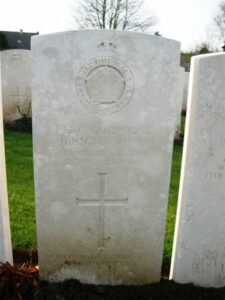
Donald Joseph McWilliams, Private, 11840, Irish Guards. Donald was the son of Michael and Mary Anastasia McWilliams, of 12, Park Bean, St. Ives, Cornwall. He worked at Llanelli prior to the war, and enlisted there into the army. Donald was posted to the 1st Battalion, Irish Guards, which was attached to the 1st Guards Brigade, Guards Division. He would have fought with the Division at Loos in September 1915, and on the Somme in 1916. He would also have taken part in the Battle of Passchendaele, and the Battle of Cambrai in 1917. They remained in the area over the final winter of the war, and were stationed near Gouzeaucourt when the German Spring Offensive hit the area on 21 March 1918, at the Battle of St Quentin. The British retreated in the face of this onslaught, and slowly retreated over the coming days. Donald was wounded during this tempestuous period, and died on 28 March 1918, aged 19. He is buried at Bac-Du-Sud British Cemetery, Bailleulval, France.
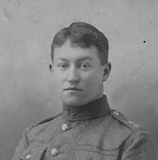
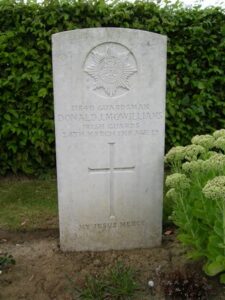
Edward Meese, Private, 15770, Welsh Regiment. Edward was the son of Thomas and Sarah Meese, of 9, John’s Road, Stourport, Worcestershire. He probably worked at Llanelli prior to the war, and enlisted there into the 8th Battalion, Welsh Regiment, which was the Pioneer battalion to the 13th (Western) Division. On 13 June 1915 the Division sailed for Alexandria, and moved to Mudros before being landed at Cape Helles, Gallipoli from 6 July 1915, relieving the 29th Division. On 8 January 1916, the Division was evacuated from Helles, and by 31 January was concentrated at Port Said, where they held forward posts in the Suez Canal defences. On 12 February 1916 the Division began to move to Mesopotamia, to strengthen the force being assembled for the relief of the besieged garrison at Kut al Amara. Edward took ill and died in Mesopotamia on 6 July 1916, aged 24. He is buried at Amara War Cemetery, Iraq.
Levi Meyler, Private, 20144, Welsh Regiment. Levi was the son of William and Elizabeth Meyler, of 56, Ropewalk Road, Llanelli. He enlisted there in February 1915 into the 15th Battalion, Welsh Regiment, which was known as the Carmarthen Pals battalion, attached to 114 Brigade, 38th (Welsh) Division. On 2 December 1915 the battalion moved to France, and the entire Division moved to the Fleurbaix sector, where it was initiated into trench warfare. During June 1916 the Division marched south to the Somme, and on 7 July 1916 attacked Mametz Wood. The initial attack failed, and it was three days later, on 10 July, that a fresh attack was mounted. After two days of heavy hand to hand fighting within the wood, the Germans withdrew, and the battered Welshmen moved via Hebuterne to Boesinghe, on the Yser Canal, where it remained until launching its attack on Pilckem Ridge on 31 July 1917. The 15th Welsh remained in the line, and also took part in the Battle of Langemarck, before the entire Division was moved to positions near Armentieres over the winter. After the Germans launched their offensive on the Somme on 21 March 1918, the Division was moved back to the Somme, and took up positions north of Albert, around Aveluy Wood. Levi was wounded at Aveluy Wood, and died on 27 May 1918, aged 30. He is buried at Beaulencourt British Cemetery, Ligny-Thilloy, France.
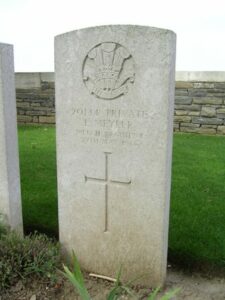
Percy Brabyn Miller, Sapper, 67344, Royal Engineers. Percy was the son of William George and Sarah Jane Miller, of 33, Ralph Terrace, Llanelli. He enlisted at Llanelli into the Welsh Divisional Engineers, and had served in the Mediterranean. After being invalided home sick he was posted to the 151st Field Company, Royal Engineers, which was in France attached to the 38th (Welsh) Division. Percy was wounded during the Battle of the Selle, possibly when the 151st FC were bridging the River Selle. He died on 28 October 1918, aged 25, and is buried at Etaples Military Cemetery, France.
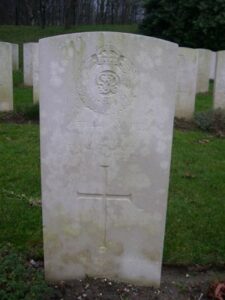
William Raymond Miller, Private, 7/45059, South Wales Borderers. William was the son of Thomas and Anne Miller, of 14, Coldstream Street, Llanelli. He enlisted at Carmarthen into the 7th Battalion, South Wales Borderers, which was attached to 67 Brigade, 22nd Division. The Division crossed to France in early September 1915, but on 27 October 1915 embarked from Marseilles for Salonika. William was killed at Salonika, during the Battle of Doiran, on 18 September 1918. He was 20 years old, and is buried at Doiran Military Cemetery, Greece.

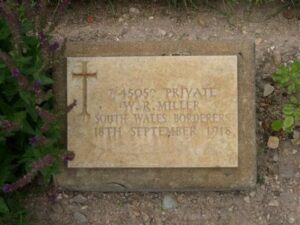
Archibald Reginald Mogford, Private, 51368, Lancashire Fusiliers. Archibald was born at Llanelli in 1898, the son of William and Mary Ann Mogford. The family had moved to 17, Florence Street, Neath by 1901, and Archibald enlisted at Neath into the army. He was posted to France, where he joined the 17th Battalion, Lancashire Fusiliers, which was attached to 104 Brigade, 35th Division. The Division moved to France in late January and early February 1916. It saw its first major action during the Battle of the Somme, at the Battle of Albert. The Division followed the German Retreat to the Hindenburg Line in March 1917. Later in the year they moved north to Ypres, and fought at the Second Battle of Passchendaele. By spring of 1918 they were back on the Somme, and fought at the First Battle of Bapaume, during the German Offensive. They were then moved back north, and fought later in the year at the Battle of Ypres. On 14 October 1918, the 17th Lancashire Fusiliers attacked the German positions near Dadizeele, during the Battle of Courtrai, and Archibald was killed that day. He was 20 years old, and is commemorated on the Tyne Cot Memorial, Belgium.
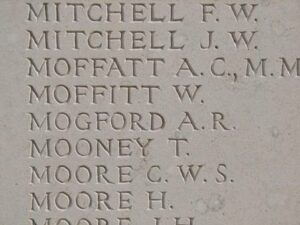
Thomas Harry Moremon, Private, 7/45049, South Wales Borderers. Thomas was the son of Joseph and Eliza Moremon, of 39, New Dock Road, Llanelli. He enlisted at Carmarthen into the 7th Battalion, South Wales Borderers, which was attached to 67 Brigade, 22nd Division. The Division crossed to France in early September 1915, but on 27 October 1915 embarked from Marseilles for Salonika. Thomas was killed at Salonika on 7 November 1917. He was 23 years old, and is buried at Doiran Military Cemetery, Greece.
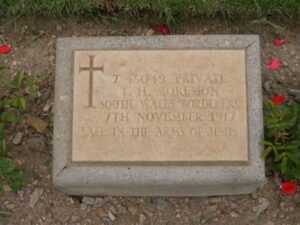
Daniel Ivor Morgan, Able Seaman, Z/3531, Royal Navy. Daniel was born on 1 May 1895, the son of Evan and Mary Hannah Morgan, of 41, Marble Hall Road, Llanelli. He served with the Royal Navy aboard the SS Hermes. Daniel is shown as being missing presumed drowned when Hermes was lost at sea on 28 April 1917. He was 22 years old, and is commemorated on the Plymouth Naval Memorial, Devon.
David John Morgan, Gunner, W/2187, Royal Field Artillery. David was the son of Thomas and Hannah Morgan, of Gwynfryn, Dafen. He enlisted at Carmarthen into the Royal Field Artillery, and was posted to their D Battery, 119th Brigade, which was attached to the 24th Division. They moved to France during August, 1915 and marched to positions near Loos, where they took up reserve positions for the main Battle of Loos. The Division was sent into battle on 26 September 1915 at Loos and suffered terrible casualties. In 1916 it took part in the Battle of the Somme, before moving north of Arras in early 1917. In April and May 1917 the division fought at the Battle of Vimy, alongside the Canadian Corps, and in June they moved to positions south of Ypres, and fought during the Battle of Messines. After the successful capture of Messines Ridge, the Division moved further north, and fought at the Battles of Pilckem and Langemarck during Third Ypres. The Division then moved to positions north of St. Quentin over the winter of 1917/18, and was here when the German Spring Offensive was launched on 21 March 1918, defending the Village of Le Verguier, before retreating back. It was moved north to Flanders to rest, but was hit by the German offensive on the Lys, taking part in the Battle of Kemmel. The Division rested for a period after this, and took part in the final offensives of the war, at the Battle of Cambrai, and the Pursuit to the Selle. David was wounded here, and died soon after on 12 September 1918. He was 30 years old, and is buried at Arneke British Cemetery, France.
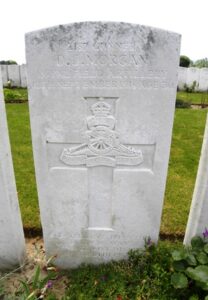
David John Morgan, Lance Corporal, 20793, Welsh Regiment. David was the son of Hugh Morgan, of the Old Castle Works, Llanelli. He enlisted at Llanelli into the 15th Battalion, Welsh Regiment, which was known as the Carmarthen Pals, and was attached to 114 Brigade, 38th (Welsh) Division. David landed in France with the Battalion on 2 December 1915, and saw action at Fleurbaix with them, before the 38th Division marched to the Somme in June 1916. He was probably wounded during the Divisions assault on Mametz Wood between 7 and 11 July 1916, and evacuated to hospital in Britain for treatment. David died of his wounds at the King George Hospital on 27 July 1916, aged 30, and is buried at Box Cemetery, Llanelli. The headstone also commemorates his father who drowned at sea on 1 July 1914.
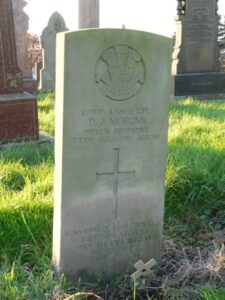
David John Morgan, Private, 44842, Welsh Regiment. David was the Stepson of Mrs. David Morgan, of Pwll, Kidwelly. He enlisted at Llanelli into the Welsh Regiment, and was posted to the 18th Battalion, Welsh Regiment, which was a Bantam Battalion, attached to 119 Brigade, 40th (Bantam) Division. The Division moved to France during June 1916, and moved to the front near Loos. Late in 1916 they moved south to the Somme, and fought at the Battle of the Ancre, and remained in the area over the winter. In March 1917 the Germans withdrew to their shortened line, called the Hindenburg Line, and the 40th Division was one of the Divisions that followed the withdrawal. Later in the year they took part in the Battle of Cambrai, playing an important role in the attack on Bourlon Wood. David was killed at Cambrai on 23 November 1917. He was 30 years old, and is commemorated on the Cambrai Memorial, Louverval, France.
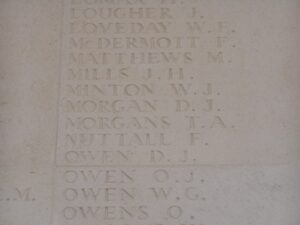
David Reginald Morgan, Private, 20581, Welsh Regiment. David was the son of Daniel and Eliza Ann Morgan, of 4, Woodend Road, Llanelli. He enlisted at Llanelli into the 15th Battalion, Welsh Regiment, which was known as the Carmarthen Pals, and was attached to 114 Brigade, 38th (Welsh) Division. David landed in France with the battalion on 2 December 1915, and moved to positions at Fleurbaix, where the Welshmen were initiated into trench warfare. The 38th Division then took the line at Pont Du Hem, and it was here that David was killed, when the 15th Welsh sent a Platoon to reinforce the 14th Welsh on 9 May 1916. David was just 19 years old, and is buried at Cambrin Churchyard Extension, France.
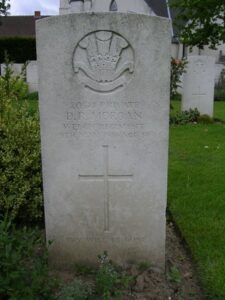
Eric Morgan, Private, Royal Welsh Fusiliers. This man cannot presently be identified, but a photograph of him was printed in the Llanelli Guardian.
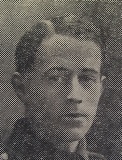
Gilbert Bowen Morgan, Private, 20621, Welsh Regiment. Gilbert was the son of Matthew and Margaret Morgan, of Green’s Farm, Merlin’s Bridge, Haverfordwest. He enlisted at Llanelli into the 15th (Service) Battalion of the Welsh Regiment, which was raised as the Carmarthen Pals Battalion, as part of Kitchener’s New Army in 1914. In 1915 the Battalion became part of 114 Brigade, 38th (Welsh) Division, and moved to the Western Front in December 1915, taking up positions near Fleurbaix. They fought with distinction at Mametz Wood the following year, and in 1917 played a major part in the capture of the Pilckem Ridge during Third Ypres. They were rushed to the Somme in spring 1918 to help stem the German push towards Amiens, and then took part in the great offensive of August, 1918, where they forded the flooded River Ancre on the night of 22 August 1918 which began the great drive to victory. The Division pushed steadily through Poziéres and Longueval, capturing the village of Morval before pushing on to Sailly Saillisel, which is where Gilbert was killed on 4 September 1918. He was 26 years old, and is buried at Sailly-Saillisel British Cemetery.
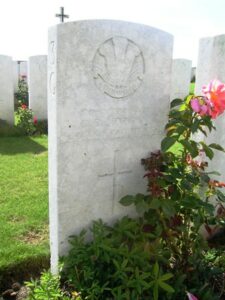
Joseph John Morgan, Stoker, K/45146, Royal Navy. Joseph was born on 19 May 1891, the son of Joseph and Ann Morgan, of 75, Bryn Road, Llanelli, and was the husband of Elizabeth Morgan. He served with the Royal Navy aboard HMS Tornado, and lost his life when she was sunk by a German submarine off the Maas Lightship on 23 December 1917. Joseph was 26 years old, and is commemorated on the Plymouth Naval Memorial, Devon.
Joseph Owen Morgan, Private, 60697, Royal Welsh Fusiliers. Joseph was the son of John and Mary Morgan, of 22, Mountain Rd., Llanllechid, Bangor. He probably worked at Llanelli prior to the war, and enlisted there into the army. Joseph was posted to France, where he joined the 16th Battalion, Royal Welsh Fusiliers, which was attached to 113 Brigade, 38th (Welsh) Division. He would have joined the battalion after its move from the Somme to Boesinghe in 1916, and took part in the Divisions famous attack on the Pilckem Ridge on 31 July 1917. Joseph was killed soon after, on 2 August 1917. He was 23 years old, and is buried at New Irish Farm Cemetery, Belgium.
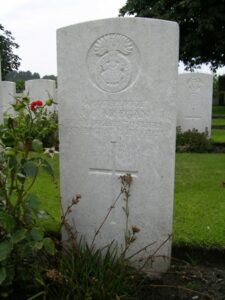
Thomas Morgan, Private, 45060, South Wales Borderers. Thomas was the son of Jonathan and Maria Morgan, of 157, Old Castle Road, Llanelli. He had enlisted at Carmarthen into the 7th Battalion, South Wales Borderers, which was attached to 67 Brigade, 22nd Division. The Division moved to France in September 1915, but the following month entrained for Marseilles, where it embarked for Salonika. It remained there for the duration of the war. Thomas was wounded in Salonika, and died as a result on 6 February 1918, aged 26. He is buried at Sarigol Military Cemetery, Kriston, Greece.
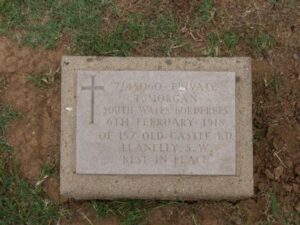
Albert Edward Morris, Sergeant, 11661, Royal Welsh Fusiliers. Albert was the son of William and Honora Morris, of 1, North Terrace, Dafen, Llanelli. He enlisted at Llanelli on 14 August 1914 into the 8th Battalion, Royal Welsh Fusiliers, which was attached to 40 Brigade, 13th (Western) Division. On 13 June 1915 the Division sailed for Alexandria, and moved to Mudros before being landed at Cape Helles, Gallipoli from 6 July 1915, relieving the 29th Division. On 8 January 1916, the Division was evacuated from Helles, and by 31 January was concentrated at Port Said, where they held forward posts in the Suez Canal defences. On 12 February, 1916 the Division began to move to Mesopotamia, to strengthen the force being assembled for the relief of the besieged garrison at Kut al Amara. Albert was killed here during the Battles of the Hanna and Fallahiyeh, on 5 April 1916. He was 28 years old, and is commemorated on the Basra Memorial, Iraq.
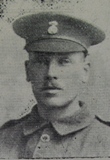
Benjamin John Morris, Private, 20420, Essex Regiment. Benjamin was the son of William Morris, of 1, Bridge Street, Llanelli. He enlisted at Llanelli into the army, and was posted to the 1st Battalion, Essex Regiment, which was attached to 88 Brigade, 29th Division. The Division moved to Gallipoli via Egypt, landing on 25 April 1915. They remained here over the coming months, suffering heavy casualties. Benjamin took ill during the terrible winter at Gallipoli, and died of exposure on 29 November 1915. He was 21 years old, and is buried at Azmak Cemetery, Suvla, Gallipoli.
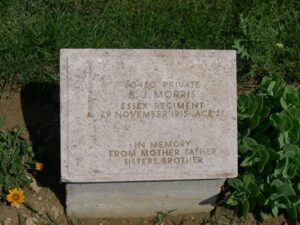
Cornelius Morris, Private, 242743, South Lancashire Regiment. Cornelius was the son of John and Elizabeth Morris, of 29 Ralph Terrace, Llanelli. He served with the 2/5th Battalion, South Lancashire Regiment, which was attached to 172 Brigade, 57th (2nd West Lancs) Division. The Division moved to France between 7 and 22 February 1917, and moved to positions near Ypres, where they took part in the Second Battle of Passchendaele. In 1918 they took part in the 1918 Battle of the Scarpe, and at the Battle of Drocourt-Queant. They fought on the Hindenburg Line during the Battle of the Canal du Nord, and at the Battle of Cambrai, where the Division helped capture Cambrai itself. Cornelius was killed during the final advance in Flanders, on 22 October 1918. He was 21 years old, and is buried at Tournai Communal Cemetery, Allied Extension, Belgium.
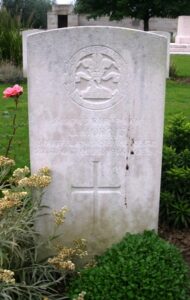
David Morris, Private, 21008, Welsh Regiment. David was born in Carmarthen in about 1882, the son of Benjamin Morris. He came to Llanelli as a young man and found work at the Old Castle Tinplate Works, as a pickler. David married Sarah Thomas on 19 December 1908 and the couple set up home at 2, Andrew Terrace, Llanelli. David enlisted into the 15th Battalion, Welsh Regiment during a recruitment march in the town in the spring of 1915 and joined the battalion at Rhyl, where it was attached to the 43rd (Welsh) Division. The division later became renumbered to the 38th (Welsh) Division, before moving to Morn Hill Camp, Winchester to complete its training. On 2 December 1915 the division began moving to France, and moved to the Fleurbaix sector, where it was initiated into trench warfare. During June 1916 the Division marched south to the Somme, and on 7 July 1916 attacked Mametz Wood. The initial attack failed, and it was three days later, on 10 July, that a fresh attack was mounted. After two days of heavy hand to hand fighting within the wood, the Germans withdrew, and the battered Welshmen moved to Hébuterne, where it remained for almost a month. David came home on leave about this time and upon his return to France was posted to the 18th Battalion (2nd Glamorgan), Welsh Regiment, which was attached to 119 Brigade, 40th (Bantam) Division. The Division had moved to France between the 1st and 9th June 1916, and moved to the front near Loos. Later that year the division moved south to the Somme, and fought at the Battle of the Ancre, remaining in the area over the winter. In March, 1917 the Germans withdrew to their shortened line, called the Hindenburg Line, and the 40th Division was one of the Divisions that followed the withdrawal. David was wounded during the following advance, and evacuated to the Base Hospital at Rouen, where he died of his wounds on 23 April 1917, aged 35. He is buried in St. Sever Cemetery Extension, Rouen, France, in Grave O. IX. B. 2.
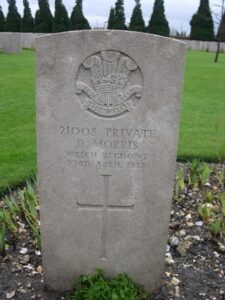
Edgar Morris, Private, 44840, Welsh Regiment. Edgar was born at St. Peter’s, Monmouth, and was the Brother of Mrs. M. J. Winstoul, of 17, Isaf Rd. Pontymister, Risca, Newport, Monmouthshire. He probably worked at Llanelli prior to the war, and enlisted there into the army. Edgar was posted to France, where he joined the 2nd Battalion, Welsh Regiment, which was attached to 3 Brigade, 1st Division. Edgar probably joined the battalion after its exploits at Loos in September 1915. He was killed on the Somme, during the Battle of Guillemont, on 8 September 1916. Edgar was 30 years old, and is buried at London Cemetery & Extension, Longueval, France.
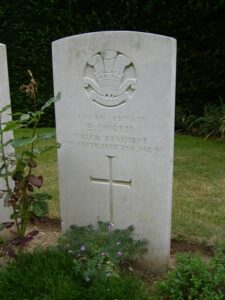
John Thomas Morris, Private, 648321, London Regiment. John was born at Llangeler, near Newcastle Emlyn, the son of John and Elizabeth Morris. The family later moved to 48, Gilbert Place, Llanelli. He originally served with the Welsh Horse Yeomanry, number 187 and served in Gallipoli from 8 October 1915. He transferred after March 1917 into the 6th Battalion, London Regiment, number 324853, before being transferred into the 20th Battalion (Blackheath and Woolwich), London Regiment, number 648321, which was attached to 141 Brigade, 47th (2nd London) Division. The Division was served in France from 1915 and early in 1917 the Division moved north to Belgium, and took part in the Battle of Messines, and then in November 1917 fought at the Battle of Cambrai. The Division remained in the Cambrai sector over the winter, and on 21 March 1918 was caught up in desperate fighting during the German Spring Offensive on the Somme. John was killed in action, his death being presumed on 24 March 1918, aged 26, and is buried at Sailly-Saillisel British Cemetery, France.
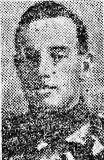
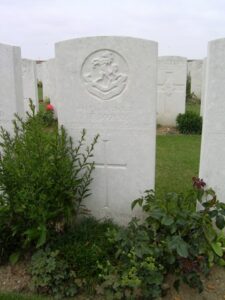
Joseph Henry Morris, Stoker, K/45194, Royal Navy. Joseph was born on 24 June 1892, the son of Henry and Mary Ann Morris, of 40, Gellyden, Capel, Llanelli. He served in the Royal Navy aboard HM Drifter Clover Bank. Joseph was drowned when his ship was lost at sea on 15 February 1918. He was 26 years old, and is commemorated on the Plymouth Naval Memorial, Devon.
Oswald Morris, Private, 13847, Welsh Regiment. Oswald was the son of William and Gertrude Morris, of Leominster. He probably worked at Llanelli prior to the war, and enlisted there into the 8th Battalion, Welsh Regiment, which was the Pioneer battalion to the 13th (Western) Division. On 13 June 1915 the Division sailed for Alexandria, and moved to Mudros before being landed at Cape Helles, Gallipoli from 6 July 1915, relieving the 29th Division. Oswald was killed here on 7 August 1915, aged 20. He is commemorated on the Helles Memorial, Gallipoli.
William Richards Morris, Private, 293147, Royal Welsh Fusiliers. William was the son of James and Mary Morris, of 15, Wern Road, Llanelli. He enlisted at Llanelli on 3 June 1915 into the 3/4th Battalion, Welsh Regiment, and sailed for Gallipoli in September, joining the 1/4th Welsh. William was evacuated from Gallipoli with dysentery in November 1915, and returned to Britain. He remained on home service until 13 February 1917, when he sailed for the Mediterranean, joining the 7th Battalion, Royal Welsh Fusiliers, which was attached to the 53rd (Welsh) Division. William saw action in Syria with the division, before taking ill with dysentery, and died in hospital on 2 December 1918, aged 23. He is buried at Alexandria (Hadra) War Memorial Cemetery, Egypt.
E. Morse, Private, South Wales Borderers. This man cannot presently be identified.
David Muckart, Corporal, 190, Welsh Horse. David was the son of David and Margaret Pattullo Muckart, of Tarryburn House, St. Vigeans, Arbroath, Forfarshire. He worked at the Llanelli Electric Light Company prior to the war, and enlisted at Cardiff into the Welsh Horse Yeomanry. David served at Gallipoli with the Welsh Horse, which was attached to the 1st Mounted Division, 54th (East Anglia) Division, and was a specialist machine-gunner. David was wounded at Gallipoli, and died in hospital on 14 November 1915, aged 28. He is buried at Alexandria (Chatby) Military Cemetery, Egypt.
Edward Murphy, Private, 3877, Border Regiment. Edward was originally from Workington, and was the husband of Margaretta Murphy, of 51, Cambrian Street, Llanelli. He was a reservist, and was called up at the outbreak of war. He had served in France before being wounded, and after recovering joined the 1st Battalion, Border Regiment, which was attached to 87 Brigade, 29th Division, and was at Gallipoli. Edward was wounded for the second time while at Gallipoli, and was brought back to England, where he died at Netley Military Hospital on 1 November 1915. He was 27 years old, and is buried at Llanelli (Old Road) Church Cemetery.
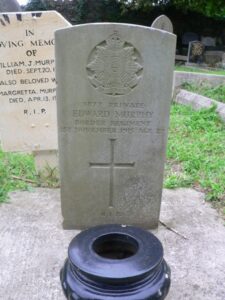
John Patrick Murphy, Private, 6787, Connaught Rangers. John was born at Boyle, Co. Roscommon. He worked at Llanelli prior to the war, and enlisted there into the army. John was posted to France with the 6th Battalion, Connaught Rangers, which was attached to 47 Brigade, 16th (Irish) Division. During December, 1915 the Division moved to France and concentrated in the Bethune area. They saw their first major action during the Somme Offensive, at the Battle of Guillemont. John was killed here on 3 September 1916, and is commemorated on the Thiepval Memorial, France.
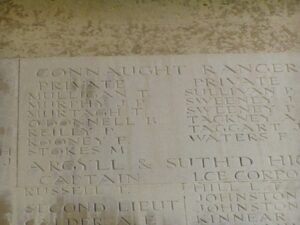
Brinley Newman, Private, 44959, South Wales Borderers. Brinley was the son of Charles and Margaret Newman, of 8, Christopher Street, Llanelli. He enlisted there into the 7th Battalion, South Wales Borderers. The battalion was attached to 67 Brigade, 22nd Division, and crossed to France in early September 1915, before embarking at Marseilles for Salonika on 27 October 1915. Brinley was killed in Salonika during the Battle of Doiran, on 18 September 1918, aged 22. He is commemorated on the Doiran Memorial, Greece.
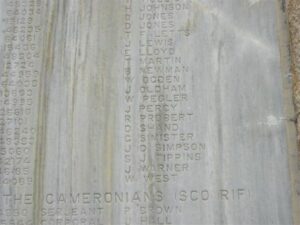
James Nicholas, Lieutenant, 6816, Royal Army Medical Corps. James was born at Narberth in 1872, the son of Thomas and Mary Nicholas. The family had moved to 21, Cwm Felin, Llanelli prior to 1881. James served with the Royal Army Medical Corps during the war. He died in hospital in London on 6 January 1917, aged 45, and is buried at Hanwell Cemetery, Westminster.
Walter John Nicholas, Rifleman, 13318, Royal Irish Rifles. Walter was the son of John and Catherine Nicholas, of 30, Custom House Bank, Sea Side, Llanelli. He enlisted at Llanelli into the army, and was posted to France with the 2nd Battalion, Royal Irish Rifles, which was attached to 74 Brigade, 25th Division. Walter was bringing in some German prisoners near Ypres on 19 January 1916, when the group was hit by a shell, killing Walter, and wounding his comrade, Private Donovan. Donovan managed to get back to the Irish lines with the surviving prisoners, who carried Walter’s body with them. He was 19 years old, and is buried at Tancrez Farm Cemetery, Belgium.
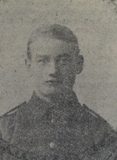
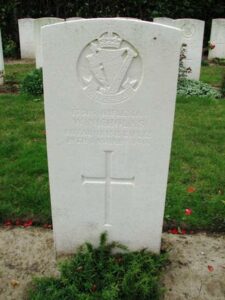
Ernest Percy Northcote, Private, 3300, Welsh Regiment. Ernest was the son of John George and Ellen Northcote, of 65, Monterey Street, Manselton, Swansea. He lived at Llanelli prior to the war, working for the GWR, and enlisted at Swansea into the 6th Battalion, Welsh Regiment. On 29 October 1914 the battalion landed at Havre, and after several months on Lines of Communication joined 84 Brigade, 28th Division, before transferring to the 1st Division, where they became the Pioneer battalion. The Division took part in the Somme Offensive soon after, and it was here, during the Battle of Bazentin Ridge, that Ernest was killed on 20 July 1916. He was 20 years old, and is buried at Flatiron Copse Cemetery, Mametz, France.
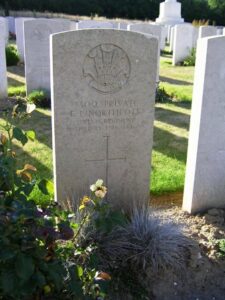
William Nunian, Private, 535001, London Regiment. William was the son of John and Margaret Nunian, of 31, Swansea Road, Llanelli, and enlisted at Hamstead into the 15th Battalion (Civil Service Rifles), London Regiment. He was later posted to the 1st/12th Battalion, London Regiment (The Rangers), attached to 168 Brigade, 56th Division. The Division fought at the diversionary attack on Gommecourt then at Ginchy, Flers and Morval, where they captured Combles. They wintered on the Somme, and followed the German retreat to the Hindenburg Line in March 1917 before fighting in the Battle of Arras. They then moved to Ypres, where they fought at Langemarck. In October they moved south, and fought at the Battle of Cambrai, which is where William was killed on 27 November 1917. He was 19 years old, and is remembered on the Cambrai Memorial, Louverval, France. He is also remembered on his parent’s grave at Box Cemetery, Llanelli.
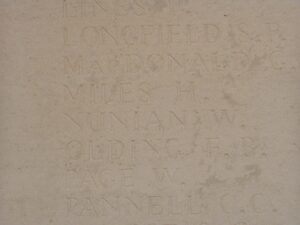
Frank O’Brien, Private, 139956, Machine Gun Corps. Frank was the son of John and Annie O’Brien, of 23, Pottery Street, Llanelli. He enlisted at Llanelli into the 4th Welsh reserves, and was sent to France, where he joined the 38th Battalion, Machine Gun Corps, which was attached to the 38th (Welsh) Division. The Division had been in France since December 1915, and had famously captured Mametz Wood the following year. In July 1917 they captured Pilckem Ridge, and after wintering at Armentieres, moved back to the Somme in April 1918, taking up positions North of Albert, from where they weathered the storm of the coming months, until the war turned during the Battle of Amiens, on 8 August, 1918. The Germans had now lost the upper hand, and the British regained the lost ground on the Somme after an attack which began on 21 August, with the 38th Welsh driving forward over the old Somme battlefields. Then the move began towards the mighty Hindenburg Line, and the Division carried on with their march east, fighting at Havrincourt, and Epehy. A short rest period ensued, during which time the Canal du Nord was breached, so opening a passage through the Hindenburg Line. The Division then pushed up towards Le Cateau, capturing Villers-Outreaux. Frank was killed here on 8 October 1918. He was 23 years old, and is buried at Prospect Hill Cemetery, Gouy, France.
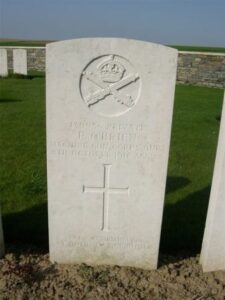
John O’Brien, Sergeant, 12253, Welsh Regiment. John was born at Cork. He resided at Llanelli prior to the war with his wife Edith. John enlisted at Cardiff into the 8th Battalion, Welsh Regiment, which was the Pioneer battalion to the 13th (Western) Division. On 13 June 1915 the Division sailed for Alexandria, and moved to Mudros before being landed at Cape Helles, Gallipoli from 6 July 1915, relieving the 29th Division. John was killed at Gallipoli during the Battle of Sari Bair, on 8 August 1915. He was 37 years old, and is commemorated on the Helles Memorial, Gallipoli.
John O’Brien, Lance Corporal, 1928, Welsh Regiment. John was born at Cork, and after several years in the army, moved to Llanelli. As a reservist, he was called up at the outbreak of war, and went to France with the 2nd Battalion, Welsh Regiment, which was attached to 3 Brigade, 1st Division. The Division had been one of the first to arrive in France, fighting at the Battle of Mons, and taking part in the retreat to the Marne, where the Germans were stopped. They then fought at the Aisne, and at Chivy, before being moved north to Ypres. Here they fought at the First Battle of Ypres, where they again stopped the German Offensive, before wintering in Flanders. The following year saw them in action again at the Battle of Aubers Ridge. John was wounded near Richebourg, and died on 28 May 1915. He is buried at Wimereux Communal Cemetery, France.
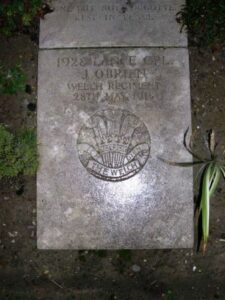
Patrick O’Grady, Private, 6631, Royal Munster Fusiliers. Patrick was born in Limerick, and resided at Llanelli prior to the war. He enlisted there into the army, and was posted to the 2nd Battalion, Royal Munster Fusiliers, which was attached to 3 Brigade, 1st Division. The Division had been one of the first to arrive in France, fighting at the Battle of Mons, and taking part in the retreat to the Marne, where the Germans were stopped. They then fought at the Aisne, and at Chivy, before being moved north to Ypres. Here they fought at the First Battle of Ypres, where they again stopped the German Offensive, before wintering in Flanders. The following year saw them in action again at the Battle of Aubers, before moving South to Loos, where they fought during the Battle of Loos. Patrick was killed at Loos on 29 April 1916, and is buried at St. Patrick’s Cemetery, Loos, France.
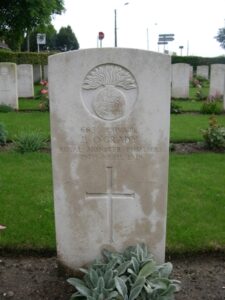
Patrick Joseph O’Keeffe, Private, 16322, Royal Irish Regiment. Patrick was the son of John and Mary Ann O’Keeffe, of 54, Phillip Street, Swansea. He resided at Llanelli prior to the war, and enlisted at Cardiff into the Royal Dublin Fusiliers, and was posted to France where he joined the 2nd Battalion, Royal Irish regiment, which was attached to 49 Brigade, 16th (Irish) Division. During December 1915 the Division moved to France, and saw their first major action during the Somme Offensive, at the Battle of Guillemont, and at Ginchy. By May 1917 the Division had moved to positions south of Ypres, where they fought at the Battle of Messines, and then the Battle of Langemarck. At the beginning of 1917 the Division was stationed near St. Quentin. They were hit here by the German Spring Offensive of 21 March 1918 and took part in the Battle of St Quentin, and then at the Battle of Rosieres. On 18 June 1918, after suffering very heavy casualties, the Division returned to England for refit, before returning to France on 1 August 1918. Here they fought through the Final Advance in Artois. Patrick was killed here on 3 September 1918, aged 20. He is buried at Queant Road Cemetery, Buissy, France.
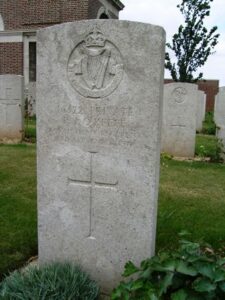
H. Oddy, Private. This man cannot presently be identified.
David Owen, Trimmer, Mercantile Marine Reserve. David was the son of Joseph and Mary Owen, of 20, Bryn Terrace, Seaside, Llanelli. He was a member of the Mercantile Marine Reserve and following the outbreak of war was posted to HMS Cormorant before becoming a crewman aboard H.M. Tug Anchor. David took ill whilst Anchor was stationed at Gibraltar in the last months of the war and died there of pneumonia on 7 September 1918. He is buried in North Front Cemetery, Gibraltar.
David John Owen, Private, 54262, Welsh Regiment. David was the son of Joseph and Catherine Owen, of 3, Dark Gate, Water Street, Llanelli. He enlisted at Llanelli into the army, and was posted to France in 1917 where he joined the 9th Battalion, Welsh Regiment, which was attached to 58 Brigade, 19th (Western) Division. The Division moved to France during July 1915, and took part in the opening attack of the Battle of Loos on 25 September 1915. The following year the Division moved to the Somme, where it took part in the second wave of the attack on Ovillers-La Boiselle on 1 July, capturing the village at heavy cost. In 1917 the Division moved north to Ypres, taking part in the Battle of Messines, then in the later Battle of Passchendale. In 1918 they were caught up in the German Spring Offensive near St. Quentin, where they suffered terrible casualties, and fought at the Battle of Bapaume. They moved to Ypres, but were caught up in the German attack at Messines, and at Bailleul, and Kemmel. After suffering terribly again, they moved South to the quieter French sector to rebuild, but were caught up in the German offensive on the Aisne. David was wounded here, and died on 31 May 1918, aged 22. He is buried at Terlincthun British Cemetery, Wimille, France.
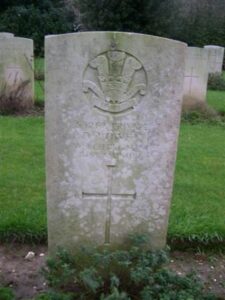
Frank Owen, Driver, 9677, Royal Field Artillery. Frank was the son of William and Margaret Owen, of 21, Emma Street, Llanelli. He enlisted at Llanelli into the Royal Field Artillery, and served in France with an unknown battery from 9 July 1915. Frank was wounded during the Battle of the Lys, and died on 15 July 1918, aged 33. He is buried at Mont Huon Military Cemetery, Le Treport, France.
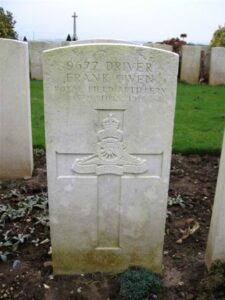
Griffith Owen, Private, 20086, Welsh Regiment. Griffith sas the son of Richard and Mary Owen, of 6, Bigyn Road, Llanelli. He enlisted at Llanelli in February 1915 into the 15th Battalion, Welsh Regiment, which was known as the Carmarthen Pals battalion, attached to 114 Brigade, 38th (Welsh) Division. On 2 December 1915 the battalion moved to France, and the entire Division moved to the Fleurbaix sector, where it was initiated into trench warfare. During June 1916 the Division marched south to the Somme, and on 7 July 1916 attacked Mametz Wood. The initial attack failed, and it was three days later, on 10 July, that a fresh attack was mounted. After two days of heavy hand to hand fighting within the wood, the Germans withdrew, and the battered Welshmen moved via Hebuterne to Boesinghe, on the Yser Canal, where it remained until launching its attack on Pilckem Ridge on 31 July 1917. Griffith was wounded that day, and died just hours later. He was 34 years old, and is buried at Essex Farm Cemetery, Belgium.
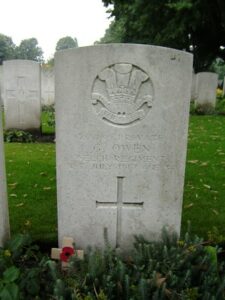
Thomas Myrddin Owen, Ordinary Seaman, Z/5277, Royal Navy. Thomas was born at Swansea on 8 November 1900, the son of John and Elizabeth Owen. The family had moved to Queen Victoria Street, Llanelli prior to the war, and Thomas enlisted into the Royal Navy. He was based at the Royal Naval Depot at Crystal Palace when he took ill and died on 9 October 1918, aged 17. Thomas is buried at Box Cemetery, Llanelli.
W. Owen, Private. This man cannot presently be identified.